




- Multi-process welder that delivers high quality welds thanks to Touch Sense Ignition
- Uses energy-efficient inverter technology
- Fast setup with Weld Assist
- Effortless operation
- Excellent welding ergonomics
- Robust and made in Finland
- Cobot and industry 4.0 ready
- Modular design for tailoring to your needs
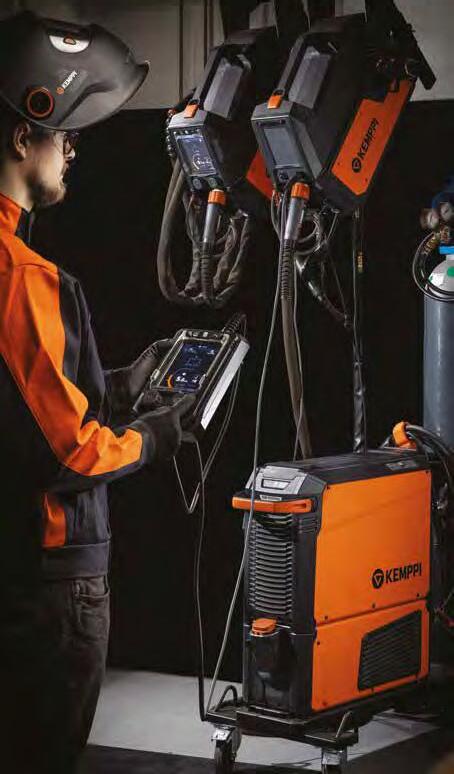


Don’t gamble with an open type laser



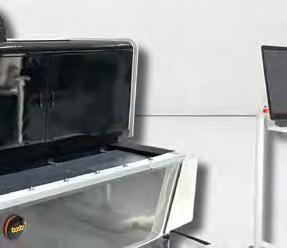












14 INDUSTRY 5.0
Industry’s next frontier is here. Not only overseeing robots –but collaborating with them.
24 YOUR BUSINESS
Collaboration, safety, cybersecurity, compliance and future planning – industry specialists offer their thoughts.
46 ON THE TOOLS
The tools taking Australian manufacturing into the future.

70 SUSTAINABILITY
With the right power and sustainability solutions, Australian manufacturing is charging ahead.
8 From the CEO
From the Minister
82 MEDICAL
Wearable technologies take medical solutions to a new level.
For story leads, sales enquiries or any other feedback related to AMT, contact AMTMagazine@amtil.com.au
Publisher AMT Magazine
AMTIL
Suite 10, 5 Corporate Boulevard Bayswater VIC 3153
AUSTRALIA
T 03 9800 3666
E info@amtil.com.au
W amtil.com.au
Prepress & Print
Printgraphics Australia
AMT Magazine is printed in Australia under ISO140001
Environmental Certification using FSC® Mix certified paper sourced using sustainable tree farming practices.
Copyright © Australian Manufacturing Technology (AMT). All rights reserved. AMT Magazine may not be copied or reproduced in whole or part thereof without written permission from the publisher. Contained specifications and claims are those supplied by the manufacturer (contributor).
Disclaimer
The opinions expressed within AMT Magazine from editorial staff, contributors or advertisers are not necessarily those of AMTIL. The publisher reserves the right to amend the listed editorial features published in the AMT Magazine Media Kit for content or production purposes.
AMT Magazine is dedicated to Australia’s machining, tooling and sheet-metal working industries and is published four times per year. Subscription to AMT Magazine (and other benefits) is available upon application.Contact AMTIL on 03 9800 3666 for further information.
1972AMTV25.N4OCTOBER

The next generation GENOS M460V-5AX and M560V-5AX, 5-axis vertical machining centers made in Japan, are specifically designed to manufacture high-precision parts and deliver impressive metal removal rates in a compact design. Its solid double-column structure, full 5-axis simultaneous control, and thermal stability performance give it the ability to easily cut a variety of materials.



• Fully equipped 5-axis simultaneous machine at an affordable price
• Double column structural design
• Ergonomic design reduces operator burden
• Automation-friendly integration
• Now with Okuma OSP-P500 Control
• 50% More Tools – Now with 48 tools for production flexibility
• Dual in machine Coil Chip Conveyors – Enhanced Chip Evacuation
• OSP Suite – Features you want with pre-loaded apps
• Massive Trunnion- Superior accuracy and machining capabilities
Machines Available Now:
Genos M560V-5AX & Genos M460V-5AX
Ex stock Melbourne*
Thermo-Friendly Concept 5-Axis Auto Tuning System SERVONAVI® *Subject to prior sale
Amidst the recent national productivity discussions, AMTIL hosted 40 organisations at the National Press Club in Canberra to have a ‘deep dive’ discission on the largest skills gap for the precision manufacturing sector: Computer Numerically Controlled (CNC) machine operators.
Officially titled the 2025 National Manufacturing Technology Skills Summit, the invitation-only gathering brought together key stakeholders from government, academia, industry associations and industry to address one very specific skills need for the current and immediate-future skills needs of the Australian manufacturing technology workforce.
While there are many areas of skills shortage in manufacturing and an inadequate number of people entering trade apprenticeships, ask anyone who works with machine tools and they’ll tell you the greatest need is CNC operators. Industry experts say it has been so for decades. AMTIL estimates that the shortage currently sits at more than 1,000 roles and to meet future needs, we will need to attract and train more than 3,000 people over the next two years.
The Summit differed from others with its specificity to a defined skill set and its collaborative approach. As there are so many areas of shortage in the sector, it is easy to be broad, but also and importantly, it’s hard to know if our work collectively is making a difference and closing skills gaps. Most machinery has moved toward being driven by computers that are programmed by highly-skilled tradespersons, often called programmers, and the machine is operated by a mix of semi-skilled (non- tradesperson) and highly-skilled (tradesperson) operators.
Australia is experiencing significant transformations in its economic and technological landscape, leading to evolving skills requirements across various sectors, manufacturing wondering what impact AI will bring and lamenting the automation that might change the playing field. And yet here we are, year after year, calling out for more CNC operators, more apprentices, more tradespeople, more…
Many Australian manufacturers, especially the smaller businesses, excel in niche production fields or act as critical suppliers within larger value chains. This diversity not only underscores the sector’s adaptability but also its importance as a source of high-skilled, high-paying jobs that span both urban and regional areas.
Skills are in shortage, but jobs are not, and we are in competition for skills not with each other but other industries. The stereotype of past manufacturing has irrevocably changed, as many don’t have a touch point to know that large production lines and commoditised manufacturing are in the decline, and instead high valueadd, small run, high tech, clean automated and digitised manufacturing is the new norm.
Over the decades, the role of manufacturing in Australia’s economy has shifted. For instance, while manufacturing once contributed approximately 11% to GDP back in 1990, its share has reduced to around 5.9% by 2024, as other sectors, notably services and mining, experienced faster growth. Traditionally, manufacturing had a larger share of the national output, but over the decades the economy has shifted increasingly toward services, health, education and other sectors.
Nonetheless, manufacturing in Australia is acknowledged as one of the country’s key industries. According to one fact file, it is the nation’s seventh largest employer, providing approximately 873,000 jobs and making up about 6.8% of all employment.
The sector is not only crucial for domestic economic activity – it also plays a major role in Australia’s international trade, generating roughly $ 117 billion in export earnings (about 11% of annual exports) and accounting for 26.9% of the nation’s total export earnings.
At the core of our discussion lies the transformative power of technology. Advances in robotics, artificial intelligence, additive manufacturing and smart sensors are reshaping every facet of production. The advent of Industry 4.0 isn’t merely about digitising existing operations; it represents a fundamental shift—a convergence of data analytics and precision machinery that creates hyper efficient, self monitoring production lines.
Importantly, the transformation does not negate or diminish our need for people and their skills! We estimate that literally hundreds of organisations around the country are working on part of this situation and skills shortages and/or are deeply concerned about it.
It is acknowledged that the attention to CNC operators is a short-term (and possibly temporary solution) and there are many medium and long-term approaches that are required. It is noted that one would expect that these semi-skilled operators, once ready for work, would naturally be eligible and attractive for pathways to apprenticeships. By developing a joint and specific strategy and work plan, we can each achieve a ‘line of sight’ to our collective impact across the sector.
Special thanks goes to the participating organisations, notably the Victorian Skills Authority, for facilitating the day’s discussion.
Keep an eye out for the Summit report, which will capture key findings and recommendations, thus forming the start of the action plan.


One of Australia’s leading high-end, high speed fiber lasers. World class componentry and build quality, whilst still offering excellent value for money. 3kW-40kW, wide range of sheet capacities and automation options available.

PBH Series CNC Pressbrakes.
Simply put, one of Australia’s favourite CNC pressbrakes. Precision manufacturing and high end components with hydraulic crowning compensation. Available from 50 ton through to 3000 ton capacities.
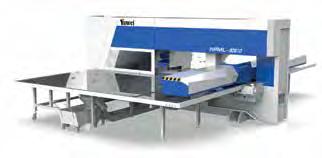
Combine the practicalities of a punch press for your forming needs, with the speed and accuracy of a laser for profile cutting of the same part. Tapping head and automation options available for your volume work.
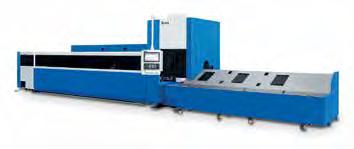
6m to 12m capacity with chuck sizes from 150mm to 600mm. Small profiles through to heavy structural profiles. Bevel cutting and automation options are available to suit your requirements.
Robotic Bending Cell.

Automate your repetitive pressbrake jobs with a smart bending cell from Yawei. Robots and accessories from Kuka, Yaskawa and Estun to suit all budgets and applications. Save time and money, whilst improving efficiencies.
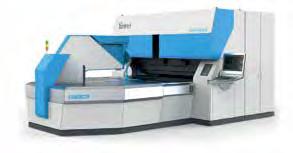
For maximum return and efficiencies, utilise the speed and precision of a Yawei CNC panel folder. With sheet capacities up to 3000mm and automation options available, there’s a Yawei panel folder to suit most applications.
With every Yawei machine you get the expert advice and support that only a local supplier like Applied Machinery can provide. With over 30 years’ experience, and thousands of satisfied customers across the country, we’re here for the long term. Real Service. Real Support. Real People. That’s Applied Thinking.
Call: Email: Visit: 03 9706 8066 sales@appliedmachinery.com.au appliedmachinery.com.au
Medical manufacturing can help drive a successful, resilient economic future in Australia.
Australians are world-leading innovators in medical manufacturing and medical technologies. Life changing diagnostic and treatment technologies such as the cochlear implant, greyscale ultrasound imaging and cervical cancer vaccines are all products of Australian ingenuity and research capability.
In our fast-moving, competitive and disrupted global economy, resting on the laurels of world leading research alone is not an option. Future innovations in medical technology and industry can, and should, be leveraged to advance Australia’s wider economic and strategic objectives in the coming years. That means providing the right support for local researchers and developers and encouraging the commercialisation and manufacturing of these innovations at scale, here at home. Thanks to earlier Labor governments, Australia enjoys the advantage of a world-class system of Cooperative Research Centres (CRC), providing innovators the time, space and industry linkages they need to succeed. In the field of health and wellbeing, CRCs have facilitated real, meaningful change for patients. Australian CRCs accelerated the adoption of cochlear technology, pioneered breakthrough research into cardiovascular conditions and developed new treatments to improve quality of life for asthmatics.
In April, the Albanese Government announced a new CRC focussed on Additive Manufacturing (AMCRC). This CRC, built on a $270 million investment from government, private sector and universities in partnership with one another, maximises the benefits of transformative 3D printing technology. For Australia’s medical manufacturing sector, that means greater precision and efficacy in the production of medical devices, personal protective equipment, implant technologies and other therapeutic manufactures. In that respect, the AMCRC is a good example of the ambition driving the Albanese Government’s Future Made in Australia agenda. I want Australia to discover, develop, commercialise and adopt new technologies that improve our national resilience. I want to see people in regional and outer-suburban Australia engaged in good, meaningful jobs, manufacturing the tools and technologies that arise from Australian innovation. I want to see Australian medical technology and bioengineering breakthroughs leading directly to improvements in Australian living standards and quality of life.
The Albanese Labor Government is using all of the levers at our disposal to help make that ambitious agenda a reality. Public investments under the Industry Growth Program (IGP), for example, are helping worthy recipients to advance and commercialise their innovations, crowding in the private sector capital that the advanced medical technology sector needs. More than 300 small and medium enterprises working in the medical science field have received zero-cost advisory services under the IGP, and 10 enterprises have received grants to accelerate the commercialisation and adoption of their innovations. For example, Incisive Technologies received $2.1 million to develop a dental ‘paint’ that can prevent or detect common oral diseases. EMVision received a $5 million grant for a ‘First Responder’ portable brain scanner that can

provide rapid diagnosis of traumatic brain injuries and strokes. If successful, Australians will benefit from these medical advancements and the manufacturing and service jobs that come with them. And if these projects don’t succeed as intended, our innovation ecosystem learns valuable lessons that help drive successful research and innovation forward. In our first term, the Albanese Government established the $15 billion National Reconstruction Fund, which will lead public investment in areas of critical importance to Australia’s domestic industrial and economic capabilities. Medical Science manufacturing is listed as one of the Fund’s seven priority areas for investment. This sends clear signals to private investors that Australia wants to enhance its own industrial capabilities in medical manufacturing and biotechnology. Australia’s economic success over the next few decades will depend on its ability to drive cutting-edge innovations all the way through the R&D pipeline from discovery to commercialisation, and good manufacturing jobs, at scale. Australian researchers are rightly renowned worldwide for their biomedical expertise. The Albanese Government’s policy strategy is designed to translate Australia’s medical research into Australian medical technology and biotechnology manufacturing in the interests of Australian researchers, firms, patients and communities.

SENATOR HON TIM AYRES Minister for Industry and Innovation and Minister for Science















Promising and challenging signs for Australian manufacturing amid an overall economic and productivity downturn, a new report reveals
A new report from the Australian Industry Group (AIGroup) says, “Metals and machinery and equipment grew strongly since the pandemic but have seen some of this growth ease in 2024 with more difficult economic conditions.”
According to the Manufacturing in Australia: Performance and Outlook Report 2025, produced by the AIGroup in July, manufacturer margins have been improving over the last decade in Australia, to return to near the all-industry level, “reflecting the consolidation toward more competitive subindustries.”
The report says that manufacturing is the only industrial sector to see a material improvement in business margins, with others still near long-term levels. It said post-pandemic growth saw manufacturer margins improve from 10% to 12% and now exceed the all-industry rate for the first time since 2007.
Investment levels in Australian manufacturing have also improved, with the report showing levels rose significantly following the pandemic, but growth levelled off in 2024.
“Industrial capex levels leaped following the pandemic, as businesses invested to meet growing demand from economic recovery and disrupted supply chains,” the report says.
“Manufacturing investment levels in 2023 were 55% higher than in 2019. Allied industrial sectors saw a similar degree of uplift. “As conditions deteriorated in 2024, manufacturing investment eased back by around 10%... however, capex levels remain structurally higher than the years before the pandemic.”
There was challenging news too, with the report noting four factors that have combined to put pressure on the manufacturing industry –productivity difficulties, skills shortages, trade risks and energy costs.
Australia’s manufacturing sector has taken a hit, contracting 2.6% over the last year after two years of growth following the COVID-19 pandemic. The report says overall productivity in manufacturing was 1% lower in 2023-24 than it was ten years prior – with labour productivity falling 3.7% over the same period, with a major fall during the pandemic.
This makes manufacturing one of only four industries –alongside construction, utilities and arts & recreation – to record productivity declines over the past decade, at a time when the nation’s overall productivity rose 4.7%.
AIGroup head of research and economics Jeffrey Wilson wrote in a research note that this was exacerbating the skills shortages, lowering the ability of employers to increase wages and reducing the financial resources available for employers to invest in research and development.
“It weakens our international competitiveness at the very time when trade disputes are putting our manufacturers under extra competitive pressure,” says Wilson.
Shortages of skilled labour mean 45% of advertised job vacancies go unfulfilled, the report says, with greater shortages remaining in technical and trades roles (61%) and professional roles (51%).

Further to this is a rise of manufacturer input prices by 37.5% in the five years since the end of the COVID-19 pandemic, due in part to rising gas prices. This outpaced the growth of consumer (22.2%) and Australian industrial (20%) input prices, with Australian manufacturers paying 48% more for gas today than they were in 2019, due to price linkages with the export LNG sector.
Wilson says that as metals manufacturers cannot substitute gas for a lower cost electricity supply, surging energy costs must be borne on a balance sheet.
“This means prices are largely set in global markets, and rapid cost increases can be difficult to pass on,” he wrote.
The report noted that manufacturing is Australia’s most R&D “intensive industry, but how can rates be maintained while conditions are weak?”
AIGroup says manufacturing also spends more on R&D investment than any other sector, with spending exceeding $5 billion in 2021-22, and 4.2% of value-add reinvested.
This high rate of reinvestment reflects a sense of competition with imports at home and challengers abroad, driving innovation among Australian companies.
Nonetheless, Wilson says there is a clear and pressing need to get manufacturing activity back on track.
“Manufacturers will struggle to make the investments needed to raise productivity while their balance sheets are weakened by high energy prices, and they cannot recruit the technical specialists required for technology projects,” he says.
“With recession conditions already in play and the risks of the trade war looming, now is the time to urgently address these issues confronting our manufacturing sector.”
R&D Investment will be key for the future of Australian manufacturing.
The full report, Manufacturing in Australia: Performance and Outlook Report 2025, is available at go.aigroup.com.au/manufacturing.
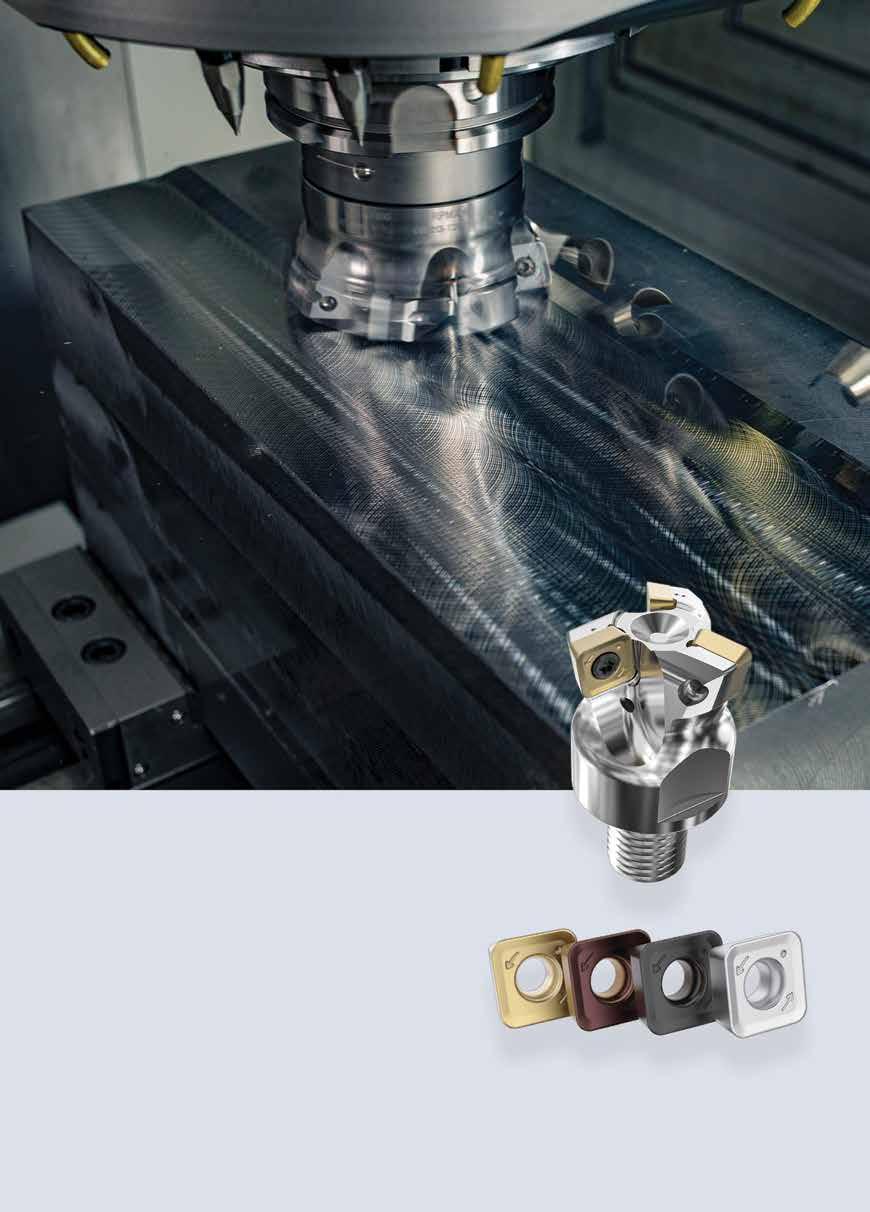
Don’t slow down. Machine it faster.
Discover the power of high feed milling with square inserts. Higher material removal rates, reduce cycle times, and longer tool life.
Outperforming traditional systems.
The High Feed SP system performs 6 different operations: face, slot, plunge, and side milling, ramping, and helical interpolation. Perfect for roughing operations and tough materials like titanium and stainless steel.
Not only fast but strong too.
Nothing to worry about anymore. The square inserts are hard to break and they just work, even on smaller machines. secotools.com
INDUSTRY 5.0
Industry’s next frontier is here. Not only overseeing robots – but collaborating with them.
16 State of Play – Industry 5.0 is the human upgrade – so what happens next, with collaborative robots?
18 Revolutionising Industrial Repair – Developed within the CSIRO, a new technology is quietly transforming how industries approach the repair and maintenance of critical metal components.
20 Scaling Smart – Key considerations for startups on the path to manufacturing success from Bradley Trewin, Head of Sales, Marketing and Key Account Programs from Bosch Australia Manufacturing Solutions
22 Getting Network Fundamentals Right – Ankur Jain, Director Infrastructure Solutions (AMEA) for BT International discusses creating the infrastructure foundations businesses need for a scalable future.
23 Go Go Gadget Arms – T ips for developing in-house robotic welding skills within your manufacturing business from Orion Automation Systems technical director Jeff Fordham.
Industry 5.0 is the human upgrade – so what happens next, with collaborative robots?
Industry 4.0 – the integration of digital technologies into all aspects of industry – has been well established for some time now. But now researchers are looking at ways of using robots with a much older, more unpredictable technology. The human being.
At the heart of the human-centric approach of Industry 5.0 is collaborative robotics, or “cobotics” – which are designed to work safely alongside human workers, and currently for sale and working at sites across Australia.
Australian Cobotics Centre (ACC) associate director for research training Glenda Caldwell says there’s “a big shift” for researchers to consider. “Industry 4.0 is very much about how industry develops and uses more advanced technologies in their processes,” Caldwell says..
“So the focus of Industry 4.0 is the technology itself, whereas Industry 5.0 is looking at, well, what are the complex problems that we face… and how do we use those technologies in different industry sectors to address those problems?”
“Now we understand we’ve got these technologies, but how do we use them beyond just to produce more stuff? How do we increase human wellbeing, climate, planetary wellbeing?”
CSIRO Robotic Manufacturing Team senior research scientist
Peter King says regular industrial robots are almost like power tools – “just it’s so much more efficient and productive to use than hand tools.”
Whereas a cobot is designed with some awareness, whether it’s in sensors, cameras or programming, to be safe to move or work alongside people. At the ACC, Dr Caldwell oversees researchers who investigate how humans and robots might work together. “We spend a lot of our time understanding what the person needs to do… We really want to understand what the person is doing in that task or in that environment, and then working with them to identify the best way to introduce a cobot into their workflow and, you know, getting their input and understanding," she says.
Advanced manufacturing manager for Weld Australia Cornelius van Niekerk says that the cobots currently on the market are equipped with sensors that can be adjusted to stop before coming into contact with a human.
“So, you don’t need the safety cages, you don’t need all the screens that you have with an industrial robot and all the warning labels as well. But there’s still safety aspects to it –you still need to be aware of the fact that you have a moving machine part near you.”
At Weld Australia, van Niekerk helps build connections between technology suppliers and industry experts through cobot road shows, giving him a front-row seat to observe how industry is responding to the arrival of cobots in the market, and what they’re hoping it might achieve.
"The two big ones our member base typically bring up when I ask them about their biggest challenges are skill shortages and productivity problems," he says.
"Most of them say to me, 'Cornelius, if we could double our welding workforce, our number of welders, that would actually solve—we would start running at capacity.'" And the promise
Cornelius van Niekerk says cobots aren’t heading to work on roof beams, yet.
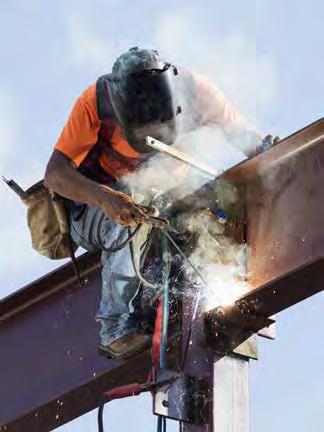
of cobots for welding applications is a profound one, he adds. “Most of the members say to us that they get about one to two hours of actual arc-on time in an eight hour working day, which is the average – but it’s shockingly low,” he says. This low utilisation occurs because skilled welders spend most of their time on ancillary tasks—joint preparation, materials handling, warehousing and setup work rather than the highvalue welding itself. Cobots offer a solution that addresses both productivity and workforce concerns without the fear factor associated with traditional automation.
"A big fear is that these things will replace the welders in the workforce," van Niekerk acknowledges. "Cobots kind of address that fear because they're so collaborative, whereas an industrial robot, you put it in a cage with all the safety that goes with it—it has no idea it's working with a human.
That said, the collaborative nature of cobots means they still require skilled operators. "It still takes a skilled welder to program that robot," van Niekerk explains. "It can take the repetitive, fatiguing jobs off of a welder's hands to free up that welder to do more skilled work." King agrees, saying the cobot can complement the work of an existing welder.
“Ideally what you want to do is, once you’ve done your initial assessment of exactly what needs to be repaired, is to then set the robot to go about doing that mind numbingly difficult sort of work… Sometimes it’s done under conditions where you don’t want to have a human doing that sort of work.”
This human-centric approach extends beyond individual workstations to encompass entire organisational systems.
The ACC research that Caldwell oversees focuses on what she terms "socio-technical systems" that consider human factors, design factors, and extended reality (XR) applications.
"We're looking at the human factors—how do humans and robots work together, what are the emotional and psychological aspects, how do we design better interfaces and programming methods," she explains.
As an Australian Research Council supported organisation, Caldwell and the ACC researchers have worked with medical device manufacturers, metal fabricators and construction material producers, while van Niekerk has facilitated implementations across welding and fabrication workshops.
Van Niekerk says cobots right now can be programmed to perform very basic welding – making them suited for straightforward, simple and highly repetitive jobs where they are moved into place. “Some people walk away saying automation is actually not for us at all, because it still takes some time to set the cobot up. You still have to move it into place point by point, so it could take a significant amount of time.”
Australia's manufacturing sector presents a few challenges for the adoption of cobots and Industry 5.0 more broadly, compared to overseas markets.
Unlike mass production environments, Australian manufacturing is characterised by "mass customisation rather than mass production," Caldwell says.
"We're not manufacturing huge assembly lines of cars. Most of our manufacturing is smaller production runs, and that's where these collaborative robots can provide a lot of benefit."
Van Niekerk says the fabricators that visit his workshops are looking to secure a return on their investments.
He says the economic case for cobots depends on the application, the duration and complexity of the tasks planned.
"The general rule is, you can rent a cobot, but if you have a job that's going to run for more than 18 months to two years, then you're moving into the space where it becomes more economical to buy a cobot," he says.
But the successful implementation of Industry 5.0 requires a strategic approach, Caldwell says – adding that she aims to show that there will be some value in giving cobots a try.
“They’re not going to solve every problem,” she says.
“I think it's a slow, incremental introduction—you introduce them to do one specific thing, and once there's trust and understanding and confidence around what it can do there, then gradually the complexity can increase.”

Developed within the CSIRO, a new technology is transforming how industries approach the repair and maintenance of critical metal components.
The CSIRO’s Continuous3D project is giving robots the “brains and eyes” they need to make industrial repairs more efficient –while also addressing the sector’s shortage of skilled labour. Like many advanced economies, Australia faces a looming shortage of skilled tradespeople.
CSIRO Robot Manufacturing Team senior research scientist
Peter King says he understands Australia needs 70,000 welders by the year 2030.
“Whereas in the past, we had these people, now the younger generation is more interested in other professions. That leaves us with the problem of keeping critical infrastructure running and manufacturing things,” he says.
Continuous3D was born out of the need to make working with industrial robots easier and more productive, King explains.
“The first part of a project typically involves a lot of robot programming, and that can often be quite a headache,” he says. “Often you want to get down to actually doing the task, but the first thing you’ve got to do is spend a bunch of time with the robot offline.” The Continuous3D system changes this paradigm by equipping industrial robots with advanced sensors – such as laser scanners – and intelligent software.
“We gave the robot brains, as in the software, and we gave it eyes, which is the sensor,” says King. “A robot equipped with those two things is able to understand the work it has in front of it and act.”
“It’s a relatively small sensor – it might weigh a few kilos or so, and it’s very robust. It’s attached to the robot arm and there’s a connection to a computer there as well. So, the robot controller, the computer controlling the robot, is connected to a PC running our software.”
This means that instead of painstakingly programming robots for each new repair job, measuring the work piece and even creating CAD files, operators can rely on Continuous3D’s software to automatically generate the necessary tool paths. The robot scans the component, identifies areas that need repair, and creates a plan to rebuild the surface – often in minutes rather than hours.
One of the key breakthroughs of Continuous3D is its ability to handle complex geometries. Traditional 3D printing and repair systems are often limited to flat surfaces, but industrial robots offer six degrees of freedom – allowing them to move and operate in far more complex ways. “With printing, you are often printing onto a flat surface, and that comes down to the design of the 3D printer,” King says.
“What you can do with the robot is you actually have six degrees of freedom, allowing the robot arm to move in different orientations and to grow material in different directions. That’s incredibly useful and flexible, but you need to have the maths to be able to produce the tool path. That’s what we’ve done.”
The result is a system that can repair curved surfaces, complex castings and other challenging shapes – opening new possibilities for in-situ repairs and large-format additive manufacturing.
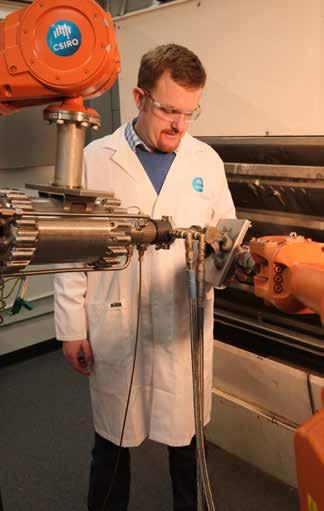
Dr Peter King in one of CSIRO’s robotic additive manufacturing laboratories with a 3D printed titanium component.
The potential applications for Continuous3D are vast, King says, with mining and aircraft maintenance two focus areas at present. “Right now, we often work with robots that have, say, payload capacities of 20 to 60 kilograms… the kinds of robots that handle metal spray equipment, manipulating welding torches or laser cladding heads,” he says.
“Now in in the future, we imagine that you could be using mobile robots. So instead of taking components offline and shutting down a line… you could bring the robot with the tool to the point of need, so that it actually does the repair on site where the equipment is wearing down – on a mine site, on board a ship or in dry dock.”
The Continuous3D system is designed to be flexible, retrofitting onto existing industrial robot arms. The sensors are robust, capable of operating in dusty, hot, and otherwise challenging environments. The system can handle components ranging from large mining buckets to small, intricate engine parts.

of the Continuous3D Team participating in CSIRO’s ON Accelerate Program in 2024.
King adds that Continuous3D doesn’t aim to replace human workers, but to augment their capabilities. “If you are doing welding manually, there are plenty of studies as to how long the welding torch is actually on. For humans, it’s less than 20% of the time,” King explains.
“If you are doing that robotically, you can get potentially five times improvement in efficiency. Now you still have the human there, supervising a robot or perhaps supervising many robots.” This shift allows skilled workers to focus on higherlevel tasks—such as quality control and decision-making –while robots handle the repetitive, physically demanding, and sometimes dangerous work.
Continuous3D is already in use across several CSIRO labs and is being trialled with industry partners in mining and aerospace. “We are currently working with a number of companies,” King says. “One example is doing metal spray repair onto complex shaped castings used in aircraft engines. We also have components that have been coated using our technology out for evaluation in the mining industry.”
King adds that Continuous3D is not a cloud-based solution, meaning it could offer some peace of mind for industries concerned about data security and industrial reliability.
“If you've got a heavy capacity robot moving around and operating high energy processes, the last thing you want is for it to stop just because the internet cut out,” he says.
“In terms of data security, the software is designed in a way that the data never leaves the user's site.”
The team is actively seeking new collaborators and sees potential for the technology to expand beyond metals to polymers, composites, and even concrete. “Nowadays you can print almost anything,” King says. “If you can stick it on a robot, we’ll take a look at it.”
As manufacturing faces the twin challenges of labour shortages and increasing complexity, technologies like Continuous3D offer a glimpse into the future – where humans and robots work side by side, combining the best of both worlds to keep industry moving forward.
For more information about Continuous3D and opportunities for collaboration, visit the CSIRO website or contact the project team directly.

Key considerations for startups on the path to manufacturing success from Bosch Australia Manufacturing Solutions head of sales, marketing and key account programs Bradley Trewin
For many startups, the journey from a brilliant product idea to a market-ready, scalable solution can be fraught with challenges. While innovation sparks the initial concept, navigating the complexities of manufacturing and scaling up requires a strategic approach. For startups looking to de-risk their automation journey and achieve sustainable growth, here are a few insights the team at Bosch Australia Manufacturing Solutions has picked up along the way.
1. Understand your market and be prepared to pivot: The startup landscape is dynamic and market demands can shift rapidly. It is vital to deeply understand your target market and be agile enough to pivot when necessary. Many startups experience a pivot – whether it's a market strategy pivot or a hardware design pivot. The key is to make these critical adjustments before significant scaling efforts begin, as once you've scaled, it's already too late. Early feedback and quick decision-making are paramount to avoid costly missteps.
2. Design for Manufacture and Assembly (DFMA) –Early engagement is key:
Often, product design proceeds without sufficient consideration for how it will be manufactured at scale. This can lead to significant rework, delays and increased costs down the line. BAMS stresses the importance of early engagement with manufacturing partners during the design phase. Design is subservient to manufacturing, not the other way around. Bringing in external expertise from material vendors, subcontractors and automation partners can provide invaluable feedback, ensuring your design is optimised for efficient and cost-effective production.
bodd, an Australian Software as a Service (SaaS) company specialising in 3D body scanning technologies, faced the challenge of not having manufacturing facilities or hardware expertise despite developing early-stage prototypes. To commercialise their scanners and scale globally while keeping its manufacturing 'Made in Australia', bodd partnered with BAMS, which provided crucial support in validating designs, prototyping, testing and overcoming hardware and engineering challenges, including IP roadblocks and highspeed data communication.
3. Start with a Minimum Viable Product (MVP) with variants and an upgrade roadmap:
The temptation to perfect a product before launch can delay market entry and burn through resources. Instead, focus on developing a Minimum Viable Product (MVP). This allows for faster deployment, quicker returns on investment and crucial real-world learning that can inform future iterations. A critical aspect of this stage is the "design freeze." While designers always find improvements, at some point the design must be finalised to allow manufacturing to proceed. Prioritising that design freeze is essential to move the project forward efficiently.
4. Scale and automate when and where appropriate:
Scaling does not always mean immediate, full automation. The decision to automate should be strategic, considering factors like product volume, variability and the need to avoid downtime from changeovers.
RayGen, a Victorian startup, spent 12 years developing its innovative solar technology, initially proving its concept with a largely manual setup at its Mildura site. This manual approach was appropriate for the early development phase. However, manual operations became unviable as RayGen transitioned to scaling up – now producing 150 fields that require 41,000 heliostats, 330,000 mirrors and millions of components.
RayGen approached BAMS seeking a production line that could produce a 5x5 metre array of mirrors in just three minutes, operate 24/7 in remote locations and be deployable, packable and re-deployable to new sites. This strategic decision to move from manual to highly automated manufacturing, with BAMS's support, exemplifies the principle to "scale and automate when and where appropriate," driven by the significant increase in projected volume, complexity and unique operational requirements.
5. Collaborate with the right partners to concentrate on your core business:
For startups, resources are often limited, and focus is everything. Identify your core value proposition – what truly differentiates your product or service – and dedicate your primary efforts there. Do not get distracted with the hardware aspect if your core business is software, for example. Therefore, collaborating with experienced partners is critical at every step of the journey, as no startup can do it all alone. Leveraging partners who specialise in the numerous facets of the manufacturing ecosystem allows you to outsource complexities, enabling you to focus on that core business proposition and where you add value.
By thoughtfully considering these key principles, startups can significantly enhance their chances of moving from an innovative idea to scaled, successful manufacturing, ultimately de-risking their automation journey.

BRADLEY TREWIN Head of Sales, Marketing and Key Account Programs at Bosch
Australia Manufacturing Solutions

RJS Tech Group advanced Australian manufacturing and engineering businesses, united by innovation, precision, and certification excellence.
• PPTools – High-precision custom tooling (ISO-certified)
• NanoTech – World-class surface coatings and PVD technology
• Rogers Industries – Australian-made plastic injection moulding & aluminium die casting
• Whitelaw Engineering Machinery – Premium European lathes and milling machines
• MetalTech – Industrial metal 3D printing specialists
• Wood Tech – National supplier of CNC and woodworking equipment
• PPE Tech – ISO-certified, TGA-listed P2 face masks made in Australia
Certified quality, local capability, and industry-leading solutions.
www.rjstechgroup.com.au
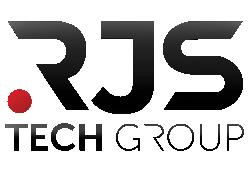
ISO 9001ISO 13485
Registered Australian Made
CMI Certified TT10061
AS/AZS 1716:2012
ARTG 352290

BT International Infrastructure Solutions (AMEA) director Ankur Jain discusses building the infrastructure foundations businesses need for a scalable future.
Generative Artificial Intelligence (GenAI), automation and machine learning are driving generational change, reshaping the future of business and society as we know it. However, for these capabilities to accelerate innovation at an organisational level, Australian enterprises must first overcome a critical hurdle: getting their network fundamentals right to fully embrace the future. The growing importance of digital revenue underscores Australian businesses’ importance in getting their Network-as-a-Service (NaaS) fundamentals right. The trouble for enterprises is knowing where to start.
The lack of a widely adopted industry definition for NaaS creates confusion. In many ways, it is customer-specific, and the NaaS your company requires is unique and evolving, just like your business. It’s like having a virtual toolbox that allows you to adapt the network to suit your needs in real time, whereas it could take weeks with previous technologies. This enables you, as a business, to modernise traditional networks into highly scalable cloud-centric solutions and flexible architectures that adapt quickly to different organisational needs. Instead of patching together legacy networks, a NaaS platform simplifies the secure and reliable interconnection of employees, customers, suppliers and operational devices to applications and digital services — including AI — that are hosted across multiple clouds. Ultimately, this provides flexibility and scalability to meet the evolving needs of your business and the market.
Fundamentals that matter
To realise the full potential of digital revenue, companies must first solidify foundational elements like seamless third-party connectivity, automation and scalable architecture. Without this, organisations face unpredictable costs, slow application performance (especially for AI and cloud services) and vendor lock-in. Investing in a robust NaaS platform allows you to spin services up or down based on demand. This ‘build once, scale many’ approach ensures you meet today's GenAI workloads while remaining ready for tomorrow’s innovations. Failing to get these basics right often means costly technology sprawl, fragmented visibility and endless forklift upgrades - a future resource drain.
The insatiable demands of GenAI GenAI’s appetite for data is unrelenting. Large language models (LLMs) ingest vast volumes from edge sites, data centres, cloud and third-party sources, all with optimal latency. This distribution necessitates a network that balances low latency (processing at the edge) with high-speed and secure transport to LLMs in the cloud. Industry uses of GenAI also rely heavily on large data lakes where the LLM acts as a reasoning layer. The outcome here is to enhance or personalise the information generated by the underlying LLM with more relevant and up-to-date information from the data lake. Traditional legacy infrastructure with long lead times and manual configurations simply can’t keep up with these demands. This is hindering GenAI adoption and blocking enterprise transformation; as adoption rates of this technology accelerate, your network will quickly become incapable of meeting demands.
Embracing flexibility: pay-as-you-use
Just as hyperscalers offer pay-as-you-go compute, modern networks must also deliver commercial flexibility. Companies should review their fixed, multi-year contracts that necessitate over-provisioning. With multi-cloud adoption, organisations also encounter ‘bill shock’ from unexpected egress fees when transferring data from hyperscalers. NaaS platforms that simplify multi-cloud connectivity with usage-based autoscaling are the way forward. You only pay for what you consume while maintaining enterprise-grade security and global reach.
Overcoming complexity with automation and API-first design
Concealing the intricate orchestration of network components and presenting it as a straightforward ‘click to deploy’ solution is essential for simplifying and expediting infrastructure outcomes. To be genuinely future-proof, a NaaS platform must provide 100% automated capabilities – from bandwidth adjustments to dynamic network and service policies, driven by real-time telemetry, which eliminates manual intervention and ensures a swift response from IT to evolving business needs. Similarly, an API-first architecture, instead of API as an add-on, ensures that network services integrate seamlessly into DevNetOps workflows. This gives organisations digital control over their connectivity fabric, and thus the ability to leverage a NaaS platform to deliver a step change in their user experience.
From foundations to frontier
Getting the fundamentals right, which means defining clear service objectives, investing in a flexible platform, and adopting pay-as-you-use models, sets the stage for NaaS to become a true enabler of digital and AI transformation in your business. As GenAI accelerates innovation across industries, networks that deliver low latency, automated scalability and financial predictability will be the differentiators between those organisations that merely adapt and those that lead. By solidifying these building blocks today, businesses can confidently scale to meet the demands of tomorrow.

ANKUR JAIN Director, Infrastructure Solutions (AMEA) at BT International
Tips for developing in-house robotic welding skills within your manufacturing business, from Orion Automation Systems technical director Jeff Fordham.
For your initial robotic welding system to provide the optimal return on investment, your personnel need good inhouse programming skills to quickly adapt to new products and changing production requirements. With good training, your personnel will quickly become competent and confident programmers and learn from experienced systems integrators how to efficiently program the robot welding system – and develop in-house product jigging techniques.
At Orion Automation, we are often asked "What skills do we need in our personnel to program the robot welding system?". The answer is no different to learning any new skill - they need to be "keen to learn". Of course, it helps if they understand good welding practice. We have found that apprentices in their early fabrication years make excellent students because of their familiarity with the intuitive programming technology. They are also eager to further develop their skills with the new generation of automatic robot programming software and advanced searching techniques often required in Australia's high product mix environment.
So, for your first robot welding system, let’s focus on automating the welding of your small to medium fabrications in a single station robot welding cell. The cell simplicity of a single station system minimises investment and maximises technology, while providing the tools to automate a significant proportion of your welding needs. All of this while providing the training platform for your personnel to learn how to program robot welding systems, manufacture in house production jigs and bring your welding into automatic production.
It should take about three days of training on site to upskill your personnel to be confident robot welding system programmers for small to medium products.
And the cost? To set up a dedicated fully integrated robot welding system cell within guarding to Australian standards – including jig table and "Ready to weld", with only product jigs required to start production should cost about $150,000 + GST. Of course, additional assets are required when progressing to the more flexible robot welding systems that can position larger and more complex fabrications, and which can locate fabrications that might vary in position or in individual component dimensions.
Ensuring the fabrication is oriented to the optimal welding position requires integrated additional external axes to move the product into position prior to, and during, welding. These external axes will extend the reach of the robot and orientate the fabrication during welding. Searching technologies that locate the position of the fabrications through standard touch sensing techniques or seam location by laser sensors are well established.
Establishing a system that can orient the fabrications with a dual axes positioner, within guarding to Australian standards, including a jig table, "Ready to weld" and advanced touch sensing controls and programming - with only product jigs required to start production – will cost about $230,000 plus GST and take an additional two days to train personnel. With your inhouse programming and production capabilities progressing to robotically welding small through to mid size

complex fabrications, the goal of automating the welding of your larger fabrications such as construction, mining, chassis and other large fabrications can be achieved.
Your personnel can now use their programming skills to weld larger fabrications in dedicated robot welding systems, with these standard track systems extending robot reach by tens of metres and the multi axis positioners extending payload ratings by tonnes. With your personnel confident they know how to successfully program various robot welding systems to sub assembly stages, you can transition to confidently program your large fabrications.
To ensure that these larger robot welding systems are fully utilised, the operators are upskilled to program the robot welding systems "offline", meaning that they are incorporating the 3D models of your fabrications into a computer simulation to fully program the robot welding system. Using the current generation of automatic robot programming software to further reduce programming time and complexity is an exciting development that is a true gamechanger for the robot welding industry. The cost to establish facilities to robotically weld large fabrications such as vehicle and truck chassis and heavy construction equipment is as follows:
For a dedicated fully integrated multi station robot welding Track system cell with the ability to orientate the fabrications with high payload positioners, within guarding to Australian standards. including master jigs and "Ready to weld", including advanced touch sensing controls, offline and automatic robot programming will cost about $900,000 plus GST. Training on site to develop your personnel to add Offline and Automatic Robot Programming to confidently program large fabrications will take about four days. This training is normally conducted at the time of the full factory acceptance testing of the system prior to shipping.
With experience in robotic welding systems in Australian, New Zealand, Japanese and American factories since 1987, we are available to assist you in the correct path to successfully incorporate robot welding systems within your fabrication business.
safety, cybersecurity, compliance and future planning –industry specialists offer their thoughts.
26 Collaboration and Transformation – How working together helps manufacturers make the right changes for their businesses.
28 In the Green – Applications for part of a $500 million funding pool for future green iron manufacturing open this October.
28 New Path – ATSE calls for overhaul of diesel incentives to drive industrial decarbonisation
29 Industrial Heart – New city partnership aims to fast-track emerging manufacturers, strengthen supply chains and boost Australia’s sovereign industrial capability.
30 T iming is Everything – From installing new machinery to investigating a close all, knowing when to conduct a risk assessment can make all the difference, Machine Safety Australia Senior Safety Automation Engineer Sergej Patkovic says.
34 Manufacturing campaign debuts – Industry stakeholders urged to share campaign assets as Manufacturing Industry Skills Alliance seeks to drive engagement.
36 Manufacturing Leads in Gender Balance – More women are working more hours in manufacturing, and careers are also getting longer, according to new research.
37 Safe and Sound – Elmo Software’s chief operating officer James Haslam looks at how smarter systems can turn safety into a competitive advantage.
38 Changing the Outcome – GuardWare Australia general manager of business development Richard Matthewman says even if you suffer a cybersecurity breach, losing CAD files and other secure files isn’t inevitable.
39 Turning Investments into Reality – Mattingly partner Anthony Hengel looks at the business case for new equipment and what decisions could guide your next upgrade.
40 Staying Audit-Ready – Consistent, thorough records management helps companies keep tabs on employee training and skills management without the chaos, OneCard founder and chief executive Kareena Waters says.
41 Getting your paperwork in order – It pays to optimise your processes and practices before expanding or bringing an external investor on board, says ECI Solutions vice president APAC manufacturing division Andrew Mamonitis.
42 Industry Optimisation in a Volatile Market – SYSPRO head of services for the Asia Pacific James Robinson discusses how balancing stock levels can help companies weather trade tariff challenges.
43 Balance Sheet: People, Planet and Industry – Integrating the priorities of people and planet has become not just an ethical imperative, but a strategic necessity for industry says AR & Associates creative director Ella Averill-Russell.
44 Keeping Compliance on Track – OneAdvanced head of people management solutions Damien Durston looks at ways to meet labour obligations in 24/7 shift-based supply chains.
45 Third Party – How an offsite Virtual CFO can help give your manufacturing operations a strategic edge, with William Buck principal Jeremy Raniti and senior manager Karly Whitehead.
How working together helps manufacturers to make the right changes for their businesses.
There’s no shortage of innovators in Australian manufacturing – but industry collaboration is the key to driving those innovations forward. That was the consensus of a panel discussion held at Bosch Australia Manufacturing Solutions’ (BAMS) campus in Clayton, Melbourne.
Held in commemoration of the company’s 70 years of manufacturing innovation in Australia, the company brought together business leaders for a panel discussion: “The Ecosystem of Success: Fostering Innovation and Collaboration for Australian Global Competitiveness.”
Among them was David McLaughlin, the co-founder of bodd – a full body 3D scanner machine that captures rich biometric data across the entire human body, with applications in health and wellness. The company originally planned to use the scanner for 3D printing life-size replicas of individuals for custom clothing.
“That was an idea we had. It was an example of a willingness to try, put it into market, test it, and then basically say ‘You know what? This is not the product. The product is actually our scanner.’”
Once the company reached that conclusion, bodd turned to BAMS to manufacture, distribute and provide in-field technical support for all its hardware units, helping to scale the product into Australian and global markets.
Speaking on the panel, McLaughlin said securing an “ecosystem of support” early on had been important for the company’s success.
“For us as an early-stage company or a startup, it’s impossible to do it all, so you really need to lean on experts in their domain partnerships. You need as much support as you possibly can to make it and survive.”
“Having the support network, whether it’s for export marketing or R&D funding... all those elements play a big role in helping companies take a little bit more of a risk and starting to think globally,” he said.
“From day one in our business, we said this has to be a global business, because the runway in Australia is not big enough. If you’re thinking globally, all of a sudden, those things start to become economical, because the market size is just so significant.”
It was a statement echoed by BAMS head of sales Bradley Trewin, who noted the importance of partnerships.
“When I look at the people I have dealt with over the years, the ones that have tried to do it all themselves haven’t been able to be successful because fundamentally, they haven’t understood the importance of having consistent partnership.”
AMTIL CEO Lorraine Maxwell said that while collaboration between companies was important, it was industry organisations that kept the industry together.
“So, you can organise your connections within that, or you can look to the network or the coordinators that are there to help businesses grow and connect,” she said.
A dedication to innovation was also important, she added, regardless of the size of the company involved.
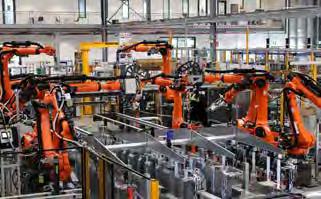

The manufacturing line Bosch Australia Manufacturing Solutions produced for RayGen.
“It is the companies who are looking to change, to horizon scan, and respond to what’s going on in the world, as well as how to adapt and evolve their technology, that will be successful in the future,” she said.
“I think that some of the biggest opportunities for us to move the dialogue in the future will be not only about embracing new technologies and implementing them but also making sure that we’ve got it right in terms of processes and people.”
Digital transformation
Panellists also broadly agreed that digitalisation and the adoption of advanced technologies such as AI, digital twins and even data-driven automation are becoming nonnegotiable for future competitiveness. Bosch Rexroth business development manager Igor Kabakov explained how his company is integrating technical advancement with products to enable advanced manufacturing. “It’s a modular system, which helps manufacturers start small and expand over time without having any larger scale platforms and upfront capacity,” he said.
RayGen product development manager Derek Scott shared how his company uses new technologies to run its solar energy farms and storage solutions. “We have a digital twin, but it’s coupled into what we call a techno economic model, because electricity prices are dynamic, and you need to be predicting what's happening in the future to electricity prices,” he said.
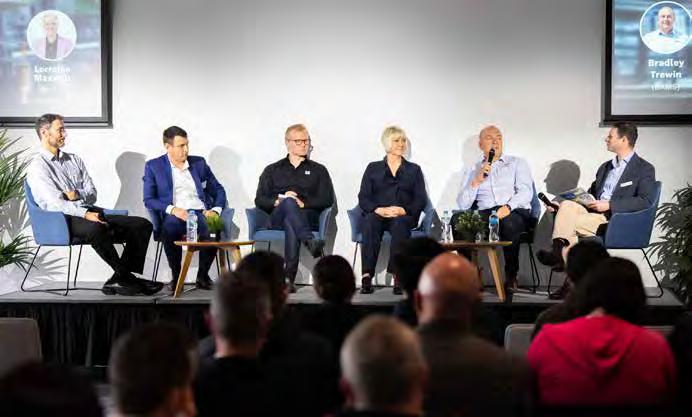
The company also uses data tracking to check on the lifecycle of their solar modules, providing valuable feedback for continuous improvement.
“Tracing product all the way from built materials through construction or fabrication in its life, and then even where it goes at the end is all tracked through that. That kind of feedback loop is critical for us.”
Trewin advised companies to start their digital transformation journeys by focusing on solving specific problems, proving a return on the investment and then getting a buy-in to scale up, rather than attempting to overhaul everything at once.
“You’ve got to understand what your problem is, what it is you’re trying to solve,” he said.
Scott added to this in saying there’s a balancing act to be respected in getting the product right before trying to scale up production.
“You can’t completely finish your product and then hand it over to manufacturing, because there are probably manufacturing efficiencies you can achieve by doing it collaboratively,” he said.
Instead, RayGen’s approach with one heliostat product was to engage Bosch before it was fully finalised, allowing for iterative improvements and smoother scaling.
“We could learn a lot, we could improve, we could make a robust product. Then we engaged Bosch, not when we were completely finished, but when it was getting there, when they knew what product we were trying to make, but there was still time to make minor tooling changes and that sort of thing to make the manufacturing easier,” he said.
“So, finding that balance around when to scale automation that kind of locks you in and makes changes more difficult, but your product has to be mature enough… if you've gone too far, then you've lost some opportunities to build an efficient product.”
For McLaughlin, creating a support framework to encourage and celebrate businesses that are taking risks is important for the future of Australian innovation.
“We've spent the last 10 years telling all the kids they need to go and be software developers, and AI has basically come along and said, actually, don't worry about that, we’ve got this,” he said.
“But I think the skills that are going to be really valuable are those skills that blend software with the physical.
So, mechatronics, systems, level design…
“What AI and new software technologies cannot do is they cannot come up with new problems and the solutions to those new problems. So, we need to teach people. We need to teach people skills on how to be critical thinkers.”
Scott highlighted the importance of maintaining a “critical mass” of manufacturing capability and expertise in Australia, warning that losing this base could have l ong-term consequences for the sector’s resilience and innovation capacity.
“Having a critical mass of that capability here, whether it's machine shops, fabrication, automation specialists, and that sort of thing, is critical for us to be able to go and have a range of other businesses to support what we're doing, as a start,” he said.
“So, making sure that we have this critical mass and it continues to be encouraged, is critical, because there is a bit of a risk that you start to lose capability and snowball… there’s got to be that availability.”
Applications for part of a $500 million funding pool for future green iron manufacturing open this October.
Australian companies aiming to produce iron in a more sustainable manner are invited to apply for grants from the National Development Stream of Australia’s $1 billion Green Iron Investment Fund.
While up to $500 million of that fund has been dedicated to supporting changes to the Whyalla Steelworks, another $500 million will be available to support early mover green iron projects and help overcome the initial hurdle of capital investment. To be eligible for the grant, projects must aim to develop a commercial scale green iron facility, be focussed on capital works and located in Australia. Only entities with an ABN and which are registered for GST can apply.

Industry Minister Tim Ayres says the grant funding will support early mover projects ready to start commercial scale production of green iron by 2031.
“Green iron is a major opportunity to grow Australia’s iron ore industry and build a new industrial sector,” he says. “This $500 million investment lays the foundation for a multibillion-dollar industry and thousands of good, secure jobs.”
Applications open on October 28 and close on 16 January 2026.
ATSE calls for overhaul of diesel incentives to drive industrial decarbonisation.
Australia must urgently reduce its reliance on diesel in heavy industries, according to a new report from the Australian Academy of Technological Sciences and Engineering (ATSE).
Released in partnership with Fortescue, the report warns that mining, road freight, agriculture, fisheries and forestry cannot meet emissions targets without a shift away from diesel fuel – and that current policies are holding back progress.
ATSE chief executive Kylie Walker says reforming tax and policy settings was essential to enable industry to embrace clean fuel technologies. “There is an urgent need to decarbonise Australia’s most emissions-intensive sectors,” she says.

“By encouraging the application of mature clean fuel technologies, investing in fast-tracking clean tech in development, reducing the cost of green alternatives and increasing the cost of diesel in a targeted and balanced way, Australia can achieve its industrial decarbonisation.”
The report makes five key recommendations, starting with an independent review of financial incentives that support diesel. It singles out the Fuel Tax Credits Scheme (FTCS), which subsidises diesel use and shields operators from the true cost of fossil fuel consumption. According to ATSE, this creates a structural barrier to investment in low-emissions alternatives and undermines national decarbonisation goals.
The Academy also calls for reforms to Australia’s emissions reduction mechanisms, such as carbon pricing or adjustments to the Safeguard Mechanism to account for diesel’s full environmental impact. Other measures include a coordinated Future Diesel Strategy, new infrastructure to enable
clean energy uptake, and targeted R&D investment to bring emerging technologies to market. ATSE Fellow, Fortescue Board Member and former CSIRO chief executive Larry Marshall says the current policy mix discourages innovation.
“Heavy industry wants to transition to cleaner fuels, but the current policy settings make it harder than it should be,” he says. “Right now, the Fuel Tax Credit Scheme effectively subsidises burning diesel, while companies that invest in clean alternatives face higher costs. That imbalance holds back innovation and locks in emissions.”
Marshall says government and industry must work together to accelerate the transition. “If we want Australia to become a clean energy superpower – if we want a Future Made in Australia – then we need a system that rewards smarter, cleaner choices,” he says.
“Emerging clean technologies need the right mix of policy, incentives and investment to make Australia’s green and gold vision a reality.” The report stresses that a one-size-fits-all approach will not work. While electrification offers solutions in some areas, ATSE highlights the need for a wider range of clean fuels and technologies to support industries that depend on high-density, portable energy sources.
A comprehensive techno-economic assessment of these options is needed to chart realistic decarbonisation pathways. Walker says the transition would be complex but achievable with the right mix of policies and investment. “We have the technology; we can do it if we get the settings right,” she says.
New city partnership aims to fast-track emerging manufacturers, strengthen supply chains and boost Australia’s sovereign industrial capability.
Australia’s advanced manufacturing sector is the focus of a new partnership between the National Reconstruction Fund (NRF), the Bradfield Development Authority (BDA), and the Advanced Manufacturing Readiness Facility (AMRF).
Bradfield, the new city taking shape alongside Western Sydney International Airport, will host an innovation cluster designed to connect firms with the facilities and capabilities they need to scale.
The partnership will create a pipeline of referrals between the NRF and AMRF, ensuring businesses can access support for both capital investment and technical readiness.
The groups aim to help emerging manufacturing firms grow by providing coordinated support across the entire supply chain — from research and design through to production, distribution and sales.
For manufacturers, this means streamlined access to investment, technical expertise and industry networks.
With New South Wales contributing nearly a third of the nation’s manufacturing output — and accounting for 37 per cent of the proposals currently before the NRF — the state is positioned to play a central role in strengthening sovereign capability.
Federal Industry and Science Minister Tim Ayres says the partnership would directly support the creation of highly skilled manufacturing jobs and a stronger industrial base.
“With AMRF’s technical expertise guiding NRF investment decisions, this partnership will help build out Australia’s industrial capability and deliver a Future Made in Australia,” he says. NSW Planning Minister Paul Scully notes Bradfield’s role as a hub for advanced industries, noting that businesses across the country are already engaged with the AMRF.
NSW Industry and Trade Minister Anoulack Chanthivong says aligning state and national initiatives would boost the innovation ecosystem and help manufacturers better prepare for private capital investment. “The AMRF will offer technical advice and assistance to ensure businesses better prepare themselves to attract private capital,” he says.
“Partnering with NRF will help grow and develop the state’s innovation ecosystem and industry even further.”
“Alongside the existing agreements the AMRF has with 11 NSW and ACT universities, this will support the entire manufacturing supply chain from R&D through to full scale commercialisation,” he says.

From installing new machinery to investigating a close call, knowing when to perform a risk assessment can make all the difference, Machine Safety Australia senior safety automation engineer Sergej Patkovic says.
Imagine this scenario: Your team installs a new collaborative robot application on the production line to automate what was once a manual task and introduce collaborative interaction with workers. Because the system does not rely on physical distance barriers such as perimeter guarding, it promises flexibility, space savings and productivity gains. The robot has been designed to operate under a power and force limiting (PFL) safety function, but no risk assessment was carried out to identify the contact scenarios, nor has validation been performed using a pressure and/or force measuring device. As a result, when the robot moves into action, its force and power output exceed the biomechanical limits set out in ISO 10218-2:2025, putting operators at risk of injury. It’s a stark reminder that a thorough risk assessment might have flagged that hazard and prompted better safeguards.
Risk assessments are a cornerstone of workplace safety. They involve finding potential hazards, evaluating how serious and likely those hazards are to have a negative outcome, and then fixing them before harm is done. Australian standards and safety codes make it clear that risk assessment isn’t a one-and-done task, it’s an ongoing process through the life of any equipment or process. In fact, the Australian Standard AS/NZS 4024.1201 (Safety of Machinery) emphasises considering safety throughout a machine’s life cycle – from transport and installation to commissioning, use, and eventual decommissioning. It stresses that only when hazards have been identified can steps be taken to eliminate them or to reduce risks, advising designers (and by extension, employers and engineers) to identify all tasks and operations associated with a machine. In simpler terms: you need to anticipate danger at every stage if you want to keep people safe. So, when exactly should a risk assessment be carried out in a manufacturing context? The short answer: both regularly and whenever something changes that could affect safety. Below, we break down some of the key triggers for conducting a risk assessment.
Key triggers for risk assessments in manufacturing Manufacturing is dynamic. New products, new machines, and new processes are part of the game. Recognising the situations that call for a fresh risk assessment can prevent accidents and keep you compliant. Work Health and Safety authorities across Australia consistently point to a few critical moments when you should hit pause and reassess the risks:
• When introducing new equipment or processes: Every time you bring in a new machine, install a piece of plant or even use a new substance or material in production, it’s time for a risk assessment. The WorkSafe Victoria Compliance Code: Plant explains that if a known safe way to control a well-understood hazard exists, you might implement that immediately. But if you’re unsure how to control a risk associated with a new item of plant, a formal risk assessment is the way to figure it out. This is because a risk assessment will reveal what could go wrong and how severe it could be. Essentially, new things equal new risks, until proven otherwise.
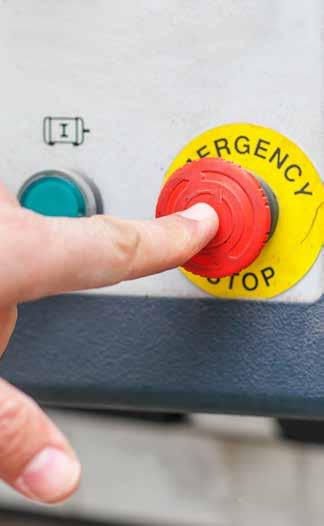
• When modifying or upgrading equipment or procedures: If you change an existing machine or process, even slightly, you should reassess the risks. This includes physical modifications to machinery (adding new tooling, altering guards, software upgrades) as well as changes in how work is done (new production methods or workflow changes). A fresh risk assessment will ensure these modified conditions remain safe.
• When work practices or the environment change: Changes in work schedules, procedures, or even the workplace environment should trigger a risk review. WorkSafe Tasmania advises doing a new assessment when you are “changing work practices, procedures or the work environment”. Perhaps you’ve introduced shift work at night, or moved a machine from a spacious area to a cramped corner, these scenario changes can introduce fatigue or ergonomic hazards, respectively, that warrant a fresh look. Even a change in environmental conditions (like ventilation, temperature, or noise levels) can increase risks. The goal is to catch any new hazard that creeps in through change.
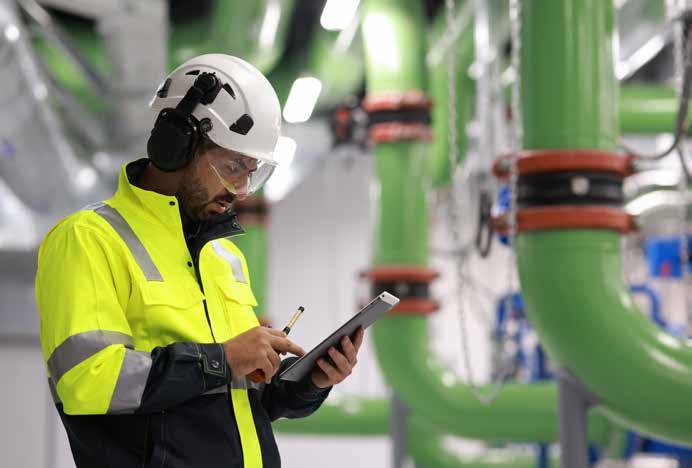
• After any accident, incident, or near miss: A serious incident or a near miss is a flashing red light that something in your risk control system might be inadequate. Investigating the event should include a risk assessment to prevent it from happening again. WorkSafe Victoria urges employers to look at near misses as a cue to improve safety before a tragedy occurs. One real-life case: a Victorian plastics manufacturer had a worker suffer severe burns while cleaning a plastic granulator machine. The subsequent investigation found it was “reasonably practicable for the company to undertake a risk assessment of the granulator” to devise a safer cleaning method. Near misses and incidents provide hard evidence that a hazard wasn’t fully controlled, they absolutely justify doing a fresh risk assessment.
• Periodically or when new information emerges: Even if nothing major has changed and no incidents have occurred, it’s wise to conduct periodic risk assessments as a proactive measure. Machinery wears out, staff come and go, and industry knowledge evolves. Regular safety audits or risk reviews (say, annually or at an interval appropriate to your level of risk) can catch issues that develop slowly over time. WorkSafe Tasmania highlights that risk assessments should be done regularly as well as when a specific change occurs. Likewise, the SafeWork NSW Code of Practice: Managing Risks of Plant notes that control measures must be reviewed (in effect, re-assessed) if a new or relevant hazard or risk is identified or if consultation with workers indicates a problem. Regular reviews also help ensure compliance with any updated laws or standards. Think of it as preventative maintenance for your safety system.
Conducting risk assessments at the right moments isn’t just about ticking a compliance box, it has real benefits for legal peace of mind, the wellbeing of workers and even your bottom line.
• Legal compliance and duty of care: Under Australian law (whether Victoria’s Occupational Health and Safety Act 2004 or the model Work Health and Safety Act adopted in NSW and other states), employers or people conducting a business or undertaking (PCBUs) have a duty to ensure a safe work environment so far as is reasonably practicable. Performing timely risk assessments is a practical way to meet this duty by identifying hazards and controlling risks before they harm someone. While the law doesn’t always say the words “thou shalt do a risk assessment” for every scenario, it effectively requires it by insisting that risks be proactively managed.
• Safety of workers (and others): The most important reason to do a risk assessment is, of course, to prevent injuries and save lives. It’s about making sure everyone goes home in one piece. By systematically examining what could go wrong, whether it’s a worker’s hand getting caught in machinery, exposure to hazardous chemicals, or a forklift collision, and then implementing controls (like guarding, training, safe work procedures, PPE), you drastically reduce the chance of harm. Many near misses and injuries in manufacturing can be traced back to hazards that were either not spotted in time or not properly understood. Risk assessments bring those issues into the open. They also help evaluate how serious a risk is, which existing controls are or aren’t working, and what action is needed. This clarity can literally be life-saving.
Continued next page
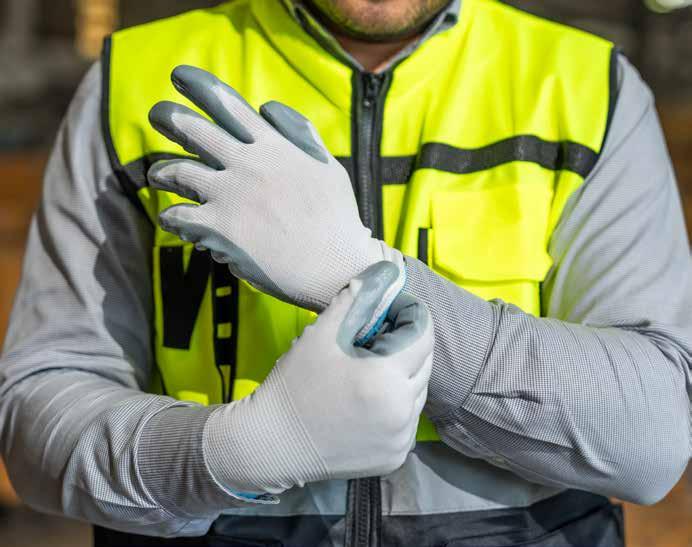
• Productivity and business continuity: Safety and productivity in manufacturing are two sides of the same coin. It might seem like stopping to do risk assessments could slow down projects or production, but in practice it prevents far more costly downtime in the long run.
Think about what a serious workplace accident entails: operations halted, emergency response, investigations, possible equipment damage… not to mention the human cost and the effect on workforce morale. Even a non-injury incident, like a machine breakdown due to a mishap, can disrupt production schedules and incur repair costs. Timely risk assessments help you avoid these interruptions by catching potential failure points and unsafe conditions early. For example, a risk assessment might reveal that an operator could be struck by a moving robot arm, leading you to install laser scanners or light curtains that both protect workers and prevent the emergency stops that would halt production. A safe workplace tends to be a more efficient one: when workers feel safe, they can focus on doing their jobs well, and well-designed safety controls often improve workflow (for instance, organised workstations that reduce ergonomic risks can also enhance throughput). There’s also the aspect of avoiding legal and financial hits, fines, compensation payouts and increased insurance premiums can all r esult from incidents. In short, doing the right risk assessment at the right time is an investment in smooth, uninterrupted operations.
Conclusion: Make risk assessments a routine
In an industry driven by precision and timing, knowing when to conduct a risk assessment is as critical as knowing how a machine works. New piece of kit on the factory floor? Do a risk assessment. Changed the production line or process? Do a risk assessment. Had a near miss or a safety complaint? Definitely do a risk assessment. These timely check-ups keep your operation aligned with Australian standards and legal duties, but more importantly, they keep your people safe and your business running smoothly. By embedding risk assessment into the “rhythm” of your manufacturing activities, regularly and at every significant change, you turn it into a powerful preventive tool rather than a paperwork exercise. As the old saying goes, prevention is better than cure. In the context of manufacturing safety, that translates to assessing risks before an accident forces everyone to ask, “Why didn’t we see this coming?”
So next time you’re planning a big change, installing equipment, or even just reviewing last quarter’s safety reports, remember: the best time for a risk assessment is sooner than you think. It’s an engineering decision that could save a life, keep you out of legal trouble, and even boost your productivity, truly a win-win-win for safety, compliance, and business performance.
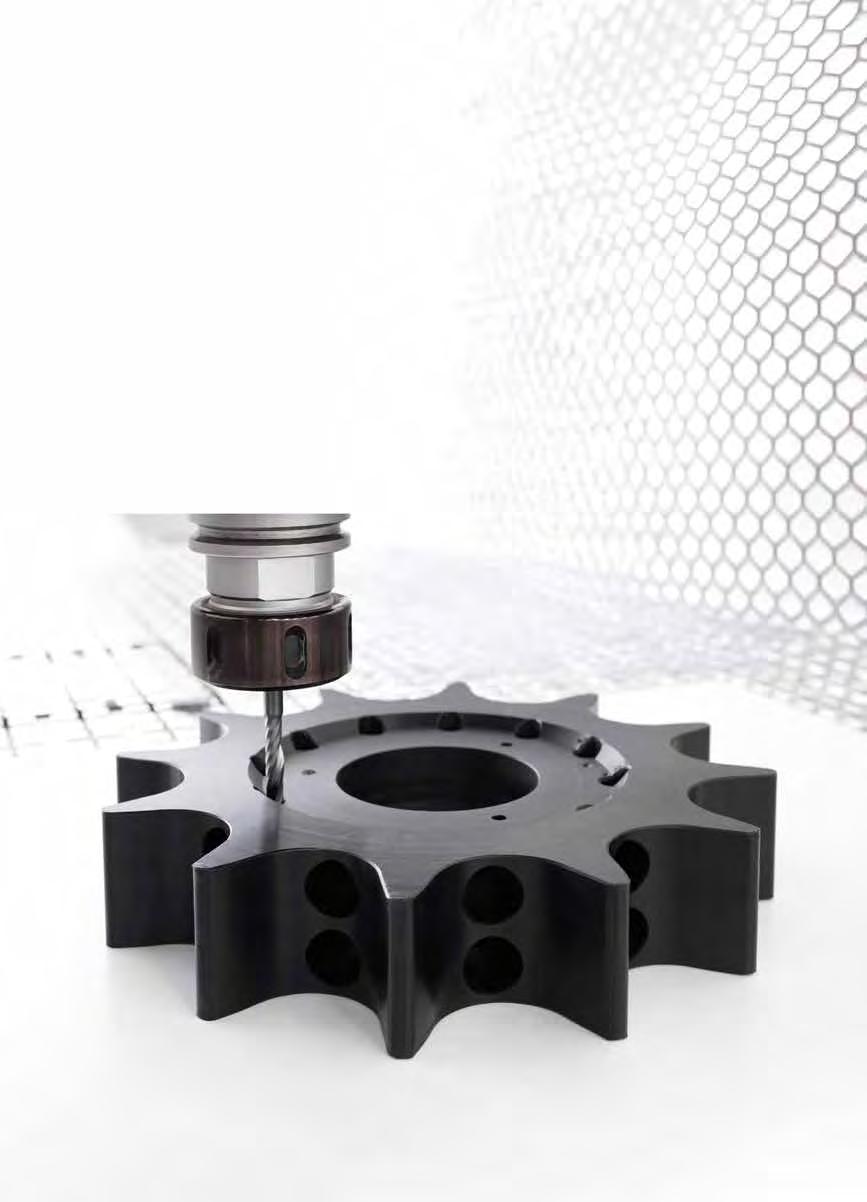
We manufacture polymer and composite processing solutions for automotive, aerospace, technical packaging and engineering plastics.
Industry stakeholders urged to share campaign assets as Manufacturing Industry Skills Alliance seeks to drive engagement.
Australia’s manufacturing sector is stepping up efforts to attract the next generation of workers with the launch of Make It ManuFACTuring – a pilot campaign designed to showcase the industry as modern, innovative and vital to the nation’s future.
Rolling out across Victoria, Queensland and Tasmania, the three-month campaign will use television, radio, outdoor advertising, digital and social media to challenge outdated stereotypes and highlight real career opportunities in manufacturing. A dedicated website, makeitmanufacturing. com.au, will also serve as a hub for information and resources.
The campaign was created by the Manufacturing Industry Skills Alliance, following consultation with industry leaders, employers, training providers and unions. Its purpose is clear: to address skills shortages by changing perceptions and inspiring young Australians – along with their parents and educators – to see manufacturing as a high-tech and secure career pathway.
Manufacturing Industry Skills Alliance chief executive Sharon Robertson says manufacturing is no longer what many people think it is. “It’s sustainable, it’s digital, it’s creative. And it offers real careers with purpose, good pay and global impact.”
“The Make It ManuFACTuring campaign brings our wonderful industry to life, showing Australians what today’s industry looks like and why it matters.”
The Alliance’s 2024 Manufacturing Workforce Plan revealed a critical challenge: too few new entrants are choosing pathways into the sector, due in large part to outdated misconceptions about the nature of the work.
At the same time, demand for digital and technical skills is rising rapidly, and more than 22% of the current workforce is aged over 55.
Robertson said the new campaign is an important first step in turning that around. “The manufacturing sector faces skills shortages in seven out of ten priority roles,” she says.
“Our 2024 Workforce Plan identified that many people weren’t even considering a career in manufacturing due to outdated misconceptions that the work was repetitive, dirty or poorly paid.”
This is despite the fact that manufacturing will contribute $100 billion to the Australian economy in 2025 and will employ nearly a million people across various industries nationwide.
“We want people to broaden their search and see the modern face of manufacturing that exists today,” Robertson says “Make it ManuFACTuring is designed to help Australians, especially young people, see themselves in this industry. Whether you’re into AI, medical technology or renewable energy, this is where you can build a career that matters,” Robertson says. The campaign will run for an initial three months, during which its impact will be evaluated through digital engagement, surveys and stakeholder feedback. Results will help inform a potential national rollout.
Stakeholders are encouraged to support the campaign by sharing content from the Make It ManuFACTuring social channels, or by promoting it through newsletters, websites and other communications. A kit of digital assets is available by contacting marketing@manufacturingalliance. org.au.


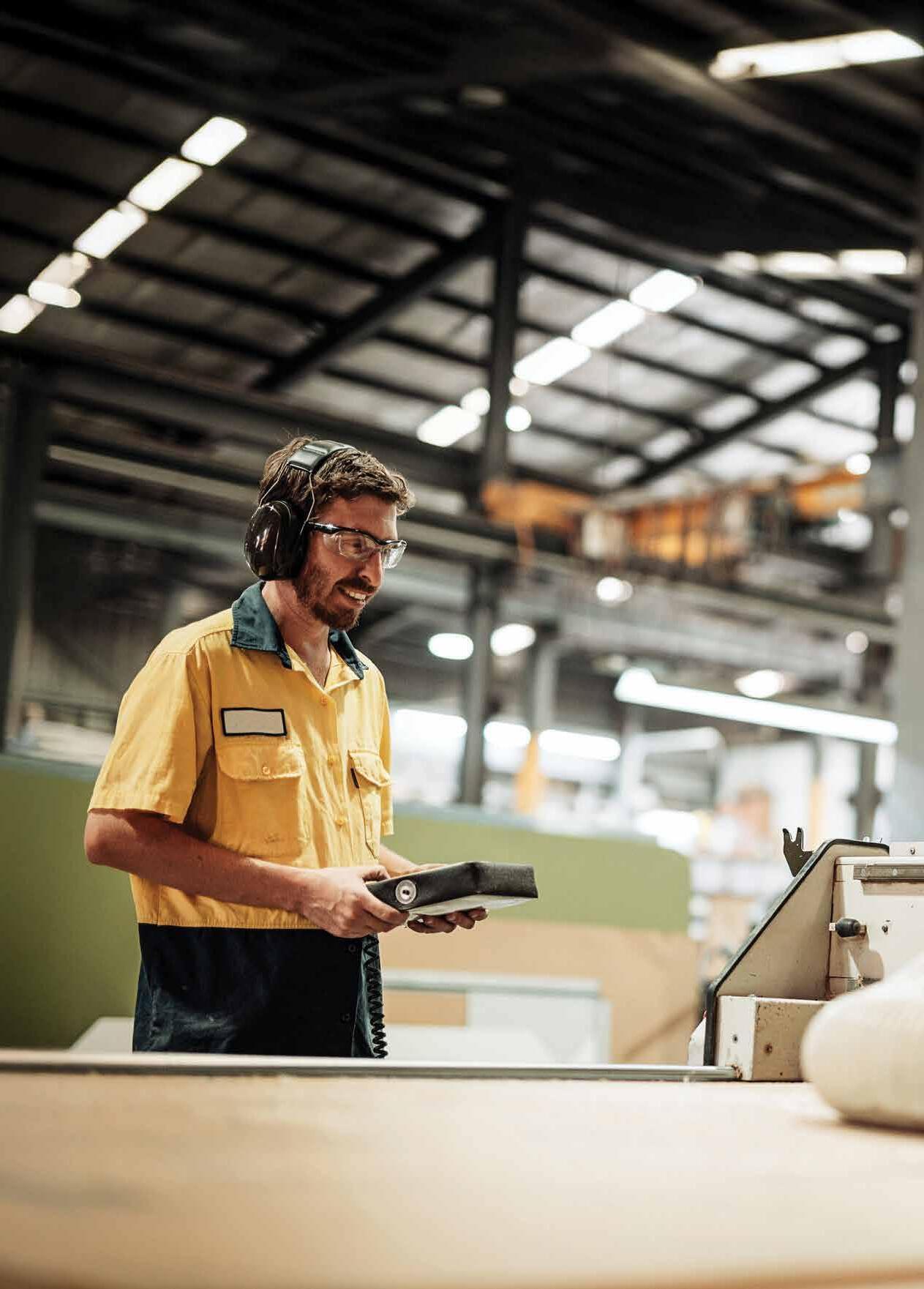
More women are working more hours in manufacturing, and careers are also getting longer, according to new research.
Automation has helped to open doors for women to move into manufacturing roles, according to new research prepared by the Australian Industry Group (AIGroup). AIGroup measured the number of hours worked by women in various industries using newly available microdata from the Australian Bureau of Statistics.
The research found that while industrial sectors such as manufacturing, mining and construction had the lowest share of hours worked by women, they were also leading the national effort in closing the gap. AIGroup research manager Colleen Dowling writes in a research note that most industrial sectors had seen an increase in the proportion of hours worked by women in the last 20 years.
The number of hours worked by women in manufacturing rose from 21.2% in 2006 to 25.2% in 2025, as did those in mining, from 12.6% to 17.7%, and construction – from 7.8% to 11%.
Dowling writes that little had changed in industries where most hours are worked by women, such as healthcare and social work at about 75% of hours worked by women and 70.8% in education – a reduction in balance compared to 2006, when women worked 65.8% of hours of all hours worked in education. “This means it is industrial sectors – and only industrial sectors – which are showing any progress in closing the gender gap in workforce participation. Why are these traditionally male industries doing most of the work?” Dowling writes.
In the research note, she notes a series of government and business policy initiatives to increase female employment, including gender improvement programs and apprenticeships for women. “Government measures such as reporting requirements and project tender criteria have put gender firmly on the agenda for many industrial businesses, impacts absent in non-industrial sectors,” she writes.
“Male-dominated sectors have faced a level of scrutiny and societal pressure to change that female-dominated sectors haven’t.” Dowling also adds the wider uptake of STEM subjects by women at the secondary and tertiary level has created a wider pool of candidates for technical roles.
“At the same time, ongoing skills shortages have pushed businesses to widen hiring searches. Increased technology adoption and automation has reduced the physical demands of some industrial jobs enabling a broader pool of people to participate,” she writes.
AIGroup head of research Jeffrey Wilson told AIGroup’s DBrief podcast that many Australian businesses had adopted automation and other new technologies in a bid to boost productivity.
“When a business goes down that Industry 4.0 route, they also, incidentally, lower some of those barriers to women's participation – they transform into higher skilled industrial roles that rely more on human capital than physical capital,” he says. “When you go through the Industry 4.0 process, you don't just improve safety and lower your costs, but you also lower that intrinsic barrier to women's participation by changing what it is that your industrial workforce is doing.”

“[This] is why we see those sectors having those big uplifts, because they're the ones that are really driving industrial technology in Australia,” he says. Wilson says that automation to reduce and automate manual handling was central to this change, adding that the increase of women was being driven by women over the age of 55 remaining in the workforce.
“Historically, people of that generation exited the labour market in retirement in their mid-50s. But what we’ve seen is that that workforce has been retained, and they’re able to work past 50, up towards the retirement age of 65,” he says.
“It’s not just the male/female aspect of physical jobs, but it’s also the young/old aspect of those physical jobs.”
Despite the broader improvements, Dowling wrote that she did not expect the gap in workforce participation between men and women to close for another one or two decades on present trends. “In early 2025, women comprised 47.9% of the labour force, a record level,” she wrote.
“The female share has been steadily trending up for the last two decades and is rising by around 0.15% per year.”
Dowling also notes that women are more likely than men to be employed part-time, adding that some would prefer to work more hours if given the opportunity and necessary support.
“This indicates a pool of available labour of staff that may already have the education level, skills and training – making them well-positioned to fill existing shortages,” she writes.
“Maximising the potential of existing employees, particularly women seeking more hours in industrials and men seeking more hours in education, health and social assistance, represents a practical solution for shortages.”
Elmo Software’s chief operating officer James Haslam looks at how smarter systems can turn safety into a competitive advantage.
There’s no escaping the subject of risk in manufacturing. Whether it’s steel, beverages, or electronics, risk mitigation needs to be tackled head on. Manufacturing workplaces are inherently complex: moving parts, heavy machinery, long shifts, and tight deadlines. In such environments, one small oversight can have serious consequences.
Safety isn’t just about avoiding accidents. It’s also about creating a culture that protects people, reduces risk, and strengthens business performance and compliance. For HR leaders, EHS professionals and compliance officers, workplace safety should be a central pillar of strategy.
Unsafe workplaces don’t only affect operations or compliance; they have real consequences for real people and their families. In 2023, Safe Work Australia reported that 200 workers lost their lives on the job. This stark figure is a reminder that workplace safety still falls short in too many environments. As Marie Boland, chief operating officer of Safe Work Australia, noted: “While Australia compares favourably to the rest of the world, the fact that 200 people did not come home from work in 2023 reminds us that we cannot afford to be complacent.”
Mental wellbeing is also a growing concern. Mental health conditions accounted for 10.5% of all serious claims in 2023. Elmo’s Employment Sentiment Index revealed that 28% of manufacturing workers reported feeling burnt out in the second quarter of 2025, while 33% attended work despite being unwell. The human impact is sobering. While risks can never be entirely eliminated, they should remain front of mind in shaping HR and business practices across manufacturing. The business and economic effects are equally significant. Safe Work Australia’s 2024 study estimated the national economy would gain $28.6 billion annually if workplace injuries and illnesses were eliminated. This would also support 185,500 additional full-time jobs and lift wages by 1.3% across all occupations. Monash University research added further weight, finding work-related injury, disease, and mental health conditions cost the economy 41,000 lost work-years per year, equivalent to tens of thousands of jobs. HR teams in manufacturing face unique pressures. Demand for workers is soaring—Elmo’s HR Industry Benchmark Report found that 89% of manufacturing and utilities employers expected headcount to grow—but skilled labour shortages, wage pressures, and the challenges of a deskless workforce complicate safe onboarding. New employees often arrive with varied experience, limited training time, and casual contracts, yet they are placed in high-risk environments from day one. On average, it takes 41 days for new hires in manufacturing to become fully productive, six days longer than the overall average. That lag is not just costly—it can also be dangerous. Without structured systems, safety risks quickly escalate.
Inductions are often rushed or incomplete, licences and certifications may go unchecked, PPE protocols are sometimes ignored or misunderstood, near-misses can go unreported, and mandatory training may be left incomplete or undocumented. These oversights present not just operational and compliance risks, but reputational ones as well. Effective onboarding is therefore a frontline safety measure, not a mere HR formality.
Training must also be targeted, accessible, and consistently maintained. With a mix of casual, seasonal, and shift-based staff, training can easily be overlooked or delayed. Tracking training through spreadsheets or emails only adds complexity. High-performing manufacturers are addressing this by using automated training reminders, role- and site-specific learning pathways, centralised tracking of completions, mobile training access for deskless teams, and dashboards to identify gaps. Such practices help embed safety as a cultural value, not just a compliance task.
Audits and investigations demand fast access to accurate records, yet without a centralised source of truth, safety and training data can be difficult to locate under pressure. To remain audit-ready, HR teams must ensure licences and renewals are properly tracked, policy acknowledgements and safety briefings are captured, compliance is monitored across all workforce types, and reports can be generated with confidence. With the right systems, compliance becomes part of daily operations rather than a last-minute scramble. For leading manufacturers, safety is woven through every step of the employee experience. Best practice involves onboarding new hires with safety-first workflows, automating training reminders, recording certifications centrally, providing mobile access to rosters and safety alerts, surfacing near-miss patterns through real-time reporting, and maintaining visibility across all roles and employee data. This integrated approach strengthens culture, protects people, and safeguards business outcomes. Workplace safety in manufacturing is not just about preventing the next incident—it’s about protecting operations and ensuring every worker goes home safe. With the right systems in place, safety becomes not a burden, but a competitive advantage.

JAMES HASLAM Chief operating officer at Elmo Software
GuardWare Australia general manager of business development Richard Matthewman says even if you suffer a cybersecurity breach, losing CAD files and other secure files isn’t inevitable.
Directors and business owners face an unavoidable reality: a cyber breach is no longer a remote possibility; it’s almost an inevitability. The question is no longer “How do I stop being breached?” but “How do I protect my most valuable intellectual property particularly, my CAD drawings, when it happens?”
Today’s manufacturing sector, like all industries, operates in an asymmetric threatscape. Defenders must protect their systems continuously, across every endpoint and network. Attackers, meanwhile, need only get lucky once. With ransomware-as-a-service, infostealer apps and AI-powered social engineering, even low-skilled criminals can break in cheaply and effectively.
The result: even companies spending millions on perimeter defences cannot guarantee safety, and the weakest link is people. AI has supercharged social engineering, making it easier than ever to exploit human emotions and trick staff into actions that put businesses at risk.
Just as car manufacturers learned long ago that accidents are inevitable, we must adopt the same mindset in cybersecurity. Cars are not built simply with stronger bumpers – they are designed with seatbelts, airbags, and crumple zones to protect passengers even when collisions occur.
Similarly, manufacturing businesses need to move beyond prevention alone. The focus must shift to protecting the data itself – ensuring CAD files, sensitive IP and other critical assets remain secure even if a breach occurs.
Now, it's possible to wrap your CAD files and other critical information in persistent, military-grade encryption while in use, all the time. So that even in the event of a breach, your CAD files and sensitive data remain secure and inaccessible to attackers.
Like modern vehicles protecting their passengers, this proactive security approach allows your business to “walk away” from a breach with its most important assets intact.
Data-centric security
We need a holistic approach with a combination of network (perimeter) security, patches updated, backups and the rest, but what is missing, and it is the most important component, is data-centric security (DCS).
The current Australian Defence Data Strategy 2.0 defines a DCS approach as one that focuses on securing data itself – not its container or storage location – whether it is at rest, in motion or in use.
DCS is all about protecting data regardless of the attack that occurs, whether you have a malicious insider threat, a ransomware attack or simply an employee leaving the company, your data remains secure, and you as the IP owner have control over that data.
For manufacturers this is particularly relevant to CAD files which represent thousands of hours of intellectual investment and competitive differentiation.

A DCS approach begins by:
• Discovering where critical CAD files are located across servers, workstations, and archives.
• Classifying them (e.g. confidential) to ensure proper handling.
• Monitoring their movement across the entire IT environment, not just M365 or SharePoint – and stopping unsanctioned transfers to USBs, Gmail or WhatsApp.
• Encrypting CAD files with persistent, military-grade encryption so they remain protected 100% of the time –even when in use, edited, or shared externally.
This level of file-centric security is no longer out of reach.
Australian innovator GuardWare, working with the University of New South Wales and supported by the Australian Defence Trailblazer program, has developed solutions that embed encryption directly into files. Security now travels with the data, rather than relying solely on networks or storage systems. This shift ensures that manufacturers retain authority over their IP—even beyond their own digital boundaries.
Business leaders should ask their IT teams or managed service providers about integrating data-centric security measures, starting with CAD drawings. By wrapping these files in persistent encryption, manufacturers can ensure their competitive edge remains protected, regardless of the evolving threatscape.
Just as fastening a seatbelt before driving is second nature, safeguarding design files should become standard practice. In doing so, manufacturers can change the rules of engagement—turning the inevitability of cyber breaches into survivable, manageable events.

RICHARD MATTHEWMAN General Manager of Business Development at GuardWare
Australia
Mattingly partner Anthony Hengel looks at the business case for new equipment and what decisions should guide your next upgrade.
Australian manufacturers are investing heavily in robotics, automation and digital platforms to drive productivity. But the real challenge isn’t just buying the equipment – it’s turning that investment into measurable business outcomes. From our work, we know success depends on how leaders plan, fund, and execute upgrades, and how they bring their people along for the journey.
The limits of capital equipment alone
Capital expenditure on its own doesn’t guarantee productivity gains. A new machine on the floor may look impressive, but without clear alignment to strategy, a sound business case and disciplined execution, it can quickly become a stranded asset. We have seen business make good investment decisions with the expectation that productivity will follow automatically. In practice, the results vary widely. The difference lies not in the technology itself, but in how well leaders move beyond procurement to embed the upgrade in their operating model.
Established firms often face three major barriers when trying to unlock the value of new technology. Integration is the first challenge, since new equipment rarely “plugs in” neatly. Older machinery and fragmented systems can turn integration into a costly and disruptive exercise. Competition for capital is another obstacle. Even where the return on investment is strong, major upgrades must compete with expansion projects, acquisitions, and debt reduction.
The business case has to earn its place in the capital allocation queue, and excitement about the technology alone is never enough. Cultural resistance can be just as disruptive. Operators and supervisors often view technology as a threat rather than a tool. Without early engagement and thorough training, resistance can quietly undermine adoption. These barriers explain why some investments never deliver on their promise, while others transform businesses.
These barriers go to explaining why some investments never deliver on their promise, while others transform businesses.
Turning investment into reality
So how do leaders move beyond the capital spend and make the upgrade pay? Success comes down to three interrelated moves. First, investment must be anchored to strategy. Technology needs to solve real problems such as overtime blowouts, scrap rates, or customer lead times. Stress-testing the business case against strategic priorities ensures that the link is clear, preventing “shiny toy” purchases and ensuring that benefits are tangible and defensible.
Second, implementation should be treated as a transformation rather than a procurement exercise. Buying equipment is straightforward; embedding it successfully requires disciplined execution. Clear milestones, rigorous planning, pilot programs, and strong governance reduce risk while helping leaders and staff navigate the journey and see real returns delivered. Finally, the workforce must be engaged early. Machines don’t lift productivity on their own—people using them effectively do. Training before rollout, celebrating quick wins, and framing upgrades as upskilling opportunities all build buy-in. Projects
move faster and adoption is smoother when operators feel ownership rather than imposition. The good news is that none of the barriers are immovable.
Leaders can pull practical levers:
The barriers to successful transformation are not immovable, and leaders have practical levers at their disposal. On the capital front, a clear plan that navigates the prioritisation process and weighs a range of investment decisions creates a roadmap to success. On the operations side, planning around scheduled shutdowns and staggering upgrades across lines keeps production running while new systems bed in, reducing risk and spreading implementation resources. Culturally, upgrades should be positioned as growth-enabling. By highlighting new technical roles and career paths, leaders can transform technology from a perceived threat into an attractor for talent and long-term success.
The next decade will see consolidation and continued cost pressure across all firms. Businesses that delay upgrades risk being left behind – higher unit costs, stranded assets, and difficulty attracting skilled talent.
Those who move decisively, and execute well, gain stepchange improvements in productivity, margin, and resilience. Technology is not optional. But capital equipment alone doesn’t create outcomes. Strategy, disciplined execution, and cultural adoption do.
For leaders considering a major upgrade, three questions should guide decision-making. Is the investment anchored to strategy, rather than a supplier’s sales pitch? Is there a plan in place to de-risk implementation and prove outcomes early? And has the workforce been engaged so that people come along the journey and feel part of the success?
At Mattingly, we work alongside our clients as they go through major change – this could be setting strategy, making key investment decisions, looking at strategic acquisitions or managing transformations to deliver a more competitive business. All this is done with a practical lens of experienced industry professionals to guide you and your team along the way.

Consistent, thorough records management helps companies keep tabs on employee training and skills management without the chaos, OneCard Founder and chief executive Kareena Waters says.
If you work in manufacturing, you probably remember when an audit was an occasional interruption.
These days, they can come from all directions — ISO accreditations, client compliance checks, safety spot audits and regulator visits.
They all want one thing: Evidence – clear, accurate, up-to-date employee training and competency records.
But for many manufacturers, providing that evidence is harder than it should be. Fragmented systems, outdated processes and a lack of fit-for-purpose tools mean that record-keeping often turns into an administrative nightmare.
As manufacturing companies embraced HR digital tools, the focus naturally landed on high-impact systems: HR, safety, LMS, payroll, and rostering. These platforms were often described as “must-have tech” – flashy, expensive systems with strong business cases and instant visibility.
But somewhere along the way, training and skills management got left behind. Instead of investing in a dedicated system, businesses tacked on basic training plug-ins to existing software, designed to store outcomes, send alerts, and tick a few boxes.
These plug-ins might look functional, but they weren’t designed to handle the real complexity of workforce training, inductions, license and training tracking and compliance workflows.
The result? Records are scattered across departments in silos: HR has one version, safety has another, rostering has theirs, and managers keep spreadsheets just to get by. There’s no consistency, no data integrity and certainly no single source of truth and no operational transparency.
Fragmented training records don’t just create double handling, they expose businesses to new risks.
When a business can’t prove who’s trained, licensed and competent, they risk:
• Failing to comply with ISO standards
• WHS breaches, by assigning unqualified workers
• A lack of evidence for insurance claims
• Production delays due to missing or expired tickets
• Penalties, reputational damage and contract loss
Even worse, access to live data is often restricted to HR, safety or administrative staff, leaving frontline leaders guessing. This slows decision-making and forces company leaders to create workarounds, further compounding the problem.
And when audits roll around, teams scramble to pull together paperwork from multiple systems, file shares and inboxes, wasting valuable time and often revealing inconsistencies that raise red flags.
Transforming operational transparency in manufacturing
In 2021, Onecard was approached by a large manufacturing company that was manually managing its external training requirements, costing time and creating inefficiencies.

However, the real challenge lay in the lack of visibility over internal training, particularly relating to Work Instructions (WI) and Safe Operating Procedures (SOP) across multiple production lines and machinery.
This is a common issue in the manufacturing industry, where audits require evidence of competency that goes far beyond certificates from external training providers.
Internal and on-the-job training, based on working instructions and in-house procedures, is often critical but poorly tracked.
To resolve this, the Onecard team conducted a comprehensive data cleanse of both current and historical records, and worked closely with the management team to:
• Develop clear role profiles
• Set up naming conventions that mirrored the company's work instructions and safe work procedures.
• Converted over 1,500 work instructions and safe operating procedures into meta tags skills sets
• Helped streamline documentation so the client had a consistent method of capturing evidence
This provided instant visibility for leaders to know who had been trained, assessed and deemed competent as an independent operator.
Since then, the company has earned best practice recognition in every audit, with its frontline leaders enjoying real-time visibility of projects, removing the stress and scramble of audit prep.
Designed and built in Australia, Onecard does more than store records. It brings structure, visibility, and peace of mind to the frontline, meaning employers can stop chasing spreadsheets and start showing real evidence of workforce capability, instantly.

KAREENA WATERS Founder and CEO at OneCard
It pays to optimise your processes and practices before expanding or bringing an external investor on board, says ECI Solutions vice president - APAC, manufacturing division Andrew Mamonitis.
Despite challenging conditions, manufacturing businesses are looking for ways to grow their share of the domestic market and pursue potentially lucrative export opportunities.
A low Australian dollar, coupled with our country’s reputation for quality and reliability, is making it easier for some manufacturers, particularly those in the agri-business sector, to get an ‘in’ to new markets, both in the Asia Pacific and further afield.
Taking advantage of an opportunity to diversify your range or expand your customer base generally means upfront investment is required. You may need to acquire new equipment or additional inventory, for example, take on extra staff, or run marketing and business development campaigns. Unless your business has a sizeable sum stashed away, that means borrowing from the bank or bringing an external investor on board.
But before writing a cheque, or approving a loan, any potential backer will want to see evidence that your sales are strong, your business is profitable and you’re running a tight ship. If you’re not able to demonstrate that you have efficient systems and processes in place, and a solid pipeline of work, you may find it tricky to secure the funds you need to grow.
Presenting your business in the best possible light starts with showing you’re on top of your finances. Up-to-date accounts, accurate forecasting, rigorous revenue management and a strong understanding of your cash flow are all essential.
So is visibility into your customer base. Being able to identify your largest and most profitable accounts and supply a detailed picture of their buying behaviours builds credibility, as does knowing which of your customers are tricky to manage or late payers.
Firing on all cylinders on the factory floor
Also vital: proving your business will be able to produce the goods, on time and on budget, as it scales up.
That entails understanding your production capacity and maximising the efficiency of your machinery and equipment. You’ll also need a means of monitoring productivity and output, on every production run and shift, to ensure all your employees are working productively.
Meanwhile, having scheduling and stock control systems in place tells outsiders that bottlenecks and delays are less likely to occur and that inventory costs are optimised.
Muddling along in manual mode
Demonstrating your business is a sound bet can be tricky if you’re operating in manual or semi-manual mode, as many small and medium sized manufacturers continue to do. The use of spreadsheets and paper-based systems remains common, as does excessive reliance on owners and longterm employees who know how things are always done, rather than on well documented processes and practices.
Having key financial and operational data stored across disconnected systems – and important intellectual property stored in the heads of your team – can make it hard to obtain the insights you need to optimise your operations.
And unless that data is consolidated in a ‘single source of truth’, at your fingertips in easily accessible form, providing potential backers with a precise picture of your position can be an impossible ask.
Tools to make the task easy
That’s where cloud-based enterprise resource planning (ERP) software has a vital role to play.
Abandoning legacy processes and practices and migrating all your operational and financial data to a single solution – one that’s been developed with the unique requirements of the manufacturing industry in mind – can help you optimise every aspect of your operations.
You’ll be able to maintain accurate, up-to-date visibility of how your business is tracking and harness the power of AIpowered analytics technology to identify emerging issues.
From improving the utility of your plant and equipment and managing your stock levels to accelerating your cash flow, you’ll be able to eliminate the inefficiencies that impede productivity and drag down profitability.
And, having done so, you’ll be able to provide external parties with all the evidence they need to buy into your vision for growth.
Laying the groundwork for growth
Seeking external funding has been part and parcel of the growth journey for scores of successful manufacturers. Securing the confidence of potential backers is simpler when you’re able to show them your business is an efficient, wellrun affair.
ERP technology that enables you to monitor and manage every aspect of your operations is an investment that will stand you in excellent stead when trying to take your enterprise to the next level.

ANDREW MAMONITIS Vice President – APAC, Manufacturing Division at ECI Solutions
SYSPRO head of services for the Asia Pacific James Robinson discusses how balancing stock levels can help companies weather trade tariff challenges.
Supply chains that once operated predictably are now disrupted by shifting trade agreements, geopolitical tensions, currency fluctuations and sudden tariff changes. For manufacturers and distributors across Australia and the broader Asia-Pacific region, these factors have redefined the rules of inventory management. The challenge is no longer just about keeping enough stock on hand to meet demand; it’s about finding the optimal balance between cost, resilience and agility in a market where external pressures can change overnight.
The tariff tightrope
Trade tariffs are one of the most disruptive variables in global supply chains, directly impacting the cost of imported raw materials and finished goods. Sudden tariff increases erode margins, inflate costs and disrupt sales through higher prices and industry bottlenecks. Over the past five years, businesses have seen tariff changes arise from global trade disputes, new trade agreements and economic sanctions. The unpredictable nature of these changes means traditional, static inventory models, which rely on fixed supplier relationships, lead times and cost assumptions, are no longer sufficient.
Having the right stock in the right place at the right time is a strategic defence mechanism in a tariff-impacted market, not simply a cost-control measure. Effective inventory optimisation allows businesses to avoid overstocking, prevent stockouts of critical items and respond quickly to tariff-related cost changes with alternative sourcing and distribution strategies.
The role of ERP
Cloud-enabled Enterprise Resource Planning (ERP) systems, like SYSPRO, play a pivotal role in enabling this agility. They provide real-time visibility of inventory, suppliers, costs and demand – crucial when tariff changes require quick decisions. Modern ERP platforms are equipped to integrate tariff data directly into landed cost calculations, delivering accurate insights into profit margins. They can also run scenariobased simulations to model the impact of tariff changes on sourcing, pricing, and stock levels. Automated replenishment triggers further align orders with updated forecasts and cost structures, while multi-location inventory visibility allows businesses to reposition stock strategically and avoid tariffheavy routes or ports.
Successful inventory optimisation in the face of tariff volatility rests on a combination of forecasting, diversification, and risk mitigation. By integrating market intelligence, supplier information, and broader economic indicators, these businesses can react more quickly when tariffs are introduced or trade policies shift.
Diversification of suppliers and sourcing regions has also become essential. Dependence on a single supplier or country leaves businesses dangerously exposed. By spreading procurement across multiple regions, organisations can reduce vulnerability and shift orders towards markets where tariffs are lower or less volatile. Alongside this, segmentation of inventory allows companies to treat products differently based on revenue contribution, lead times, or tariff exposure.
High-margin, fast-moving products may justify holding larger buffers, whereas slower-moving items or those at greater risk of tariff increases may require leaner stock strategies.
Safety stock has traditionally acted as insurance against uncertainty, yet excessive buffers can trap working capital and increase storage costs. ERP-driven safety stock optimisation offers a more sophisticated solution, with stock levels adjusted dynamically according to real-time sales data, lead time variability, and tariff conditions. Collaboration has also emerged as a cornerstone of resilience. By sharing information on tariff impacts and forecasts with suppliers, distributors, and even customers, companies create a more adaptive supply chain. ERP-supported collaboration platforms make it possible to improve lead time accuracy, reduce unwelcome surprises and align planning across partners.
In Australia, tariff volatility has been particularly evident in sectors such as automotive components, industrial machinery and electronics – where manufacturers could suddenly face a ten per cent tariff on a critical part from one supplier. Without cost visibility and flexible sourcing, manufacturers risk absorbing costs, eroding margins, or passing it on to customers. With ERP-enabled inventory optimisation, the same manufacturer can instantly run cost-impact scenarios, identify alternate suppliers, adjust purchase orders and update sales pricing to reflect new realities, all before the increased costs are felt on the bottom line.
While trade tariffs will continue to ebb and flow due to the current geopolitical environment, Australian businesses can strengthen their resilience through proactive inventory optimisation. In today’s volatile market, the difference between reactive and proactive inventory management is stark. Reactive businesses wait for tariffs to hit and scramble to adjust. Proactive businesses anticipate changes, model scenarios and take pre-emptive action to protect margins and customer satisfaction.
By embracing advanced ERP capabilities and a data-driven approach to inventory optimisation, Australian manufacturers and distributors can not only weather the storms of tariff volatility but turn them into opportunities for competitive advantage.

JAMES ROBINSON Head of Services for the
Integrating the priorities of people and planet has become not just an ethical imperative, but a strategic necessity for industry, says AR & Associates creative director Ella Averill-Russell.
In today’s rapidly evolving industrial and engineering landscape, businesses must balance technological advances with a commitment to sustainability, ethical responsibility and social well-being.
People are at the core of every design and marketing strategy. Engineers must prioritise solutions that enhance safety, usability and efficiency. In sectors such as mining, businesses must consider their long-term impact on communities and the environment, aligning with the UN Sustainable Development Goals. For example, advanced automation systems in mining now optimise operational efficiency and prioritise environmental restoration and worker safety, improving the quality of life for present and future generations.
Enacting a people-centric approach begins with the workforce. Industries must prioritise employees’ safety, wellbeing and professional growth by fostering diversity, creating inclusive environments and offering upskilling opportunities for emerging technologies. As automation and artificial intelligence reshape industries, supporting employees in adapting to these changes is both a moral and business imperative.
Preparing future generations is equally crucial. Introducing science, technology, engineering and mathematics (STEM) education at primary school level fosters curiosity and builds foundational skills, while engineering workshops and industry partnerships help prepare a workforce to navigate the industry’s evolving landscape.
Industrial growth often comes at an environmental cost, creating challenges such as climate change, resource depletion and pollution. Engineers play a vital role in designing solutions that minimise environmental impact, incorporate renewable energy sources and adopt circular design principles.
Emerging technologies have revolutionised resource management. Smarter industrial hardware and software solutions enable real-time measurement, prediction and control of variables. Advanced sensors and automation tools allow manufacturers to monitor resource usage, identify inefficiencies and implement swift corrective measures. These innovations reduce emissions, waste and energy consumption while meeting rising sustainability and operational excellence demands.
Cleaner energy is central to sustainability efforts. Advancements in solar panels, hydrogen fuel cells and wind energy drive the transition to greener systems. In parallel, the exponential rise in data centres and AI-driven infrastructure has reignited discussions around nuclear power as a scalable, low-emissions base-load solution. Next-generation nuclear technologies offer potential to meet these demands reliably, while supporting decarbonisation.
Many businesses are turning to carbon credit offsetting to complement their direct emissions reduction efforts –investing in reforestation, biodiversity conservation and renewable energy projects. When integrated into broader sustainability strategies, these efforts contribute to long-term environmental goals.
However, meaningful climate action must begin with reducing emissions at the source through innovation, efficiency and smarter design. The industry serves as the backbone of global economies, fuelling infrastructure, innovation and livelihoods. Engineers drive progress by developing smarter, faster, and more adaptable systems. Industry 4.0 technologies, including automation, artificial intelligence and IoT, have revolutionised traditional practices, enabling unprecedented efficiency and precision.
However, progress comes with responsibilities. Industries must address concerns around data security, ethical AI and equitable access to technology. Engineers must design systems prioritising safety and fairness, while marketers emphasise societal and environmental value.
Collaboration is key. Stakeholders—from private companies to governments and academic institutions—must work together to tackle supply chain optimisation and decarbonisation challenges. These partnerships can accelerate innovation and scale impactful solutions.
Harmonising people, planet and industry requires shifting from short-term gains to long-term impact. Transparency and authenticity are crucial to earning trust and transforming businesses into meaningful movements.
This balance is especially critical as industries confront the dual challenge of rising digital energy demand and climate action—requiring bold energy diversification strategies, transparent carbon accountability and long-term infrastructure planning.
The industrial sector has a unique opportunity to lead by example. By embracing innovation that serves humanity and the environment, industries can redefine progress for the 21st century. Together, engineers and marketers can shape a future where technology drives economic growth and social and environmental well-being.
As we look ahead, integrating people, planet, and industry will be the foundation of enduring success. Achieving this balance requires courage, creativity, and collaboration. But the rewards promise a more sustainable, equitable, and innovative future for all.

ELLA AVERILL-RUSSELL Creative Director at AR & Associates.
OneAdvanced head of people management solutions Damien Durston looks at ways to meet labour obligations in 24/7 shift-based supply chains.
In Australia’s manufacturing logistics and distribution sectors, compliance with labour laws is not optional. These industries are built on 24/7 operations, round-the-clock shifts and large workforces whose productivity is essential to the country’s economic competitiveness. Yet the complexity of managing compliance in these environments leaves organisations highly exposed to risks. From wage theft claims and union disputes to fines from the Fair Work Ombudsman, compliance failures are making headlines with increasing regularity. Companies that fall short of their labour obligations risk reputational damage, legal battles and strained employee relations. For supply chain operators already under pressure from rising costs and global uncertainty, compliance failures are an avoidable distraction.
In manufacturing and logistics, where workforces are large and shifts are complex, the chance of non-compliance is significantly higher. Governments, unions and employees are increasingly vocal about pay transparency and fair treatment. Organisations that fail to meet these expectations risk more than fines; they risk their social licence to operate.
The top five compliance risks in shift-driven supply chains are:
1. Missed break entitlements: In 24/7 operations, it is easy for managers under pressure to overlook mandated rest and meal breaks. Repeated breaches of break entitlements can expose businesses to huge penalties and fatigue-linked safety risks.
2. Incorrect award interpretation: Australia’s system of awards and enterprise agreements is notoriously complex. Inconsistent or manual interpretation often leads to errors in penalty rates, overtime and allowances.
3. Overtime mismanagement: Excessive overtime without appropriate remuneration breaches employment law and increases the likelihood of fatigue-related incidents.
4. Inadequate record-keeping: Failing to maintain accurate records of hours worked, leave accrued and entitlements paid makes compliance audits more difficult and riskier. Practices such as buddy clocking (when one employee clocks in or out for another) further compromise data accuracy, leading to payroll errors and greater exposure to compliance breaches.
5. Casual and contract misclassification: Misclassifying workers or failing to correctly apply entitlements for casuals and contractors has been a key issue in recent Fair Work cases.
These risks are amplified in supply chain environments where demand volatility requires constant adjustment to rosters and staffing levels.
Auto-rostering in manufacturing
For manufacturers, auto-rostering represents one of the most impactful applications of digital workforce management. The sector’s continuous operations, heavy machinery and potential safety hazards mean that fatigue management is critical. Errors caused by tired or overworked employees can have serious consequences for both safety and productivity.
This is where digital workforce management tools come into play. By automating compliance checks, ensuring award accuracy and delivering transparent audit trails, these systems are fast becoming essential to governance in shift-based industries.
Auto-rostering uses algorithms to simplify the creation of equitable and compliant shift schedules. These systems can be built to accommodate fatigue guidelines and to note the skills and certifications essential for a worker to work certain shifts. They can also accommodate legal obligations under awards and agreements and any other worker preferences. By balancing operational requirements with employee wellbeing, auto-rostering not only reduces compliance risks but also improves workforce satisfaction. Employees who feel their preferences are considered are more engaged and less likely to experience burnout.
Why manufacturing stands to gain the most Manufacturing and distribution in Australia remain two of the most labour-intensive sectors. Despite the automation of production lines and warehousing, human input is still central to operations. This reliance on people creates both risk and opportunity. By adopting integrated digital workforce solutions, manufacturers and distributors can improve their compliance with labour laws, reduce the risk of wage theft claims and union disputes and gain real-time insights for better decisionmaking. This strategic approach to workforce management does more than save time and money. It fosters a more dynamic and productive workforce, setting the foundation for sustained success in a highly competitive global market.
Proactive governance through digital tools
The lesson from recent compliance cases is clear: manual processes and legacy systems are no longer fit for purpose in highly regulated, shift-driven industries. Digital workforce management platforms are not simply operational tools. They are governance enablers. By embedding compliance into everyday workforce processes, these platforms help manufacturers and distributors move from reactive firefighting to proactive governance. The result is a supply chain that runs efficiently, treats employees fairly and withstands scrutiny from regulators and the public.

DAMIEN DURSTON Head of People Management Solutions
How an offsite Virtual CFO can help give your manufacturing operations a strategic edge, with William Buck principal Jeremy Raniti and senior manager Karly Whitehead.
For many growing manufacturing businesses navigating the volatile path from ideation to commercialisation, the focus is largely on product development and market entry. Financial management, while critical, is often a secondary consideration. Most growing businesses don’t yet require or have the budget for a full-time Chief Financial Officer (CFO). This is where a Virtual CFO (VCFO) or fractional CFO – a finance professional who performs a CFO’s duties on a remote, part-time basis – becomes an invaluable asset.
A VCFO provides the strategic financial leadership a scaling company needs, but on a flexible and cost-effective basis. By engaging a VCFO, growing businesses can ensure strategic financial decisions are made from day one.
One of the most pressing questions for any founder is: when will we need to raise more capital?
A VCFO directly addresses this by establishing robust budgeting and forecasting processes, helping businesses manage spending, track performance and achieve greater visibility over its financial position by understanding exactly where funds are spent. Investors will demand transparency, financial discipline and accountability and a well-structured budget is the primary tool for demonstrating this. Manufacturers must account for fluctuating raw material costs, supplier payment terms, and inventory holding expenses, all of which impact cashflow.
A detailed budget is the foundation for an accurate cashflow forecast. This forecast is essential for managing burn rate and identifying potential funding gaps well in advance, allowing founders to be proactive rather than reactive in their capital raising efforts. It provides a clear runway and empowers the leadership team to make informed decisions about burn rate and strategic investments.
Beyond the day-to-day financial management, a VCFO plays a pivotal role in shaping a growing business’s overarching financial strategy. This involves setting clear short, medium and long-term objectives, and aligning the company’s financial plan with its ambitious growth targets.
A VCFO’s strategic contributions include:
• Developing sophisticated financial models to support funding rounds and present a compelling case to potential investors.
• Clearly communicating financial performance and projections to the board and external stakeholders, ensuring the narrative is consistent and credible.
• Assisting in strategic resource planning to ensure capital is allocated efficiently across product development, hiring, marketing and operations.
They act as a critical partner during key growth phases from seed funding through to series A and beyond. Their guidance helps the company scale with clarity and confidence, avoiding common financial pitfalls that can derail a promising tech venture.
Businesses that overlook their regulatory obligations risk significant penalties and reputational damage, as these matters are scrutinised during a due diligence process and will often impact the company’s ultimate valuation. A VCFO can help ensure the company stays on top of its commitments to governing bodies and stakeholders.
This includes managing compliance related to:
• Australian Taxation Office (ATO) obligations such as tax returns, Business Activity Statement (BAS) lodgements and payroll compliance.
• Australian Securities and Investments Commission (ASIC) requirements.
• Other relevant regulatory bodies
While a VCFO may not personally handle every lodgement, they generally help oversee the entire process. They ensure compliance is managed correctly, implement systems to track deadlines and connect the company with the right accountants, tax advisors or legal professionals when specialised advice is needed.
A VCFO elevates the quality of financial communication. They prepare professional board-ready financial reports and investor packs that go beyond raw data. These reports provide actionable insights, key performance metrics and a clear narrative that contextualises the numbers. This supports effective governance and strengthens investor relations by maintaining a high standard of transparency and clarity.
A VCFO delivers the financial rigour and strategic foresight your tech company needs to succeed. They provide the framework for sustainable growth, allowing you to focus on innovation.
If your company is ready to build a strong financial foundation, talk to a William Buck manufacturing specialist today. William Buck is a leading firm of accountants and advisors, williambuck.com


48 Global Thinking – How two Australians built a leading global manufacturer – ANCA co-founder Pat Boland gives his advice for the next generation.
50 Confidence Plan – An ability to perform multiple high-end tasks around the clock has drawn Redline Engineering into a new investment it says is the most significant in its history.
52 Geared up for a change – Facing a heavy backlog of work and a globally competitive industry, the team at Ronson Gears moved to a new CNC machine – and hasn’t looked back.
54 Bubble Economics – How Air Liquide’s pure oxygen technology helped breathe life into a major land-based aquaculture project.
56 Artificial Eyes – Managing director of Kaeser Australia and Kaeser Measuring Technology Australia Jarno Manzke looks at the ways improving measurement technology is changing compressed air systems.
58 Manifold Destiny – A new machining centre is leading to round-the-clock operations for Hydraulic Controls
59 Eyes on the Prize – Cloud-based welding production management software WeldEye is a key asset for one Tasmanian manufacturer.
60 Hometown Glory – W ith an expanded Newcastle manufacturing centre and a new WA arm, premium suspension components manufacturer Lovells Group is celebrating its 95th year in style.
61 Racing ahead with Har nessing operations – A move into cable assemblies, servo assemblies and cable chains for Lapp Australia.
62 Cooking up solutions – Boosting local manufacturing and helping ease remote housing difficulties in one fell swoop.
63 To What End – The team at Seco Tools discusses modern solid carbide end mills – how they’ve evolved and how they’re best applied today.
64 Helpful addition – Hyperion Systems aims to use funds from a recent government grant to put its mobile 3D printing system to work, out on the road.
64 Finishing touch – The Boston Micro Fabrication microArch S150 benchtop 3D printer from AXT offers high resolution printing.
65 Not so prototypical – 3D printing has become the unlikely cause of a major boost in productivity for an Australian original equipment manufacturer.
66 Design Freedom – A novel approach to microscale 3D printing could create new opportunities in electronics, photonics and high value manufacturing
67 Pearls of W isdom – a mission to boost oyster populations in inner Sydney could lead to 3D printed seawalls being established worldwide, if the vision of the BioShelters team comes to fruition.
68 The new Cor nerstone – MEX Engineering Group founder Russell King explains how additive manufacturing is shaping the future of the Australian manufacturing industry.
69 Accessible Automation – Fresh from winning “Best Product” at intralogistics trade show LogiMat2025, Knapp’s Aerobot range has now debuted in Australia.
How two Australians built a leading global manufacturer—ANCA co-founder Pat Boland gives his advice for the next generation.
In the world of advanced manufacturing, few Australian companies have achieved the global reach and reputation of ANCA. Founded in 1974 by Pat Boland and Pat McCluskey, ANCA has grown from a local startup to a world leader in CNC tool grinding machines, with a legacy of innovation and customers spanning the globe.
As a leading manufacturer, ANCA co-founder Pat Boland knows that in a changing world some constants remain – the need for vision, adaptability and an ongoing focus on people.
“The world is very different now, compared to what it was when we started – and possibly the biggest changes have been in communications,” he says. “When we started our exports the Telex was the top method of communication internationally – and then what a fantastic invention the photocopier and fax machines were.”
Today, with the accessibility of the internet and new artificial intelligence, Boland says the concept of a “home market”, partially isolated from the rest of the world, is gone.
“You can communicate effortlessly throughout the world … but it also is a challenge in the sense that everybody else can exploit that communication as well,” he says.
“So I think the key element to our success is to pursue the world market – don’t really worry about the local market –though exploit it if you can… the world market is where the volume and returns will be.” It was a lesson that Boland and his co-founder, Pat McCluskey, learned early – when the first of the recessions of the 1980s hit the nascent company hard.
“We didn’t get a single order for six months, which taught us an awful lot about doing business,” Boland says. This crisis forced a pivotal decision: to look beyond Australia’s small market and focus on global opportunities.
The two men had founded ANCA in 1974 after meeting at an ammunition factory in Footscray, Melbourne, and deciding to combine Boland’s mathematics and software expertise with McCluskey’s practical engineering know-how.
With this change in circumstances, ANCA moved beyond its initial business of fitting CNC controls to machine tools.
“We were building computer controls where you had to find somebody who had a machine that they wanted to control –and there weren’t that many in Australia, and it is very difficult to export,” Boland says. “The Australian market was too small for our sort of speciality. We had to really try and look globally if we were going to survive.”
ANCA’s leap into overseas markets, particularly the United States, was a turning point. By partnering with fellow Australian company Laser Lab and leveraging existing infrastructure, ANCA established a foothold in Detroit’s manufacturing heartland.
This later led to the opening of ANCA’s first overseas branch in Novi, Michigan, in 1986, before later expansions into England, Germany, France and Italy, with the company’s first China office opening in 2004. But global expansion was only part of the equation. Innovation became ANCA’s hallmark.

The company shifted from making OEM computer controls to developing end-user products, most notably CNC tool grinding machines. “Our technology has been a key part of our success. If we don’t have something to offer our customers which is in some ways better than the local competition, we’re not going to be successful,” Boland says.
Today, ANCA is renowned for its cutting-edge solutions, including its Ultra range, producing endmills and other cutting tools of high accuracy and quality. “There’s some deep underlying technology we’ve developed which has been giving us fantastic performance results with our machines – and getting that across our entire product range and fully exploiting it in the market is our major current effort,” he says.
But even going back to the pivot from OEM to end-user products and ultimately into CNC tool grinding, Boland says a connection with customers is what has driven the company’s decision-making processes.
“I’m trying to think of an occasion when it wasn’t people at exhibitions approaching us directly, or our sales people finding an unfulfilled need, or an area where our expertise can be applied,” he says. ANCA’s willingness to diversify has always been guided by customer demand, and in meeting that demand, ANCA invests heavily in pre-sales and after-sales support for customers worldwide, striving to “look as much like a local company as possible.”

Whether in Germany, the US, or Australia, the goal is to provide the same high level of service as local competitors.
“It’s not easy, but it’s something we aspire to,” Boland says.
That said, Boland adds that the company is proud to keep its home base in Australia. “We are actually an Australian company – the owners are Australian, our key engineering functions and marketing functions are all done locally,” he says. “That’s where we are, and to give that up, that is not something which has ever made sense.”
For ANCA, success is as much about people as products. The company’s apprenticeship program, officially launched in 2011 after the company took on its first apprentices in 1987, is a testament to its commitment to staff development.
“A number of our key managers actually started as apprentices,” Boland notes. “It gives you the opportunity for really training staff exactly how you want them to be trained.”
Boland believes that providing a satisfying, challenging environment is key to retaining talent. “It’s a challenging technical area where they can use their skills, develop their skills, and continue to develop their skills,” he says. Embracing new paradigms like AI and offering ongoing training ensures that staff remain engaged and innovative.
The same is true for ANCA’s new 2025-2030 Sustainability strategy, launched in July, which has seen the company
commit to reducing its Scope 1 and 2 greenhouse gas emissions by 42% by 2030 from a 2023 baseline, and to cutting Scope 3 emissions by 25% in the same timeframe.
“In particular in Europe now it’s becoming sort of a mandatory requirement,” Boland explains, likening the shift to the rise of safety standards decades ago.
“You don’t have a choice. You really have to go down that path, apart from being what you want to do from a sustainability point of view. It’s a key part of being in the market in the future.”
Looking back, Boland says his greatest pride comes from seeing ANCA’s machines in factories around the world, from China to Germany to the USA.
“We had our 50th celebrations last year, and at one of the gatherings we had in the USA, we had a customer come to us and say he’d built his business on ANCA machines – and because of our product, he and his family had been able to live the American Dream,” Boland laughs.
“It’s great to visit a customer in Germany and see 30 of our machines in the line all working… seeing happy customers in Japan, in Switzerland, in the USA – and to pick up an iPhone and know that we played a part in the supply chain of an iPhone or iPad or Samsung phone, it’s great – highly satisfying,” he says.
An ability to perform multiple high-end tasks around the clock has drawn Redline Engineering into a new investment it says is the most significant in its history.
A strong sense of confidence in Australia’s precision engineering future has encouraged Redline Engineering to invest in a new 11 pallet, 5-axis Okuma CNC vertical machining centre. The model MU-5000V & Tower APC with OSP-P500MH control is the first of its type – a 5-axis machining centre with a Tower APC an automatic multi pallet system – to be installed anywhere in Australia.
Redline general manager Ken Stuart says he is confident his business will continue to grow manufacturing of its precision engineering components, due in part to the high regard in which Australian manufacturing is held around the world.
This high regard is due both to its quality and the on-time delivery that companies generate, he says. “The service aspect, I think, is becoming really important,” he says.
“Whether it is the culture we have or the way that we engage with the market, you get a sense there's a really strong passion for what we do – solving problems, being innovative, connecting to opportunities – and really putting a lot of effort into doing that.” A part of that proactive approach is investing in the latest technologies, he says, hence the decision to invest in the new 5-axis Okuma machining centre.
“Australian capability shines on the global stage and the new Okuma machining centre gives us flexibility, with many more features that will give us reduced lead times, provide greater efficiency and enable us to access new work such as security and other high precision industries which are becoming critically important,” he says. “You have to be investing in the right capabilities to engage in new opportunities… the companies that haven't progressed and invested to take their capabilities further are starting to feel the pressure of how to continue to grow their business.”
Located in Melbourne’s southeast, Redline Engineering has almost 60 years of experience in precision engineering components and assembly supply chain in the aerospace, automotive, high end medical, mining, motorsport, rail, heavy industry and transportation sectors. Quality accredited to AS9100D, ISO9001:2015 and CAGE Code Z2H07 standards, Redline says its market is nation-wide and expanding with direct and indirect export sales. The company produces precision components in all metals plus engineering plastics with a full-time staff of 28, including its own metrology department with both optical and conventional programmable CMM measurement and testing.
Stuart says that if an employer wants to attract and retain high-quality staff, then it is important for them to have the most up-to-date equipment possible.
“The addition of this advanced technology Okuma machining cell has provided our engineering personnel with high levels of confidence in the future for the company and an air of excitement in the opportunity to keep ahead of technological advances in machine capability and programming,” he says.
The provision of Sovereign Capability Grants and other Federal Government support for manufacturing in Australia had helped the company advance its precision manufacturing capability and become more internationally competitive, he says.
…confident his business will continue to grow manufacturing of its precision engineering components, due in part to the high regard in which Australian manufacturing is held around the world. This high regard is due both to its quality and the on-time delivery that companies generate…
“This is the most significant investment in the company’s history, taking us into new markets and exposing us to the very latest Okuma technology – this is where we are now in engineering excellence,” Stuart says.
“The great benefit of this new configuration 5-axis Okuma machining centre is the ability to load multiple high-end jobs or duplicate the same complex part across multiple pallets, providing continuous 24/7 machining.”
High tech
Officially launched at IMTS in September last year, the Okuma 5-axis machining centre model MU-5000V & Tower APC is capable of both consistent high precision volume production runs and short runs, using its 268-tool matrix and multi-pallet capacity to run 24/7 with minimal staff attendance.
These features, together with full off-line programming, simulation software and state-of-the-art workholding systems, means set-up times are substantially reduced.
Its Auto Tuning System measures geometric errors using a touch probe and datum sphere. These measurements are used to perform compensation, allowing parts to be made with higher accuracy in a shorter time.
In addition, the tuning results are applied regardless of whether the operation is set to auto, manual or MDI or whether the Tool Central Point Control is on or off.
Redline’s machining centre is configured to use 11 pallets – compared to the standard six – and is equipped with the OSP-P500 CNC, which Okuma says facilitates manufacturing DX (digital transformation).
The Okuma vertical machine centre can handle large work pieces with a large machining space, offering easy operator access to the machining chamber. Tools can be changed even with the trunnion table tilted or still in the swing position, leading to reduced cycle times and higher machining accuracy. This high rigidity trunnion table supports accuracy
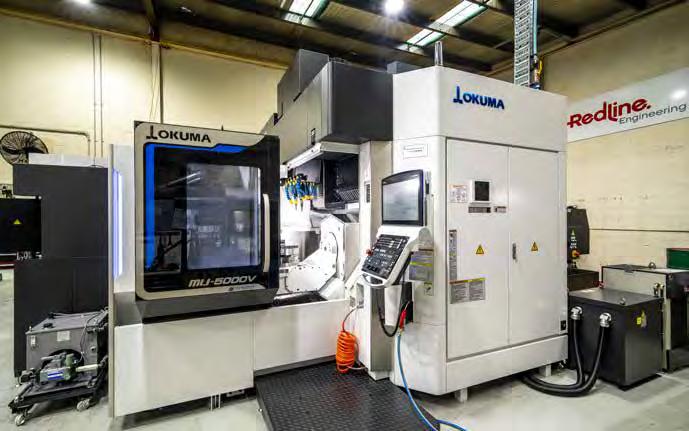
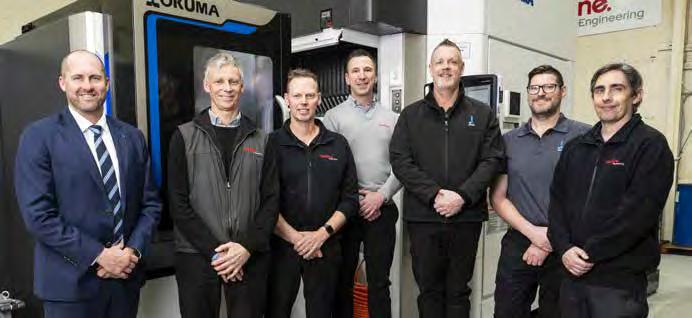
and quality over long production runs with the synergistic effect of Okuma Intelligent Technology. Highly efficient machine with amazing machining capability; face milling: 504 cm3/min, end milling 672 cm3/min
Stuart says these factors give the Okuma machining centre flexibility and productivity in a minimal footprint – as Redline operates the machining centre in a high-volume shop where space is at a premium.
“We are now operating five Okuma CNC machines and we value the strong technical support, maintenance service and training that direct factory access from Okuma provides,”
Stuart says. “The company has enjoyed a long partnership with Okuma, covering more than 30 years, and our original Okuma machine is still in service producing fine tolerance precision parts,” Stuart says.
Okuma branch manager for Victoria and Tasmania Mark Richards congratulated Redline on the installation of the Okuma machining centre.
“Redline Engineering is a leading example of where the Australian precision manufacturing industry is heading and we thank Ken and his team for their continued confidence in the Okuma brand and support,” he says.
Facing a heavy backlog of work and a globally competitive industry, the team at Ronson Gears moved to a new CNC machine – and hasn’t looked back.
Being faced with growing global demand for the high-precision gears that Ronson Gears produces is the sort of problem that might put a spring in the step of any company director. But for Ronson Gears technical director Jason Graham, the primary issue was throughput, as the company sought to serve a highly competitive global market.
“We had a large backlog of work. Our equipment just wasn’t technologically advanced enough for what we were doing. Setups were taking far too long,” he says.
Founded in 1954 as a local operation in Victoria, Ronson Gears today has become a globally trusted manufacturer, delivering high-precision gear solutions for industries ranging from outer space to mining.
Offering full-service manufacturing capabilities covering turning, milling, gear cutting, grinding and advanced measurement, Ronson Gears employs 46 people and operates 24 hours a day, six days a week across three shifts.
Graham says the company needed a solution that could integrate seamlessly into its operations while maximising uptime and capacity – minimising manual intervention and allowing continuous, flexible production. To pursue this, Graham headed to Hannover for major production technology trade fair EMO 2023 to inspect a variety of advanced machining technology.
“Initially, I was considering a more basic 3+1 axis twinpallet machine — I hadn’t planned on exploring a multipallet system,” he says. “But during my EMO visit, I came across some and was genuinely impressed.” On his return to Australia, Graham says he was drawn to a horizontal 5-axis Makino a500Z with a 14-pallet system – and began negotiating with local distributor Headland Technology.
“The machine wasn’t the cheapest on the market, and I’ll admit I haggled quite a bit with Headland’s sales representative, Craig, but ultimately, the technical capability and build quality of the Makino sold me. I knew it was the right solution for us.”
Makino says the machine builds on its existing nx-series four axis horizontal machining centres, but with the addition of its factory built “Z-type” fourth/fifth axis combination to accommodate more complex part geometry challenges in a minimum number of workholding setups and machining operations.
The a500Z is built to minimise force path lengths both through the spindle as well as through the workpiece, efficiently transferring both cutting loads and reactive forces into the machine’s three point levelled bed – a move that maximises both metal removal rates and perishable tool life due to its system rigidity.
Graham says that while he considered other machines, the Makino’s technical specifications and build quality were what impressed him.
“I thought Makino was out of reach for us… but after working with Craig from Headland, the numbers made sense. It wasn’t the cheapest option, but we realised it would pay off in the long run.”
“Stretch your budget if you can. Investing in quality pays back in performance and reliability. My mentor always said, ‘Buy the best you can afford, and it will reward you over time.”
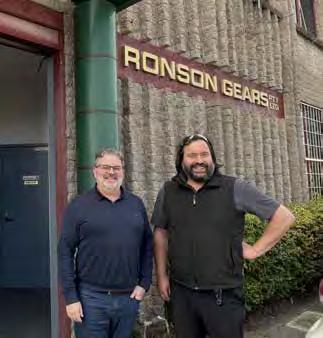
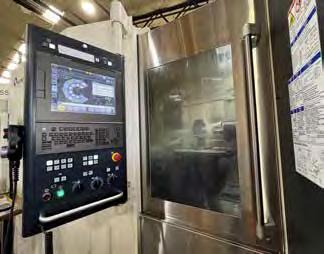
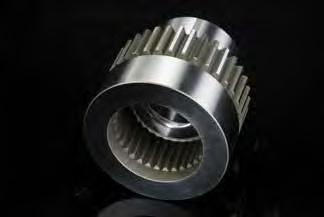
The decision to invest in the Makino a500Z with a 14-pallet pool was based on productivity gains, risk minimisation, and the ability to grow their business into new markets with more reliable technology. Since the machine was installed on-site, Graham says it quickly integrated into Ronson’s operational rhythm. “We saw immediate benefits. Jobs that used to take 10 hours for setup now run with virtually no lost time. It’s a game-changer in terms of flexibility and planning,” he says. Its ease of use and automation reduced downtime and enabled quicker responses to production changes, he adds.
The pallet pool system enables easy prioritisation of urgent jobs, and even with full-time operation, the machine still has capacity for more work through staffing adjustments.
Graham says he’s also noticed a lot of operator enthusiasm: “There’s been a lot of excitement about the machine; it’s a joy to use,” Jason added. “We have the space and now the capability. The next challenge is hiring more of the

right people, which many in manufacturing are struggling with right now.” The company continues to work with the team at Headland Technology, with Graham saying the strong aftersales support they offer reinforced their decision to go with the Makino.
“Service and support are vital. With Headland, I can always get someone on the phone—unlike other suppliers where we’ve struggled. That quick response makes all the difference,” Graham says.
“It’s a great machine and the service and installation from Headland were first-class. Excellent partnership.”
He adds that while the investment was a steep one, his advice to other manufacturers is that the rewards have been worth it.
“Stretch your budget if you can. Investing in quality pays back in performance and reliability. My mentor always said, ‘Buy the best you can afford, and it will reward you over time.”

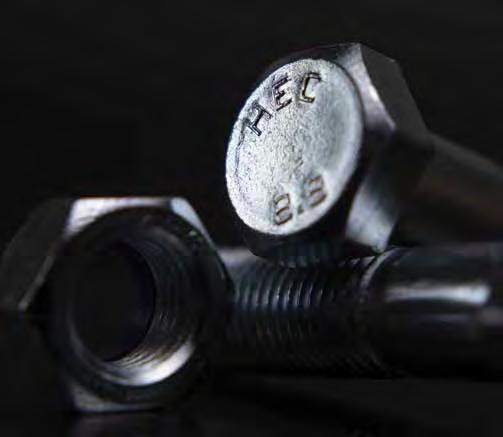
How Air Liquide’s pure oxygen technology helped breathe life into a major land-based aquaculture project.
Beloved by sushi chefs and recreational fishers alike, the Kingfish – also known as the Yellowtail, Haku or Kingi –attracts market prices comparable to salmon and is found in plentiful numbers off the coast of Australia and New Zealand.
For the team at New Zealand public research organisation the National Institute of Water and Atmospheric Research (NIWA) – today known as Earth Sciences New Zealand – the fish is also an ideal candidate for commercial farming. Of course, New Zealand is far from the only nation developing markets for the fish, with hatchery production now well established in Australia, the Netherlands, Denmark, Chile, and Mexico.
Until recently, NIWA said, most on-growing of the fingerlings born in these commercial hatcheries was done in sea-cages, until the fish reached their market size of 3kg. But to truly take advantage of what it saw as a lucrative opportunity, the team at NIWA worked on technology to support commercial-scale hatchery production in a land-based recirculating aquaculture system (RAS).
Essential to the development of the RAS is the Air Liquide Technology Centre (ALTEC) – where technical specialists were able to provide a customisable oxygen dissolution solution designed to meet the needs of the fish at every step of the production process. ALTEC fish farm specialist for Air Liquide Pacific Tianyan Chen says the group collaborates closely with industry to provide customised solutions and services according to specific customer needs.
Popular among modern land-based aquaculture farms, a RAS is essentially a water treatment plant that circulates reused water, Chen says. “As aerobic organisms, fish require a continuous oxygen supply to fuel their metabolic processes, which are essential for growth, reproduction, and overall physiological functions,” she says.
“When dissolved oxygen levels in the water fall below a critical threshold (causing a condition known as hypoxia), fish experience stress, leading to a cascade of negative effects. These include a reduced appetite, which consequently slows their growth rates.
“Furthermore, hypoxic conditions compromise the fish's immune system, making them more susceptible to various diseases and parasitic infestations.
“If the dissolved oxygen levels remain critically low for an extended period, it can ultimately lead to significant mortality events, resulting in substantial economic losses for aquaculture farmers,” she says.
Perfect
Chen says that maintaining optimal levels of dissolved oxygen allows the fish to gain more weight for each unit of feed they consume – enhancing growth rates and reducing the total amount of feed needed, which in turn lowers operational costs and minimises waste production.
“Some farmers have reported that their feed intake has increased by 20-30% and the feed efficiency from feed to fish meat/growth also increases significantly, which results in production profit gains,” Chen says.

With fish feed costing more than A$1,900 for one tonne of fish – depending on the types of fish and feed – this sets the scene for a substantial cost saving. Chen says oxygen is also used to produce ozone, used to sterilise the breeding water, which is passed through a series of filters before being returned to the fish basins. “It’s also important to note that the specific oxygen requirements can vary significantly between different fish species. Species native to fast-flowing, oxygen-rich waters are susceptible to even slight reductions in dissolved oxygen levels.”
“Therefore, it is necessary to carefully consider the specific needs of the species being cultivated to ensure that the oxygen supplementation strategy is tailored accordingly,” she says. While aeration using air is a common method of supplying oxygen to fish, the resulting oxygen concentration depends on environmental conditions, as air only contains about 21% oxygen – the rest is mostly nitrogen.
“Pure oxygen allows for higher fish density while requiring less water, creating more sustainable operations,” Chen says.
"Oxygen is usually dissolved in each fish basin, and the water enters the fish tank. This dissolved oxygen concentration is increased to 120~140% saturation level according to the amount of biomass,” she says. “As a result, the oxygen demands of the fish are met, providing a stable environment for safe and productive fish production."
Oxygen dissolution systems also consume less energy than conventional aeration methods, she says.
“[Air Liquide is] in a beautiful position where we can stay neutral, so we can look at many different types of existing and new injection technology and decide what is best for that particular site based on farm type, water channel and various other factors,” Chen says.

“We can provide or create an optimal energy-saving Oxygen dissolution system by utilising existing systems at aquaculture sites, we have high-efficiency oxygen dissolver devices include the Bicone, CS Nozzle, Oxyflow and Oxyfox systems, alongside electricity-free solutions such as Poroxal.
“Air Liquide proposes equipment combinations that provide the optimum solution and creates new oxygen dissolvers devices for specific customer demands. Innovating with the customer is proudly part of our Air Liquide culture.”
For that reason, Chen says a pure oxygen supply is a must for a fully closed RAS with high fish density – such as the NIWA-supported Northland Aquaculture Centre which officially opened in August last year.
Built in collaboration with the Northland Regional Council and based in the coastal town of Ruakãkã, the RAS facility helps the kingfish reach market size within 12 months of spawning, NIWA says. Today, the facility produces up to 600 tonnes of kingfish per year, with between 95-98% of the water cleaned and reticulated through the system.
“[Kingfish] thrive in RAS; circular tanks suit their natural schooling and feeding behaviour. The systems for exchanging and refreshing the water are engineered to ensure a consistent, healthy rearing environment,” NIWA says.
At the facility’s opening, NIWA chief executive John Morgan said the facility will help New Zealand meet its ambitious target of recording $3 billion in revenue by 2035. “We saw a clear gap in the market for an on-land farm that produces commercial quantities of high-quality fish,” he said.
“This new facility uses a recirculating aquaculture system [RAS], which offers superior environmental and economic performance, and full control over all aspects of production.”

Oxygen costs typically account for 1-10% of total expenses and are essential for the land-based aquaculture process, she adds. Moving into the future, Chen says there is a growing need to make both the oxygenation process and equipment performance more visual and reliable.
By wirelessly monitoring important parameters such as dissolved oxygen, Air Liquide aims to provide early alarms for abnormal situations, better understand operation history and obtain real-time data including calculating the oxygen usage of each unit of fish.
In the meantime, Chen says she and Air Liquide aim to continue to help with the expansion of land-based aquaculture into the future. “We are excited to see these new innovations could help the fish farming industry in Pacific and stay on our mission to understand global technology trends and contribute to land-based aquaculture” Chen says.
Jarno Manzke, managing director of Kaeser Australia and Kaeser Measuring Technology Australia, looks at the ways improving measurement technology is changing compressed air systems.
All industries face the need for optimisation and energy-efficient advancements in their production processes, and compressed air supply systems are no exception. New measurement technologies are crucial in maintaining both the efficiency and safety of these systems, with cutting-edge intelligent devices delivering exceptional transparency, enhancing supply reliability and significantly reducing costs.
Compressed air generation transforms electrical or mechanical energy into pneumatic energy, a process that comes with its own set of challenges, such as minimising energy consumption, maintaining stable pressure levels, ensuring production safety and preventing contamination or leaks
But the quality requirements of compressed air are becoming increasingly rigorous, often requiring certification and detailed documentation. Continuous monitoring across the entire process chain - from compressed air generation to distribution - is therefore essential to guarantee quality and safety in sensitive compressed air applications.
In recent years, innovative compressed air solution providers have developed advanced measurement technology systems capable of fully monitoring entire compressed air networks. These systems aggregate data, conduct analyses and generate evaluations, paving the way for continuous monitoring and optimisation. Every compressed air system generates an enormous volume of data every second. The challenge lies in capturing this data and converting it into meaningful information that can then be used to draw conclusions and derive actionable recommendations, providing tangible benefits for the compressed air station operator.
A meaningful picture only emerges when intelligent sensors are strategically positioned to capture and interpret optimisationrelevant data. Purpose-specific individual sensors, strategically installed at key points within the compressed air system, act as "artificial eyes", capturing targeted data points. This information is then transmitted to a central management system, where it is recorded, analysed, and visualised –being sent to the operator's control system and forwarded to the compressed air provider's cloud for intelligent remote monitoring. Data collection requires the use of suitable sensors. With advancements in sensor technology, modern measuring devices have become ever more compact and powerful. The latest generation of innovative, intelligent sensors allow flexible installation, even in challenging or hard-to-reach places. These sensors are energy-efficient and deliver reliable data over extended periods.
For comprehensive air system monitoring, it is recommended to install a range of measuring devices to accurately assess flow rate, process air, pressure dew point, intake and ambient air, and energy consumption. When evaluating a compressed air system, it is crucial to begin at the intake point of the compressors. Room monitoring, often overlooked, plays a significant role, since intake and ambient conditions directly influence the compressed air station components and the quality of the compressed air that is produced.

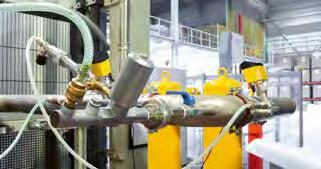
Based on the measured conditions, adjustments may be needed for downstream compressed air treatment components, such as refrigeration or desiccant dryers. If key parameters exceed the limits accounted for during the system's initial design, this can lead to a degradation in compressed air quality - a particularly unfavourable outcome for sensitive applications such as tablet manufacturing, where overly moist compressed air can cause tablets to swell. Furthermore, and most importantly, contamination in the compressed air poses a health risk to the end consumer.
A measuring device that monitors room and intake conditions is ideal for evaluating environmental parameters, determining the operating conditions of compressed air station components, and assessing the moisture entering the system under the prevailing conditions.
This data can be used to determine the ventilation and cooling needed within the compressed air station – such as managing recirculated air during the winter months or determining the right compressed air mass flow when needed.
One of the most important process parameters is the pressure at the transfer point, which is essential for optimising compressor control and determining whether production can continue safely.
Further analysis options involve measuring media temperatures or pressures downstream from the compressed air generators, as well as upstream and downstream from the compressed air treatment process. The data obtained provides valuable insights into additional opportunities for compressed air supply optimisation.
The next type of measuring device to include in a compressed air station is one designed to monitor flow rates. Installed directly downstream from the compressor, a flow rate measuring device based on the differential pressure principle is ideal for determining the generated flow rate, even at high temperatures and for air with an increased moisture concentration. In this case, the flow rate and total consumption are measured and calculated, while pressure, temperature, and flow velocity are also recorded. These devices typically operate within a measurement range of 1:10.
Adherence to specific limit values is of immense importance when using compressed air in production. With proper monitoring, failures and production downtime become a thing of the past. For this purpose, and to assess system pressure at various points, combined measuring devices that monitor pressure and temperature are the ideal choice. These can be installed at key locations, such as the inlet and/or outlet of components or upstream of sensitive applications.
This setup enables pressure differential monitoring throughout the entire compressed air treatment process and compressed air network, as well as ensuring compliance with required temperature levels and helping to identify potential savings opportunities.
Early detection of elevated inlet temperatures in treatment components effectively prevents overloading. An advanced version of this device also measures the pressure dew point, which reflects the moisture content of the compressed air, ensuring the air meets the required degree of dryness to maintain optimal quality.
The system is complemented by one or more measuring devices for energy analysis, such as a multifunctional network analyser designed to monitor the electrical energy supply. The analyser tracks the quality and reliability of the power supply while recording all critical values and metrics, making it an ideal system solution for modern energy data management, including compliance with ISO 50001 standards.
As previously mentioned, all the intelligent sensors collect data in various ways and transmit relevant measurements from their respective locations via a data line to a compressed air management system, seamlessly integrating them into a unified network. This process enables real-time monitoring, data analysis, the creation of key performance indicators, and predictive maintenance. Any irregularities can be identified early on, and in the event of a fault, long-term data storage facilitates detailed problem diagnosis.
In an optimally designed compressor station, the integration of decentralised intelligence (component control) with centralised intelligence (a compressed air management system) establishes the perfect framework for seamless data exchange and analysis. This capability provides the operator with complete oversight. Using internal interfaces and the compressed air management system, they gain a clear, consolidated view of all critical performance metrics of the compressed air station. This is done in real time and on any device.
With the integration of advanced measuring devices and intelligent technology, previously hidden operations and processes can now be revealed and visualised. The goal is to achieve complete transparency, providing the critical insights needed to create accurate predictive models. Cutting-edge advancements are making this a reality, steadily setting high supply reliability as the new standard.


EXCEPTIONAL BLADE LIFE EXTREMELY VERSATILE CONSISTENT PERFORMANCE CUT AFTER CUT
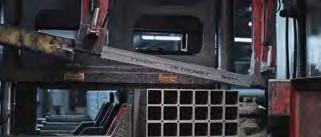
LONG BLADE LIFE AND EXTREME DURABILITY QUIET CUTTING, REDUCED VIBRATION
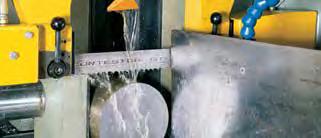
CUTS ON LARGE, DIFFICULT TO CUT MATERIALS OPTIMUM CHIP FORMATION IN WORK HARDENING ALLOYS DESIGNED FOR LONG LIFE

A new machining centre is leading to round-the-clock operations for Hydraulic Controls.
With over 50 years as a fixture of Australia’s fluid power industry, Hydraulic Controls is extending its reach into new sectors. The business produces the hardware that controls some of Australia's most complex machines. The core focus of the business is hydraulic manifold and valve manufacture. Hydraulic Controls can design and make hardware to set specifications or draw from its large stock holding of more than 20,000 items including solenoids, pressure, flow and direction control valves, hydraulic integrated circuits, field hydraulic pumps and motors, servo motors and more.
The company serves customers ranging from multi-national OEMs to sole traders and makes products for the mining and maritime industries, through to theatre stage lifts. During 2024 the company maintained a 97% on-time delivery rate.
Hydraulic Controls managing director Leonard Patchett says the company’s industry mix is currently skewed towards manufacturing hydraulic components for mining equipment.
“A reasonable proportion of that is in the coal mining space. At the moment we are making good sales, but in the next 25 years it will probably dwindle as countries pursue net zero emissions,” he says.
“The business is aware that the revenue we are currently getting out of the coal space isn’t going to be there forever, so we have identified new industries as the spaces that we should pursue next.”
Having taken over as managing director in April last year after about four years with the company, Patchett says Hydraulic Controls had seen a need to start producing products with “lights out” – when its workforce had gone home for the evening. This led the company to purchase an Okuma MB5000 HII horizontal machining centre equipped with a series of pallets, each 500mm by 500mm in size, which Patchett says at any one time can hold up to 12 of the parts Hydraulic Controls is producing.
“In theory it can run the whole way through the night and at 6:00 AM when the first machinists start in the morning, all the parts are finished. When they come in, they take the finished parts off and then start putting more blank parts on and they go again, so the cycle continues,” he says.
Patchett says Hydraulic Controls felt the impact of the new arrival almost immediately after it was acquired.
“When we did get this new Okuma machine, we scrapped two machines and sold another machine. So, we got rid of three machines and replaced it with one,” he says.
“Because it can run through the night, three machines running for eight hours is the same as this machine running for 24 hours, so it is pretty simple maths.”
Hydraulic Controls’ in-house manufacturing includes manifold CNC machining, surface treatments, valve manufacture and system assembly, with full material traceability and metrology. Its in-house testing facilities go to 500 bar and flow to 100Lpm.
Hydraulic Controls currently has 12 CNC machines “of various types and varieties” in operation, Patchett says.
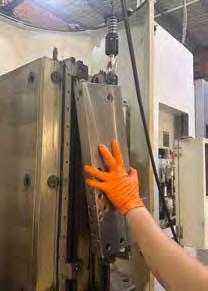
Another manifold is unloaded after a busy night's production at Hydraulic Controls.
“Some of them are coming to the end of their lives, so we are looking to replace them with a bunch of new Okuma machines in the coming years…” he says.
Operating the Okuma machining centre outside business hours with known accuracy and stability has minimised power consumption and freed up valuable time during the day for bespoke, one-off, and short lead-time requests, he said.
Patchett praised the training and helpful advice offered by Okuma to help his staff fully utilise the machine’s Smart Manufacturing capabilities.
He also praised the addition of an optional extra on the MB5000 HII, a coolant mist collector that collects the coolant which would otherwise be expelled from the machine in a fine mist and escape into the workshop atmosphere.
“Our current and proposed Okuma machining centres are integral components of our energy-saving, designed to mitigate our environmental impact,” Patchett says.
With advanced new machining centres on the horizon, diversification has been a key factor for this precision engineering company as it looks at new business opportunities. Already fully accredited to ISO-9001, ISO1-4001 and ISO-45001 and with DISP underway, Hydraulic Controls is well placed to achieve its development goals. Whilst the bulk of sales are made to Australian customers, significant exports are being achieved via these customers with direct export sales also growing.
‘If you want to employ the best machinists, they want and deserve to best machines to advance their experience, knowledge and operational skills using the latest technology,” Patchett says.
“Such investment in this technology has proven to excite the operators and instil confidence in the company's future. The knowledge that they will receive advanced and ongoing training on this equipment adds to the excitement.”
Cloud-based welding production management software WeldEye is a key asset for one Tasmanian manufacturer.
With a diverse fleet of welders and a fierce dedication to quality assurance, the team at Tasmanian OEM Jayben Group was faced with a challenge.
The company, which specialises in power train products and light to medium industrial plant and equipment for the mining, agricultural, manufacturing and defence sectors, was looking at new ways of providing a high level of quality assurance.
Jayben fabrication manager Danny Patmore says the company’s dedication to ensuring the quality of its production process was unwavering. So, when the time came to find a new way of monitoring and managing the quality of its welding output, Jayben applied the same level of scrutiny.
“If the quality in the welds is not there, it will threaten the integrity of the component or machine, so it’s absolutely critical that we get it right,” Patmore says. With Jayben already using a fleet of standard mig machines and employing an experienced team of six welders, Patmore says it was important that any monitoring software be able to work with a variety of products.
“WeldEye was attractive because it can be used with any welding brand and we had already made a significant investment in our fleet of existing mig welders,” he says.
“They were still fit for purpose, so we wanted to make them part of the overall solution rather than have to go out buy new equipment.” Designed by Kemppi as a universal solution for managing welding production, the WeldEye system allows the operator to control all parts of the welding process – including welding procedures, welder and inspector qualifications, documentation, reporting and administration.
Offering 100% traceability to any weld made, the WeldEye also provides live data monitoring capability – allowing users to track quality and make any corrections in real time.
“WeldEye is impressive,” Patmore says. “What’s more, if you need to produce qualitative data and reports for quality
assurance for customers, this can be done at the touch of a button.” “When new staff come on board, WeldEye helps us to quickly get a feel for their welding ability and provide upskilling if required,” he says.
WeldEye’s versatility also makes managing welding procedure specifications (WPS) and welder qualifications more efficient as all the information is stored in the one place. The WPSs can be created quickly using templates and personnel qualifications are easily accessible, as they are conveniently centralised. Since installing WeldEye, Patmore says Jayben has been able to effectively monitor welding quality as well as boost productivity across its entire welding production.
“WeldEye has confirmed that we are meeting quality requirements and given us added confidence in our work. The ability to rectify any deviations in real-time is also invaluable as it saves us precious time so that we can do more,” he says.
Thanks to its continued growth, particularly in defence work, and the incorporation of aluminium fabrication, Jayben has expanded its original fleet of welders to include the Kemppi X5 FastMig, X5 FastMig Pulse, MasterTig and the A7 Mig welder power source. “Today, WeldEye helps us manage all of our welding equipment, including our robotic welder, the Kemppi A7, and verify compliance of WPSs to facilitate quality control,” Patmore says.
“In the case of our defence work, WeldEye is absolutely critical as it helps us demonstrate welding production compliance with the requirements of the AS/NZS ISO 3834 quality standard.” With an easy software installation process and proactive customer service, Patmore says using the WeldEye software package is now second nature for Jayen staff.
“There’s no doubt that WeldEye has helped us overcome the challenge of ensuring quality control in our welding work,” he says. “If welding quality is important to you, I would recommend it in the blink of an eye.”

With an expanded Newcastle manufacturing centre and a new WA arm, premium suspension components manufacturer Lovells Group is celebrating its 95th year in style.
Lovells Group has started building a flagship engineering, manufacturing and retail centre in Newcastle, which it says will support its development of the next generation of automotive components. Being built next to Lovells’ main manufacturing site, the new 5,000 square metre facility will support work on electric vehicles (EVs), emerging drivetrain technologies and advanced suspension platforms.
It will offer new facilities for the design and manufacture of electro-technology solutions for EV, electric truck and electric bus charging systems, as well as product fatigue, corrosion and performance testing and fitment engineering for OEM and aftermarket applications.
Lovells says it expects to create 24 new specialist roles across engineering, advanced manufacturing, product design and compliance to work at the facility when it opens. Company managing director Simon Crane says the facility will complement Lovells’ R&D hub in Edwardstown, South Australia, where the company also recently launched a $1 million facility.
“Our new Newcastle R&D Centre reinforces our commitment to local innovation, advanced engineering, and our role in supporting the future of transport,” he says.
“Together with our Edwardstown site and The Bend testing facilities in South Australia, this centre will ensure Lovells remains on the cutting edge of suspension, load-carrying, and towing system development.” The move comes as Lovells opens its first franchise in Western Australia, after taking over WA Suspensions from owners Stu Bond and Keith Sinclair.
The new Lovells Osborne Park will offer a complete range of Gross Vehicle Mass, Gross Combination Mass and Braked Towing Capacity upgrade kits, including Post-Registration Gross Combination Mass revisions, which are now legal under new Western Australian legislation.
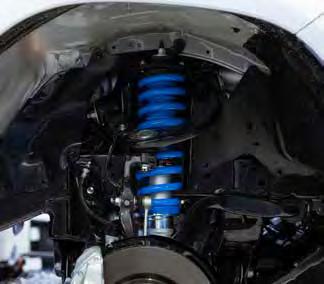
Lovells says it is the first second stage manufacturer in Australia to gain approval for these upgrades in WA, enabling locals to legally upgrade the towing and load-carrying capacity of registered vehicles through an approved Lovells facility. “Expanding to Western Australia enables us to meet growing demand and better serve our customers on both sides of the country,” Lovells general manager - automotive Mike Davison says.
“With Osborne Park, we are not only strengthening our physical footprint but reinforcing our commitment to making legal, engineered towing and suspension upgrades more accessible for more Australians.”

A move into cable assemblies, servo assemblies and cable chains for Lapp Australia.
Lapp Australia has launched a dedicated Harnessing Solutions Division to offer off-site assembly of custom cable assemblies to Australian customers. Staffed by its own dedicated technology team, the division will offer a full suite of services including design, prototyping, production, manufacturing, testing, quality assurance, component sourcing and repairs.
The facility will produce harnesses incorporating Lapp brands such as Ölflex power cables, Skintop cable glands, Etherline ethernet cables, Unitronic data cables, Epic connectors, Silvyn cable protection, Hitronic fibre-optic cables and Fleximark marking systems.
Lapp Australia has installed cable feeder technology in the new facility, along with a labeller for clear function identification and heat shrink technology for process protection. The company also combines cable stripping, cutting and stacking in one line to minimise repeat handling and maximise accuracy, it says.
Lapp Australia managing director Simon Pullinger says the move is the next logical step in the company’s expansion locally, helping companies achieve automation and digitalisation faster.
“We are advancing our service from being an outstandingly successful supplier of tens of thousands of world class cables and components, to becoming an integrated system supplier

structured to assist a broad and growing range of industries in assembling the best integrated solutions tailored to their specific needs,” he says. Pullinger says several companies are seeking out harnessing companies to carry out the harnessing work accurately at a dedicated site, rather than distracting their own workforces from their core tasks.
“More and more companies are removing such issues by placing the assembly of cables, cable harnesses, and drag chains in the hands of a specialist solutions provider working to top OEM standards,” he says.
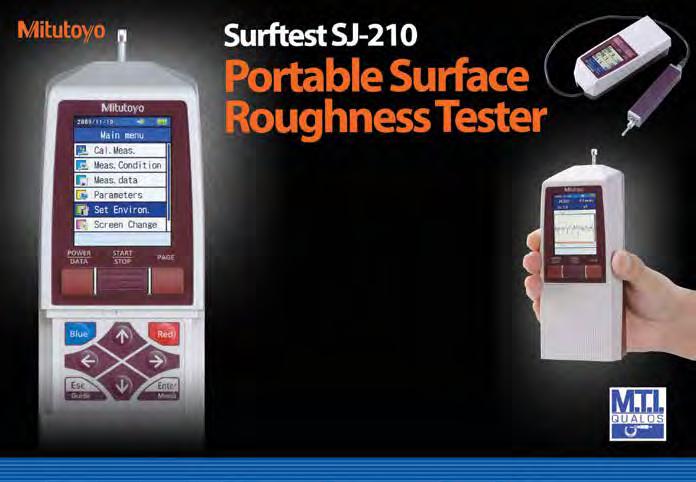
The Surftest SJ-210 is a user-friendly surface roughness measurement instrument designed as a handheld tool that can be carried with you and used on-site
Easy to use
• 2.4-inch colour graphic LCD with backlight
• Simple key layout
The Surftest SJ-210 can be operated easily using the keys on the front of the unit and under the sliding cover.
Highly functional
• Advanced data storage capabilities
• Optional memory card
• Password protection
• Multilingual support
• Stylus alarm
An alarm warns you when the cumulative measurement distance exceeds a preset limit.
SJ-210 Series.
Extensive analysis and display features
• Complies with many industry standards
The Surftest SJ-210 complies with the following standards: JIS (JISB0601- 2001, JIS-B0601-1994, JIS B0601-1982), VDA, ISO-1997, and ANSI.
• Displays assessed profiles and graphical data
In addition to calculation results, the Surftest SJ-210 can display sectional calculation results and assessed profiles, load curves, and amplitude distribution curves.
Boosting local manufacturing and helping ease remote housing difficulties in one fell swoop.
A new automated precision laser-cut tube machine will help a Darwin-based welder and fabricator contribute to new housing solutions across the Northern Territory.
Darwin Sheet Metal and Laser Cutting (DSM) will use a new Trumpf TruLaser 7000 industrial laser cutting machine to make furniture in a project supported by the Territory Government’s Advanced Manufacturing Ecosystem Fund (AMEF).
DSM has developed a manufacturing system for flat-pack stainless steel furniture, supported by QR codes that provide assembly instructions and easy reordering of spare parts. The company is set to team with remote housing specialist WTD Construction and Liquid Interactive to deliver the furniture in what is estimated to be at least 2,000 near-term supply opportunities in current remote building programs across the Territory.
Using the Trumpf, DMS expects to increase batch production of its modular kitchens, pantries, bedrooms and laundries while ensuring quality cutting across a variety of materials.
With Liquid Interactive designing the QR-coded laser-etched technology, the three groups will work together in a $4.16 million collaborative project to bring DSM’s furniture design to a commercial reality, being produced with high automation and output.
DSM owner Ashton Simpson says the project will reduce reliance on interstate imports by collaborating with NT-based contractors and sourcing steel from local suppliers.
“DSM will establish a sustainable and lasting business presence in the NT by expanding manufacturing capabilities and positioning ourselves as a leader in advanced, scalable production,” he says.
“With the acquisition of advanced technologies like the Trumpf laser machine and the introduction of new manufacturing services utilising this new technology, DSM will meet growing demand across industries such as defence, construction, and agriculture.”
The project will be administered by the Advanced Manufacturing Growth Centre, which also administers the AMEF, which in turn has provided a $650,098 co-investment in the project.
AMGC’s Director for the Northern Territory Charmaine Phillips said the project would help enhance the Territory’s manufacturing ecosystem by creating a dynamic, interconnected network of businesses and stakeholders.
“Central to this ecosystem is integrating advanced manufacturing technology, elevating production capabilities and setting new standards for regional efficiency and quality,” she says.
The project will create an estimated 11 new jobs at DSM in the first three years, as well as $3 million in new revenues, and position DSM to capitalise on opportunities in new sectors, AMGC says.
DSM is the 14th business to receive co-investment through the AMEF, which was launched in 2021.
Across all projects to date, the AMEF has spurred manufacturing activity, which is expected to create over 250 new jobs and generate over $134 million for the Territory's economy in its first five years.

The team at Seco Tools discusses modern solid carbide end mills – how they’ve evolved and how they’re best applied today.
The evolution of solid carbide end mills has closely followed the development of CNC machining. Once limited to simple geometries and general-purpose use, these tools have become highly engineered to cope with the demands of high-speed, high-precision and multi-axis environments. Improvements in substrate materials, coatings and geometries now mean that solid carbide tools can take on applications once reserved for smaller diameter inserted milling tools, while also offering greater handling simplicity.
Where earlier end mills relied on relatively standard shapes, today’s tools are finely tuned combinations of rod materials, core and flute designs, helix variations, edge preparations and multi-layered PVD coatings. The performance of a modern end mill is as much about this balance of factors as it is about diameter or flute count. For machinists, tool selection increasingly involves considering not only the material and geometry of the tool, but also the dynamics of the machine and the chosen cutting strategy.
Solid carbide end mills are often grouped into two broad categories: universal and specialist. Universal end mills are designed to perform across a wide range of materials and machining operations. They typically employ balanced geometries, moderate flute counts and versatile coatings that provide good wear resistance across steels, stainless steels and cast irons. These tools are useful for job shops or environments where part variety is high, and tooling inventories need to be streamlined.
Specialist end mills, on the other hand, are tailored to specific materials or cutting strategies. Examples include high-feed tools for aggressive roughing, aluminium-specific cutters with polished flutes, or diamond-coated tools for graphite and composite machining. In aerospace, medical and die/mould industries, such specialist geometries and coatings are often indispensable.
Positioned between universal and specialist categories, Seco’s Stabilizer range is designed with a focus on dynamic stability. Its asymmetrical flute designs, variable helix and rake angles and optimised cores are intended to reduce chatter and vibration during machining. In practice, this means the tools perform best in rigid machine environments with stable fixturing and sufficient spindle power. Under those conditions, the Stabilizer range can achieve removal rates closer to those of specialist tools, while maintaining vibration control.
Seco also offers the Solid2 family of end mills, which are versatile high-performance tools designed for strategies such as trochoidal and dynamic milling. Compared with the Stabilizer range, Solid2 tools are somewhat less demanding in terms of machine rigidity and setup conditions, while still delivering strong performance in terms of tool life and surface finish. The Stabilizer tools, however, can reach higher levels of productivity in stable setups, thanks to their vibrationdamping design.
Choosing between universal, specialist and advanced universal tools such as the Stabilizer and Solid2 ranges depends on production conditions. Universal tools offer flexibility in mixed-material, low-volume environments. Specialist tools excel in high-value or difficult-to-machine materials where precision and durability are critical. Advanced universal designs like Stabilizer and Solid2 provide a middle ground, with Stabilizer favouring stable, high-speed conditions and Solid2 offering more forgiving performance across a wider range of setups.
Ultimately, the best results come from aligning the tool with the material, machine and cutting strategy. For today’s machinists, success with solid carbide end mills is not simply about selecting a flute count or diameter, but about matching tool design with production goals.
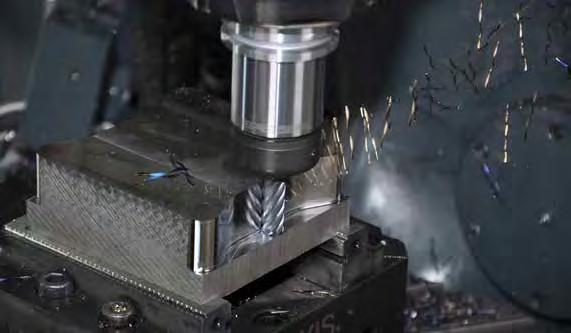
Dynamic milling: Machining strategies and toolpaths are very important.
Hyperion Systems aims to use funds from a recent government grant to put its mobile 3D printing system to work, on the road.
Western Australian company Hyperion Systems has secured a government grant of $385,000 to help commercialise its mobile large scale 3D printing system. The company’s Large Format Additive Manufacturing system can build parts up to 10m long using thermoplastic pellets, which can be recycled from waste streams like containers, PET bottles and even decommissioned subsea infrastructure.
The system combines custom-built hardware, proprietary software and pellet-based plastic feedstock - either new or recycled – to create a complete manufacturing setup that is transportable and can be operated either by personnel on-site or managed remotely.
Hyperion plans to use the grant, allocated through the Federal Government’s Industry Growth Program in August, to further its “Manufacturing-as-a-Service model”.
This will allow third parties to lease and operate the mobile system on site, with options for in-house training or remote operation. Hyperion’s Fused Granular Fabrication process is used to produce everything from seals and gaskets to concrete formwork, architectural sculptures, boat hulls and furniture. Integrated machining capabilities mean parts can be printed and finished in a single setup, reducing waste, speeding up turnaround times and lowering costs.
Company founder Josh Wigley says the technology will transform how large industrial components are made.
“For example, moulds used in boat building that typically take up to six months can now be produced in as little as three days,” he says. “Companies can go from idea to full-scale
Hyperion Systems
founder Josh Wigley with the printing arm of his Large Format Additive Manufacturing system.

production without waiting on tooling or overseas parts. We’re offering a smarter alternative, allowing companies to design, test and print within days, then scale when they’re ready.”
“We’ve built a full-stack solution - hardware, software and materials - all developed here in WA. Our goal is to make highquality, large-scale production accessible for any company, anywhere, without the overheads of traditional manufacturing,” Josh says.
In addition to Government funding, Hyperion is also backed by Perth businessman David Budge, co-founder of 3D metal printing success story Aurora Labs Ltd. David was one of Hyperion’s founding investors and now serves as its Chief Technology Officer.
“David’s shift from metals to plastics reflects the opportunity we see in large-format, recycled polymer-based manufacturing faster, cost effective and circular by design,” Josh says.
The Boston Micro Fabrication microArch S150 benchtop 3D printer from AXT offers high resolution printing.
A better surface finish for parts fabricated using a filament printer is what’s on offer in the latest product launched in Australia by Boston Micro Fabrication (BMF), distributed in Australia by AXT. The newly launched microArch S150 3D printer produces parts that looks as though they might have been injection moulded, AXT says, fabricated with a 25µm resolution – roughly the diameter of a human hair.
Using light-based Projection Micro Stereo Lithography (PµSL) technology, fabricators can create parts up to 80 x 48 x 50mm from any number of resins, depending on their desired application. This includes high-strength, high-temperature, soluble, biocompatible polymers, alumina ceramic from BMF as well as a range of third party resins.
In addition to its core printing capabilities, the system integrates a number of features aimed at improving usability and print quality. These include an interactive touchscreen, a side-shifting membrane with automated calibration and a scraper and roller mechanism that helps reduce bubbles and improve surface finish. The printer also has a resin heated vat, a DLC-coated platform for easier part removal and a HEPA13

The BMF microArch S150 is built to make industrial-grade 3D printing more accessible.
filter to maintain a cleaner working environment. For laboratory use, it can operate within a biological safety cabinet, and users can select between 5mL and 20mL resin vats depending on their needs.
Positioned as the most economical entry point into the BMF product range, the microArch S150 provides a pathway for users who may later require larger systems or higher resolutions – with options extending down to 2µm.
3D Printing has become the unlikely cause of a major boost in productivity for an Australian original equipment manufacturer.
From its base in Victoria’s Carrum Downs, the team at Ultracut Industries works to build bespoke equipment for a global client base in the textile and soft furnishings industry. Its custom-built machines, which also serve a wide variety of other industries, include automated and semi-automated cutters, blinds assembly equipment, impulse welders, fabric creasing tables and more.
Until recently Ultracut used CNC machining for its prototyping process – when preparing models for an individual client construction. But this solution could be both costly and time consuming – with workers occasionally taking up to four hours to set up a basic jig or fixture on a CNC machine.
For company director Garth Jacobs, it was time for Ultracut to explore a faster, and more agile approach – leaning into the world of 3D Printing. After researching his options, Jacobs selected a China-made Mingda MD400D3D printer, praising the model’s reliability, high speeds and its substantial 400mm by 400mm by 400mm print volume.
After-sales support from Mingda and seller Bilby 3D, including a hands-on site visit, also helped Jacobs start using the 3D printer in his prototype design straight away. Today, Jacobs and the Ultracut team use the MD400D to quickly test and refine parts like jigs and fixtures, accelerating development without clogging up CNC resources.
“Going from a 4-hour CNC setup to a few minutes with the MD400D has been a game-changer,” he says.
On top of this, Jacobs says Ultracut is able to produce more iterations of these parts – given the cost of materials used in 3D printing is significantly lower than those of CNC machining.
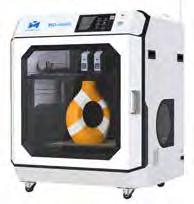
“Having the ability to prototype and produce usable parts quickly and costeffectively has changed how we work. The MD400D has opened up a whole new level of flexibility for us,” he says.
Looking forward, Jacobs says the company is exploring new ways to push those 3D printing capabilities even further, whether it is in metal printing or in using the Mingda’s large build size and IDEX dual-extrusion capability to scale up designs or mirror-print parts.
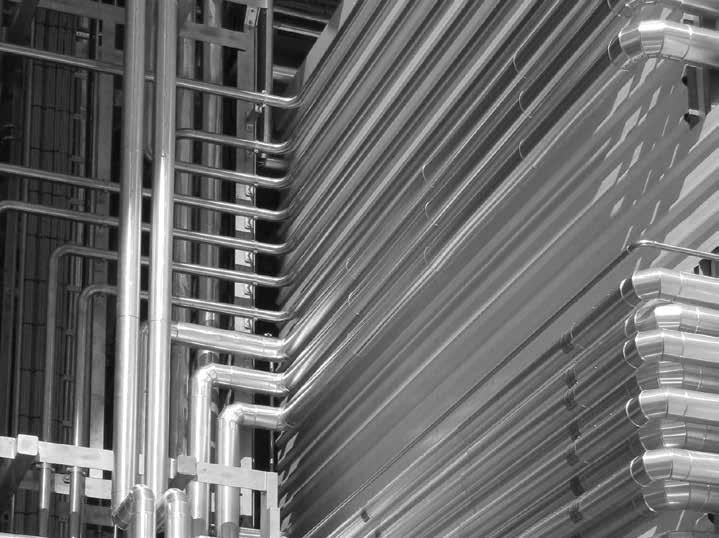
A novel approach to microscale 3D printing could create new opportunities in electronics, photonics and high-value manufacturing.
A new approach to microscale 3D printing is emerging from France, where startup Hummink has developed what it calls High-Precision Capillary Printing (HPCaP). The technology uses capillary forces to deposit tiny amounts of material onto virtually any surface, local distributor AXT says.
Commercially available through the Hummink NAZCA platform, AXT says the HPCaP system offers unprecedented resolution and precision in micron and sub-micron scale printing, depending on the size of the nozzle used.
HPCaP is a room-temperature direct deposition approach – based on the general working principles of an atomic force microscope (AFM), except the AFM tip is swapped for a micro-pipette. A micro-pipette can be thought of as a micro-sized fountain pen filled with liquid that is attached to a macroresonator and controlled on a nanopositioning stage.
The macroresonator vibrates at a resonant frequency until it meets the substrate. When the pipette tip touches a surface, liquid is drawn out naturally by capillary action, forming a meniscus that is stabilised through a closed-loop control system. Movement across the X, Y and Z axes allows continuous deposition, with the pipette diameter — anywhere from 50 microns down to 100 nanometres — determining the achievable resolution.
Continuous deposition is achieved via capillary action, with no external forces required, creating a deposition process that is extremely gentle and precise, AXT says. Despite requiring only tens of microlitres of liquid in the pipette, the system can deposit material across long distances, since the actual amount dispensed is measured in nanolitres.
AXT says this method brings several advantages over more established printing techniques. Unlike inkjet systems,
which rely on drop-on-demand deposition, HPCaP delivers continuous material flow, reducing the risk of defects such as splashes or satellite drops. Because it avoids high-energy inputs such as UV curing, ion bombardment or chemical reactions, the process is compatible with a wide variety of materials and substrates.
Polymers including PMMA, SU8, PVP and epoxy can be printed alongside conductive metals like silver, copper, gold and indium. Nanomaterials such as carbon nanotubes, graphene and nanowires are also suitable. Viscosities of up to 100,000 centipoise can be handled, giving the process a broad operating window.
Displays, biosensors, photonics, and luxury goods are all potential markets, with the technology also showing promise for repairing defects in electronic circuits. The method has been used to restore colour converters in display panels, with early reports saying it did so without the waste or artefacts sometimes left by alternative approaches.
Hummink has packaged the process into its NAZCA platform, combining the patented printing technology with AI-based tools for trajectory plotting, image recognition and ink monitoring. The aim is to give users tighter control over deposition and make more efficient use of costly materials. By enabling structures to be fabricated with precision measured in nanometres, while remaining compatible with a wide range of inks and substrates, HPCaP sets itself apart from conventional additive manufacturing systems. It is positioned less as a replacement for established methods than as a complementary tool where extremely fine resolution is required.
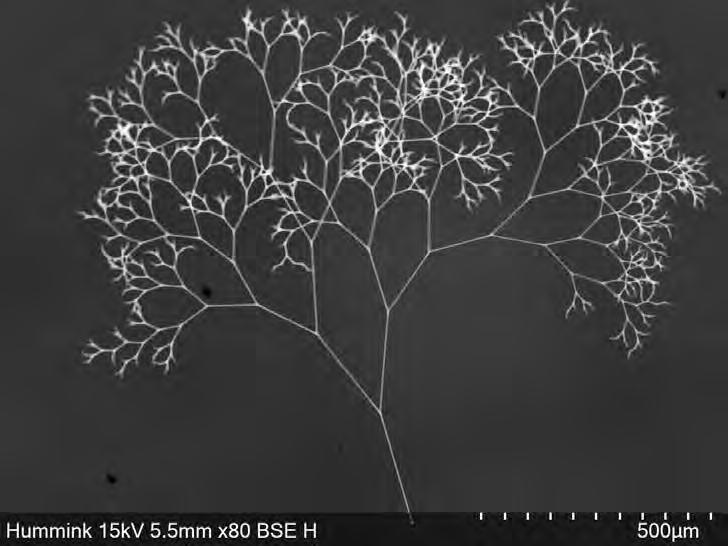
A mission to boost oyster populations in inner Sydney could lead to 3D printed seawalls being established worldwide, if the vision of the BioShelters team comes to fruition.
Artificial seawalls produced using 3D printing will form part of an effort to restore oyster populations – and reduce marine pollution – near the new Sydney Fish Markets at Glebe’s Blackwattle Bay.
The reef structures – called BioShelters – are made from a 3D-printed recycled plastic mould and comprise 25 individual panels measuring six metres by two metres and 90 centimetres in height. The project is similar to another project involving UNSW marine scientists, Living Seawalls, which fits similar textured concrete panels to seawalls around the harbour to create more rocky habitat space for small sea creatures along the harbour shoreline.
What sets BioShelters apart is the use of computation design and robotic fabrication to create site-specific habitat solutions, using research to create an environment suitable for the Sydney Rock Oyster, native hairy mussels and a species of native kelp. “Filter-feeders rely on good water flow, algae need light and moisture, so they don’t dry out, and mobile species like snails and crabs need places to hide,” explains marine biologist Nina Schaefer.
“So the design had to accommodate water flowing through the structure, and include features that also trap water, and offer small, shaded areas for shelter.”
Developed by computational designers from the School of Built Environment at the University of New South Wales and supported by Landcom and the NSW Government, the BioShelters project applies the advanced computational methods architects use to design and fabricate green coastal infrastructure.
Project leader M. Hank Haeusler, the director of the ARC Centre for Next-Gen Architectural Manufacturing at UNSW, says that most structures built to protect the existing harbour shoreline are built flat, lacking the features and crevices of a


natural rocky shoreline needed to support native biodiversity.
”We use algorithms and robotic fabrication that translates marine biology data to create 3D forms that support a range of species,” Haeusler says. “It not only restores oysters, but also supports fish, seaweed, kelp and other native marine species.”
Increasing oyster populations in the bay has been a priority, as the animals are considered critical for marine ecosystems, contributing to cleanliness by filtering up to 100 litres of water per day. “Just as there is a housing crisis in Sydney for humans, there is one for sea creatures like oysters,” Haeusler says. “What this project aims to do is create new artificial habitats that are as close to nature as possible.”
The next phases of the BioShelters project will focus on refining the fabrication process. Currently the team prints moulds and fills them with concrete, but they aim to print directly in concrete to streamline production.
“We want to develop a system where marine biologists can input site-specific information into a program, approve or modify the design, and then submit it for fabrication.”
The ultimate aim is to see BioShelters used in harbours around the world, Prof. Haeusler says. The modular design of the structures means they could be adapted to fit any seawall structure. “We have already started a conversation for a larger installation, revitalising seawalls across Sydney Harbour,” he says.
“There’s potential to take the principles to design and generate similar artificial habitats for other species on land such as mammals, birds, bats and rodents that also need homes.”



For over a century, KAESER has been more than a manufacturer. We’ve been an engineering partner, providing efficient, reliable compressed air so you can concentrate on what matters most. From Germany to Australia, our commitment to you has never changed. At KAESER, we have your back. au.kaeser.com YEARS

MEX Engineering Group founder Russell King explains how additive manufacturing is shaping the future of the Australian manufacturing industry.
At MEX Engineering Group, we are committed to leading the way in innovation—delivering smarter, faster, and more efficient solutions to the Australian manufacturing sector. Our strategic partnership with Alfex and our investment in Markforged industrial 3D printers is not just an upgrade in capability; it represents a transformative shift in how we support our clients, streamline operations, and future-proof our services.
Australia’s manufacturing sector is experiencing a profound transformation, with additive manufacturing —commonly known as 3D printing—at the forefront of this evolution. Once limited to rapid prototyping, additive manufacturing has matured into a cornerstone technology, driving innovation, efficiency and sustainability across industries.
Additive manufacturing empowers us to create complex, customised parts with geometries that are impossible to achieve through traditional methods. Across Australia, companies in aerospace, medical, food and beverage, automotive, and mining are leveraging metal 3D printing to produce lightweight, highstrength components with unmatched precision and speed. For instance, intricate aerospace parts that once required months to fabricate can now be produced on demand, dramatically reducing lead times and costs. Traditional machining and prototyping often involve lengthy lead times and elevated costs. With Markforged’s advanced additive manufacturing technology, we can produce functional end-use parts, jigs, fixtures, and prototypes in-house—reducing turnaround from weeks to days, or even hours. This agility means faster problem-solving and less downtime for our clients. Seamless integration with our digital workflows ensures traceability, repeatability, and rapid iteration. Designs can be shared and printed across multiple sites, enabling scalable production and empowering our team to respond instantly to evolving challenges.
Our commitment to additive manufacturing is also an investment in the future workforce. Through our inhouse training centre, apprentices and technicians gain hands-on experience with advanced manufacturing technologies and access to support and knowledge bases from our partners at Alfex and Markforged. This practical exposure equips them with the skills and knowledge that will be increasingly in demand as the industry continues to evolve.
The economic impact of additive manufacturing in Australia is both significant and rapidly growing. The metal additive manufacturing market was valued at over US$116 million in 2024 and is projected to surpass US$370 million by 2033, reflecting a compound annual growth rate of nearly 14%. Recognising the strategic importance of this sector, the Australian government announced an A$271 million funding boost in 2025—including A$58 million for the Additive Manufacturing Co-operative Research Centre (AMCRC)—to accelerate research, development, and commercialisation.
A robust ecosystem is emerging, uniting universities, industry, and government. The AMCRC, backed by substantial public and private investment, is fostering partnerships to advance materials, processes, and digital platforms. These collaborative efforts are positioning Australia as a leader in full-scale commercial production, with 3D printing transforming supply chains and industrial processes nationwide. Sustainability is a key driver of additive manufacturing. Additive manufacturing reduces material waste, supports the use of eco-friendly and recyclable materials, and enables on-demand, localised production—all crucial for achieving Australia’s carbon neutrality goals. By producing parts closer to where they are needed, Additive manufacturing also enhances supply chain resilience, a vital advantage in today’s dynamic global environment.
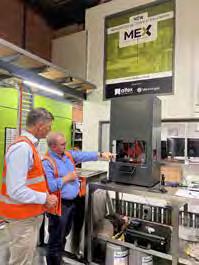
The future of Australian manufacturing is digital. The integration of AI and digital twins with additive manufacturing technologies is optimising design, planning, and quality assurance. These advancements enable real-time monitoring, predictive maintenance, and seamless data management, ensuring that production remains efficient, adaptable, and future-ready. While the promise of additive manufacturing is immense, challenges remain—particularly in materials certification, workforce development, and standardisation. However, with ongoing investment, collaboration, and our focus on innovation, Australia is well-positioned to overcome these hurdles. At MEX Engineering Group, our adoption of Markforged technology not only gives us a competitive edge, but—more importantly—delivers tangible benefits to our clients: reduced downtime, rapid production of bespoke parts, and accelerated innovation.
Fresh from winning “Best Product” at intralogistics trade show LogiMAT 2025, Knapp’s Aerobot range has now debuted in Australia.
Designed to integrate into existing warehouse designs and storage solutions, the AeroBot range of intelligent warehouse robots offers a smarter way of automating storage and picking, product developer Knapp says.
Dispensing with the need for static conveyors or rigid layouts, the AeroBots can travel both lengthwise and crosswise across warehouse floors and racks using LIDAR technology, with Knapp’s SatBot compact satellite robots moving the load carriers in and out of storage.
Measuring 700mm by 500mm across and 400mm deep, the AeroBots can carry loads of up to 35kg in containers or trays, as well as climbing up to 12m high using its friction drive technology, Knapp says.
Offering flexible racking options and a modular design, the system is built to integrate smoothly into new and existing buildings – enabling it to work well in retrofitted environments where space is at a premium. Knapp Australia managing director Michael Kemeny says the company had identified the need for a solution that could adapt to the shapes and constraints of existing warehouse infrastructure.
“AeroBot brings that adaptability –it fits the building, not the other way around,” he says. “With AeroBot, you can begin with just one rack and a couple of robots. As demand grows, the system grows with you. That flexibility makes automation accessible for small and medium businesses.”
Kemeny said the robots were helping to change the conversation about automation to one of future readiness.
"We’re seeing a shift in how companies think about space, fulfilment, and flexibility. AeroBot gives our customers the tools to adapt –not just today, but five and ten years from now,” Kemeny says.
“Automation is often seen as complex and rigid. AeroBot changes that by lowering the barrier to entry – it allows businesses to automate without redesigning their warehouse from the ground up.”
Knapp offers customers seamless support, either through its local team or through the training of staff inhouse, he adds.
“We’re not just delivering robots –we’re building long-term partnerships. Our success is measured by how much value our customers create and how we help them grow.”
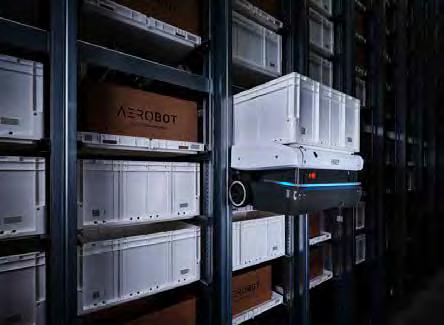

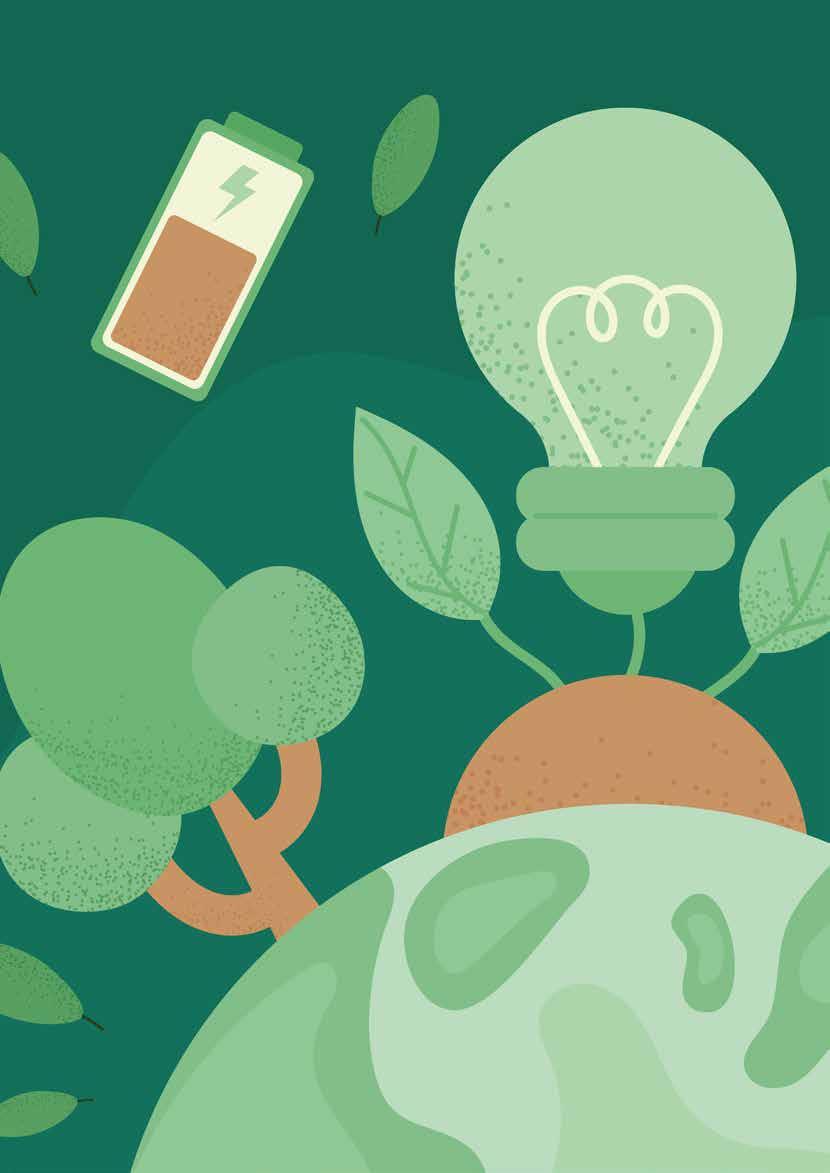

With the right power and sustainability solutions, Australian manufacturing is charging ahead.
72 Interview with Dr Adam Best: Advancing Australia’s Battery Industry
76 Full Steam Ahead: MGA Thermal advances industrial decarbonisation with renewable steam breakthrough and large-scale storage project.
78 Grassroots and Green Loops: From large-scale enterprises to shop floor bids, Australian manufacturers are working hard to reimagine their waste products and potentially generate value from them.
79 W inds of Change – Three WA manufacturers are embracing the challenge of working on wind energy projects, thanks to a bit of government support.
80 Closing the Loop – Guhring Australia managing director Brendan Smith discusses how the company’s carbide recycling program is delivering value for both the planet and his customers.

Adam Best is a Principal Research Scientist at CSIRO, Australia’s national science agency, specialising in battery technology.
In this interview, he discusses his career path, the evolution of battery research, and the opportunities and challenges facing Australia’s battery manufacturing sector.
Q1: Can you tell us a bit about your background and what led you to specialise in batteries?
My background is in material science—I completed a Bachelor of Science with honours, focusing on materials in my final year. I initially wanted to pursue a PhD in chemistry, but due to the competitive environment at the time, I ended up crossing into engineering for my PhD at Monash University. My research focused on solid-state batteries before they became a major field, and I was fortunate to have supportive supervisors in Prof. Maria Forsyth and Prof. Doug McFarlane who encouraged me to pursue this path. The irony was that I ended up doing a PhD because I just really loved the research. I really enjoyed the collaborative and supportive work environment that I had – I had great other student and postdoctoral colleagues supporting me – it was a really exciting and fun time.
During my PhD, I spent time at Chalmers University of Technology in Sweden working for the late Professor Per Jacobssen. Later, I was a post-doctoral fellow at the Technical University of Delft in the Netherlands, working on a collaborative project with Shell Exploration and Production to make batteries for downhole robots. After that, I worked on fuel cell technology, exploring acid-stable polymers, before returning to Australia to join CSIRO as a postdoctoral researcher. I’ve been with CSIRO since 2007, working on a range of battery-related projects.
Q2: What are some of the major projects you’re working on at CSIRO right now?
We’re involved in a number of exciting projects. One of the biggest is a collaboration with the Department of Industry, Science and Resources, stemming from the Australia–US Climate, Critical Minerals and Clean Energy Technologies Compact. We received a $2 million grant to facilitate research and development engagement with the United States, which we’ve used to create five key initiatives.
These include a Researcher Exchange Network, allowing Australian researchers to work with leading US institutions, companies and national laboratories; grants for Australian graphite manufacturers for research on graphite material – particularly natural or innovative synthetic graphites; and studies on the metals for cans and foils used in batteries, like high-purity copper and aluminium. We’re also developing models to predict the demand for critical minerals as new battery technologies emerge and working on technoeconomic modelling to help Australia produce battery materials competitively.
Q3: How do battery standards and safety testing work, and why are they important?
Battery safety is a huge focus for CSIRO. There are strict international standards, like the UN 38.3, which mandates a series of tests batteries must pass for transportation and shipping. Beyond that, organisations like the International Electrochemistry Commission and Underwriter Laboratories set standards for specific applications—whether it’s e-bikes, home storage or electric vehicles.
If you’re an Australian manufacturer, battery safety testing has to be managed through overseas organisations, making this part of development time-consuming and expensive.
At CSIRO, we’re working to create an easier solution for manufacturers, so watch this space!
Q4: How do you see the battery market evolving in Australia, and what are the biggest opportunities for local manufacturers?
Australia’s battery market is poised for significant growth, and I’m optimistic about the opportunities for Australian manufacturers. The biggest opportunities lie in leveraging our rich endowment of critical minerals, particularly lithium, nickel, and graphite, and moving beyond raw exports to high-value downstream processing.
I see the biggest opportunities coming from Australia's natural critical minerals wealth. By investing in advanced manufacturing capabilities, Australia can transform raw materials into essential battery components like cathode and anode materials. For example, converting nickel into NMC cathode material or refining lithium into battery-grade lithium hydroxide or carbonate can dramatically increase the value of our exports. Similarly, upgrading natural graphite into coated, purified, spheronised graphite can boost its market value from around $300 per tonne to over $8,000 per tonne.
This kind of value-adding strengthens our position in global supply chains. There's a big prize if you can do this and do this properly. So, the challenge is there for Australia to get organised to take advantage of these opportunities in a global market. If we get this right, we won’t just be mining the future, we’ll be manufacturing it.
Continued next page
Q5: What is the significance of graphite in battery manufacturing, and what role can Australia play in helping push it forward?
Graphite is indispensable to lithium-ion battery production. About 25% of a lithium-ion battery is graphite and it’s used in every battery of this type. Its role as the primary material in battery anodes makes it a critical mineral in the global energy transition. Australia is fortunate to have substantial natural graphite resources, which gives us a real opportunity. The process involves mining graphite ore, concentrating it, purifying it to very high levels and then coating it to improve battery performance.
Synthetic graphite production is energy-intensive and polluting. But innovation is already underway, including research at CSIRO into low-carbon graphite production using alternative feedstocks. We are working on processes to produce graphite that has a much lower carbon footprint, is more sustainable and better for the environment.
By leveraging our natural resources and renewable energy, Australia can produce more sustainable battery-grade graphite. By committing to this opportunity, Australia can build a competitive, environmentally responsible graphite supply chain that meets rising global demand.
We need to solve how to provide cheap renewable energy, how to make processes more sustainable and find new ways to nurture markets that are competitive to meet global demand?
Q6: How does CSIRO collaborate with industry, and what makes for a successful partnership?
The best collaborations happen when companies come to us with a clear technical problem they need to solve. We can then bring our suite of tools and expertise to address that problem, iterate through prototyping, and help them develop products that meet their needs and those of their customers.
A great example is our work with Energy Renaissance and the development of the super storage product, in that the company had a very clear vision for the type of product they wanted to build, and we were able to iterate through the prototyping process to get to a product that met their needs. We're also able to work with the company to identify local suppliers who could then support them by bringing in the components necessary for them to manufacture a product.
Q7: What are the challenges and opportunities around battery recycling and reuse?
Recycling is going to be critical. The demand for battery materials will soon outstrip what we can supply through mining alone, especially given the long lead times for new mines. Recycling allows us to recover valuable materials from end-of-life batteries and put them back into the supply chain. However, batteries are hazardous devices, and improper disposal can cause fires and other safety issues. There’s a real need for public education around safe disposal and recycling. On the reuse side, there are regulatory and legal challenges— like certifying that reused batteries are safe and determining who is responsible for them. But if we can solve these issues, recycling and reuse could become major industries in their own right. CSIRO is helping to get there with a pilot of Australia’s first dry lithium battery recycling facility which is also working on a new process for recovering lithium electrolyte salt, that can be used for making new batteries.
Q8: What lessons can the Australian battery sector learn from recent industry developments?
One of the big challenges is the low cost of imported batteries. I think we have to play smart and box smarter – we have to collaborate where we can, but we also need to compete where we can, where we need to, to innovate and add value. Our techno-economic modelling helps us understand the supply chain in detail and identify where CSIRO and industry can make the biggest impact.
Ultimately, I believe Australia needs to treat battery manufacturing as a matter of national energy security, much like oil and gas. We need to ensure we have the capability to produce and deploy batteries domestically, especially as we transition to more renewable energy.

Australia is the world's largest producer of spodumene a lithiumbearing mineral
Graphite is a critical mineral and key ingredient in batteries that power everything from phones to electric vehicles and homes.
Image courtesy Australian Museum/CSIRO
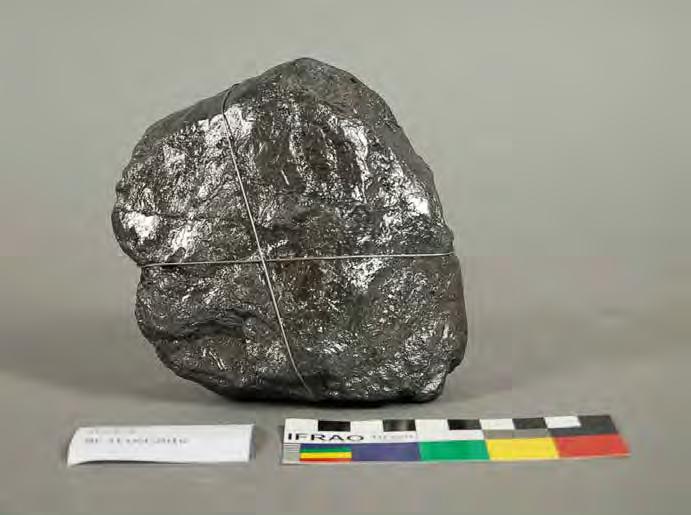
Q9: I know also that you were involved in the foundation of the Australian Battery Society. Can you tell me a little about that and what the organisation aims to achieve?
The Australian Battery Society was started by myself and my colleagues, Professor Neeraj Sharma at the University of New South Wales and Dr Rosalind Gummow at James Cook University, when we made a bid in 2018 to host the International Meeting on Lithium Batteries in 2022. When we took that on, we saw that as an opportunity to think about, well, how can we leave a lasting legacy in Australia for battery technology?
In the early days, our colleagues at Energy Renaissance offered us some money to provide scholarships to allow people to travel overseas and to go and share their knowledge, or go and learn more, or attend some conferences – do some things that would create more value. From that, we've actually had a whole bunch of other great sponsors come online to help us extend that that vision.
We were recently admitted to Science and Technology Australia, so we're now going to have a professional membership aspect of the ABS. So, we're really hoping to grow the community more, tell the story more about batteries, and maybe even do a bit more of an education component.
And I think one of the things that Neeraj, Ros and I are most proud of recently is that our business model has been appropriated by the Canadians and, more recently, by the Indians. We have some fantastic volunteers who help us put our newsletters together and do our events, and our sponsors are extraordinarily supportive as well, and we really value this to create a community.
Q10: What message would you like to leave with people about the future of batteries in Australia?
I think the future is very bright for Australia’s battery industry. We have the resources, the expertise, and the opportunity to become a global leader—not just in mining, but in advanced manufacturing, recycling, and innovation. It will take collaboration across industry, government, and research, but the potential benefits for our economy and environment are enormous. It’s really exciting to see the work that we do and the impact that it can have.
*Interview by Andrew Hobbs. This interview has been edited for clarity and length.*
MGA Thermal advances industrial decarbonisation with renewable steam breakthrough and large-scale storage project.
Renewable energy technology company MGA Thermal has announced two significant milestones that together could reshape how Australian manufacturers and heavy industries decarbonise their heat supply. The company’s latent-heat Electro-Thermal Energy Storage (ETES) system successfully demonstrated the world’s first production of 24-hour renewable industrial steam in April, while work is also progressing on Australia’s largest industrial-scale thermal storage project in Western Australia.
At its Tomago facility in New South Wales, MGA Thermal has built and commissioned a demonstration plant that proves continuous industrial steam generation from renewable energy is possible. The compact demonstration unit (12m long, 3m wide, 4m tall) stores 5 MWh of energy with a 500kW thermal dispatch power, providing continuous superheated steam for a full 24 hours – enough energy to power over 270 homes for the same duration. At its core are approximately 3,700 of MGA Thermal’s proprietary Miscibility Gap Alloy (MGA) blocks, specifically engineered for optimal latent heat storage.
MGA Thermal’s use of latent heat means that energy is stored more compactly, both in terms of physical plant footprint and storage temperature range. This makes latent heat ETES more space-efficient, reliable, energy-efficient, and affordable than sensible heat storage. In an announcement, company co-founder and executive chair Erich Kisi said its technology offered a viable pathway to 24/7 renewable heat for industries, effectively replacing reliance on carbon-intensive fossil fuels.
“Our unique ETES solution efficiently captures and stores surplus renewable energy in a specially designed material, releasing it as high-temperature steam on demand,” he said.
“Our systems react in milliseconds, seamlessly absorbing and deploying energy and therefore at a large scale can participate in grid and energy market stabilisation. This marks a pivotal moment in the journey to decarbonise industries with high and
continuous heat requirements.” Building on that achievement, MGA Thermal is working with Knode, mining and energy company Tronox and professional services firm GHD to deliver a far larger project in Western Australia. The plan is to construct a 180 megawatt-hour ETES system connected to the South West Interconnected System, with capacity to deliver about 20 tonnes of steam per hour to industrial customers.
A pre-feasibility study indicated the technology is economically competitive with gas-fired steam generation, and its integration with the WA grid offers system benefits such as load shifting and renewable firming. The project is entering the Front End Engineering Design phase, with construction targeted for 2027 and commercial operations expected in 2028.
Knode CEO Chris Nelson said the companies were engaging multiple industiral stakeholders up front to develop the asset.
“By derisking the technology and business case at scale, the project has the potential to accelerate rollout for these stakeholders across their facilities globally,” he says. MGA Thermal CEO Mark Croudace says the project represents a genuine breakthrough in industrial decarbonisation.
“This project not only validates the commercial viability of MGA Thermal’s technology at scale, but also demonstrates its applicability to high-temperature industrial heat processes, a critical need that few other renewable technologies can effectively address.”
“As we gear up for full-scale commercialisation, our focus is on partnering with forward-thinking industries, both locally and globally, eager to embrace a sustainable future. The potential for significant emissions reduction is immense, and we are on track to abate 30 million tonnes of CO2 by 2030," he says.



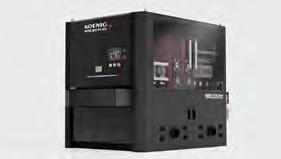




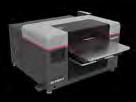
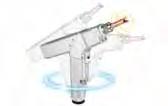
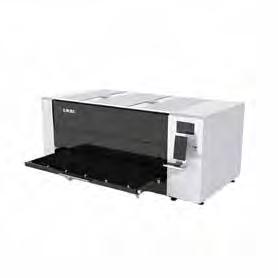
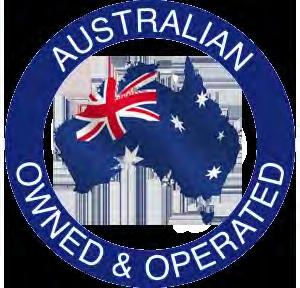



From large-scale enterprises to shop floor efforts, Australian manufacturers are working hard to reimagine their waste products and potentially turn them into value.
Once written off as inevitable byproducts of production, offcuts, worn-out tools and the fine metal filings known as swarf are now being reclaimed as valuable resources. From aluminium extrusion to carbide recycling and even community swarf drives, advanced manufacturers are forging new closedloop practices that conserve scarce materials, cut emissions, and build resilience.
A standout example is Capral Aluminium’s partnership with Sims Metal and Rio Tinto, which closes the loop on aluminium offcuts. In the scheme, post-production aluminium scrap from Capral is sorted and processed by Sims and remelted at Rio Tinto’s Boyne Smelter, creating a domestic circular supply chain. This results in 1,000 tonnes of aluminium with a minimum 20% recycled content being returned to Capral for use in local extrusion operations. The closed-loop scheme is unique in keeping the metal in Queensland at every stage of the process – from mining and refining through to smelting, extrusion and remelting. The benefits are twofold: reduced emissions compared with virgin aluminium, and a secure, circular feedstock in a market where supply chain volatility is a constant concern.
Capral managing director Tony Dragicevich says the program builds on a successful trial with Rio Tinto that took place in 2024. “Working together enables us to offer our customers extruded aluminium options that support circularity, strengthen local supply chains, and reinforce the role of Australian manufacturing in a low-carbon future,” he says. Recycled carbide
As Capral recycles its aluminium, metalworking and manufacturing solutions expert Sandvik Coromant is supporting a tool recycling scheme with one of the largest specialist heavy equipment manufacturers in Australia. Sandvik Cormorant is collecting worn carbide inserts and carbide buttons used within high pressure grinding rollers (HPGRs), which will be recycled to produce new tools. In an announcement, Sandvik Coromant said it had worked with this equipment manufacturer to supply carbide inserts for over a decade – and now the companies were working together to improve material circularity across the supply chain. These particular rollers are used for rock crushing and size reduction, typically compressing the feed material between two rotating rollers. The crushing plates are implemented with over 1,000 carbide buttons, or studs, to aid the crushing of the rocks. Sandvik Coromant’s carbide recycling scheme enables customers to sell their worn-out tools back to Sandvik Coromant, allowing valuable materials such as tungsten and cobalt to be extracted and reused in the production of new cutting tools.
In total, the company has provided Sandvik Coromant with 17 tonnes of material so far – all of which is shipped to Sandvik Coromant’s Wolfram facility in Austria, where they undergo chemical processing to turn them back into the carbide powder used to produce new machine tools.
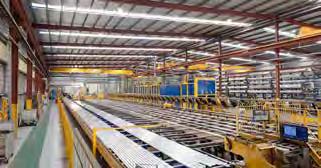
The reclaimed powder undergoes chemical purification, recovering materials with the same properties as tungsten originally extracted from the Wolfram mine.
“Recycling is an integral part of modern manufacturing,” said Manny Valenza, sales cluster manager for Southeast Asia at Sandvik Coromant. "We find 95% of a used carbide insert can be recycled, with tungsten making up around 75% of the material. As tungsten reserves are limited, it’s even more essential to preserve this vital material while minimising its environmental impact."
“The closed-loop manufacturing process we’ve created is a win-win for both our customers and for the environment. By recovering valuable materials from used tools, we’re closing the loop on production waste, reducing the need for virgin materials and creating a more sustainable future for the manufacturing industry,” he said.
But far from the larger schemes, a grassroots initiative from the shopfloor is proving just as powerful. The Australian Manufacturers Collective, an initiative founded by KH Equipment and supported by Okuma Australia, is aiming to bring metalworking businesses across Australia together to help provide tangible aid for Australian farmers facing hardship. The Collective is urging metal cutting workshops with machines that produce swarf and scrap to recycle it and donate the proceeds to Rural Aid through the Australian Manufacturers Collective link, reachable via https://fundraise. ruralaid.org.au/t/australian-manufacturers-collective.
By donating the proceeds from the sale of swarf (as part of a company’s pre-tax income) to Rural Aid, operators will have an immediate tax deduction as well as directly supporting the long-term sustainability of Rural Aid’s programs.
Inspired by an initial donation of $2,120 from KH Equipment and matched by Okuma Australia, the Collective is off to a good start to reach its initial target of $22,000 — enough to fund one truckload of hay (80 bales) through Rural Aid. Thanks to generous truck drivers donating their time and fuel, every dollar goes directly to those in need.
Three WA manufacturers are embracing the challenge of working on wind energy projects, thanks to a bit of government support.
The Western Australian Government has co-invested with three companies looking to generate jobs with wind energy. The state government’s Wind Energy Manufacturing Co-Investment program saw $8 million allocated for co-investment funding with local manufacturers to help them increase their participation in wind energy supply chains.
RCR Advanced Technologies has so far received the biggest grant under the program, receiving $2.05 million to support its $5.31 million project in to begin manufacturing transition flanges for wind towers. Transition flanges are a critical component in the base of wind towers that connect the turbine tower to its foundation, reaching around 5.5m in diameter and which are currently sourced from overseas.
The 18-month project will create a wind turbine component refurbishing centre at the company’s Bunbury site, allowing it to invest further in advanced machinery, such as robotic welding and painting cells, as well upskilling their workforce.
The co-funding project, designed and delivered in partnership with the Advanced Manufacturing Growth Centre (AMGC), will also link RCR with global wind energy manufacturer Vestas. In addition, RCR has held early discussions with renewable energy project developer Green Wind Renewables on possible future involvement in their large portfolio.
Green Wind Renewables is currently developing a number of large-scale wind farms in the South West Interconnected System – Western Australia’s main energy grid. RCR Advanced Technologies manager Neville Kelly says the project offers opportunities for the company, their workforce and the larger region. “RCR is in a prime position to upskill local workers and provide employment related to modern energy sources, while leveraging our mining sector heritage in engineering projects to meet burgeoning demand from the onshore wind energy supply chain in Western Australia,” he said.
AMGC has further announced two other co-investments under the program – the first being $488,204 to large coil components manufacturer Australian Winders to help it begin manufacturing components for electrical generators and motors. The investment was made to help Australian Winders to upgrade its coil line with new equipment, including robotic taping heads, hydraulic hot presses, and automated testing systems, allowing the company to boost the speed and quality of coil looping, spreading, and wire insulation to meet international standards. Australian Winders managing director Tony O’Brien said at the time that the company had been unable to take on new contracts or pursue new growth opportunities, as its manufacturing operations were already at maximum output.
“By increasing production capacity and automating key processes, this co-investment via the WA Government will remove existing bottlenecks, improve efficiency, and reduce lead times,” he said. “This expansion will not only allow Australian Winders to grow within our existing markets but also create the capacity needed to explore new opportunities, ensuring the company remains competitive and responsive to industry needs.”
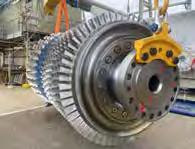
Turbine Solutions will use its gas turbine expertise for renewable energy applications.
A third co-investment of $453,230 will help Turbine Solutions leverage its expertise in gas and oil turbine maintenance to deliver specialised services for the maintenance and refurbishment of wind turbines.
In partnership with a global manufacturer of wind turbines, Turbine Solutions will focus on commercialising services such as bearing replacements and borescope inspections of main shafts which are critical to turbine performance and uptime. Bearings enable the rotation of key components inside the nacelle, including the main shaft, gearbox, and generator. Their maintenance is complex, requiring precision tools, stringent safety protocols, and highly trained personnel, particularly given the remote locations and high-altitude environments in which turbines operate.
By leveraging its experience in the oil and gas sector, Turbine Solutions aims to reduce turbine downtime, improve safety, and deliver faster, locally delivered maintenance using customised tools and wind-specific training.
Turbine Solutions said it would also adopt ISO 9001 and turbine-specific safety standards, upskill staff through Global Wind Organisation (GWO)-certified training and introduce advanced tools, such as Quick-Switch and BoltSafe sensors, alongside custom tooling for safer access and real-time monitoring. These technologies, though new to the wind sector, are well-proven in oil and gas services.
Applications to the Wind Energy Manufacturing Co-Investment Program are open, continuous, and competitive until available funding has been exhausted. The co-investment program consists of two streams:
• Market entry stream: Capability-focused, indicative project size $20K-$60K (co-investment contribution $10K-$30K). This stream supports pre-qualification and accreditation processes, niche software, process improvement and alike.
• Market growth stream: capacity and capability focused, including capital and/or operating expenditure. Indicative project size $500K-$1 million (Co-investment contribution $250K-$500K). This stream supports plant and equipment enhancement (up to 25% of total project cost), R&D projects to create a competitive advantage, and associated investment in ‘market entry’ projects.
Manufacturers interested in applying for funds under either of the two program streams can access written guidelines and a pre-recorded webinar via https://www.amgc.org.au/windenergy-program.
Guhring Australia managing director Brendan Smith discusses how the company’s carbide recycling program is delivering value for both the planet and his customers.
Modern day machining is heavily reliant on carbide. We use it to make the tools that cut, shape, and machine products that directly or indirectly affect our day-to-day life. But what happens when a carbide tool reaches the end of its life?
For many, the answer has been simple but wasteful: throw it away. Guhring aims to change that mindset with a carbide recycling program that is proving to be as beneficial for customers as it is for the planet.
The idea is straightforward. Used carbide tools are collected, recycled, and turned back into raw material for new tools. However, the execution is where Guhring’s approach stands out. This is not a side project or an occasional green initiative. It is a full-fledged, integrated service built into the company’s operations, with a focus on both environmental responsibility and customer advantage.
Turning scrap into opportunity
Most people do not realise just how valuable carbide is. Beyond its role in producing high-performance cutting tools, carbide is essential in many other industrial and commercial applications. It’s a finite resource, made primarily from tungsten carbide and cobalt; both of which are costly and energy-intensive to mine. Discarding a worn carbide tool isn’t just throwing scrap away; it’s losing a resource that could have been recovered, reused, and transformed; saving energy and reducing environmental impact.
Guhring’s recycling program closes that loop. Through its Tool Circle service, customers can return their worn tools directly to Guhring. The carbide is reclaimed, processed, and reintroduced into manufacturing. The result is a circular system where yesterday’s tools become tomorrow’s products,
all while reducing the long and costly process of mining, refining, and processing the raw materials. This matters for two big reasons. First, recycling carbide uses far less energy than mining it from the ground, which means fewer emissions and less harm to the environment. Second, it offers potential savings for customers. Scrap carbide has a high market value, and Guhring ensures customers see a fair return on their old tools in the form of direct credit.
One of the challenges in modern manufacturing is balancing performance demands with sustainability goals. Guhring’s program solves this problem in a way that feels effortless for customers. Instead of having to coordinate with multiple service providers or navigate complex disposal regulations, customers can simply send their used tools back through Guhring’s established collection network. In Australia, this convenience is especially valuable. Tool users often operate in remote or regional areas, where scrap management can be costly and time-consuming. Guhring’s local presence means that even in far-flung locations, customers can still take advantage of the recycling service without disrupting their operations. The company’s established distribution channels double as collection points, making the process both efficient and familiar.
For customers who already rely on Guhring’s cutting tools, this is an easy win. The same company that supplies their tools is now helping them recover value from those tools at the end of their life. There’s no new learning curve, no complicated paperwork, and no extra logistics.
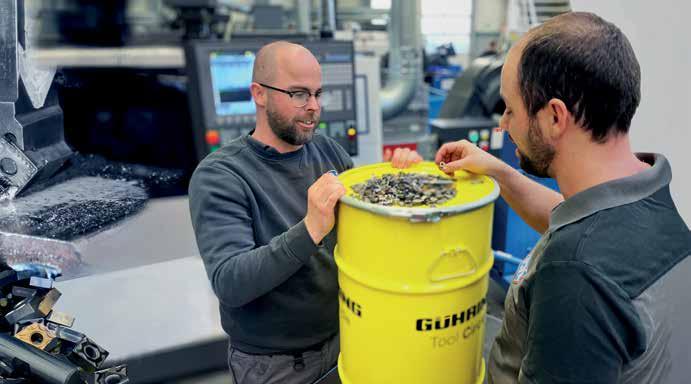
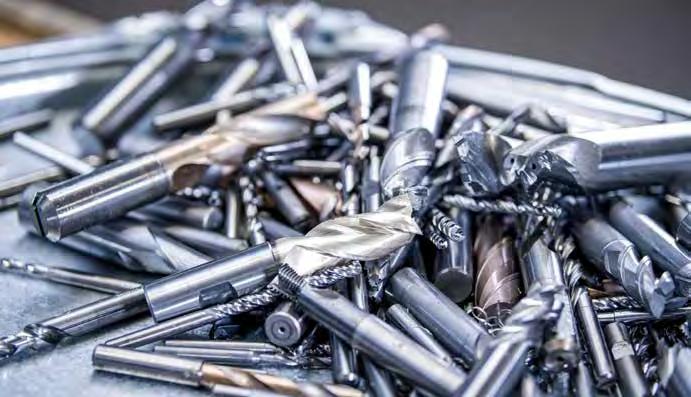
Globally, manufacturing is under increasing pressure to prove its commitment to sustainability. Environmental compliance requirements are tightening. Customers and stakeholders are asking harder questions and large-scale buyers are favouring suppliers who can demonstrate responsible sourcing and waste reduction.
Carbide recycling fits neatly into this shift. With the Guhring Tool Circle program, companies can point to measurable environmental benefits, backed by real data. Every kilogram of recycled carbide reduces demand for mined ore, cutting energy use by up to 70%. That's not just a talking point; it's a quantifiable action that companies can include in their sustainability reports, tenders, and certifications.
In Australia, where industries like mining, aerospace, and manufacturing operate under close environmental scrutiny, this kind of initiative can also help businesses strengthen their position in competitive bidding processes. When a company can show it’s aligned with sustainable practices without compromising on productivity, it stands out.
A partnership that pays off Guhring’s approach isn’t purely transactional. The company’s long-term relationships with its customers mean the recycling program is designed to work hand-in-hand with other services, such as tool regrinding and recoating. Often, tools returned for reconditioning are sorted and those past their usable life are diverted into the recycling stream. This integrated model maximises the value extracted from every tool. Customers get extended tool life through regrinding and recoating, and when that life is over, they get financial return through recycling. It is a full lifecycle service that transforms what was once considered waste into a source of revenue or cost savings. The added bonus is that this cycle supports the broader supply chain. By reducing the need for mined tungsten and cobalt, Guhring helps stabilise supply and manage price fluctuations, which benefits all customers, not just those participating in the program.
The future of carbide recycling lies in scaling up participation. While many of Guhring’s customers are already involved, the potential for industry-wide adoption is enormous. As more businesses experience the economic and environmental benefits firsthand, recycling is likely to become the default rather than the exception.
Guhring’s role in this shift is significant. By embedding recycling into its core services, the company removes the friction that often stops businesses from adopting sustainable practices. The result is a program that is as easy to join as it is rewarding to stay in.
In the end, this is more than just about carbide tools and scrap. It’s about recognising the value in what we once considered waste and building systems that make recovery and reuse the norm. For Guhring, for its customers in Australia, and for the planet, that’s a cycle worth repeating.

BRENDAN SMITH Managing Director, Guhring Australia
Wearable technologies take medical solutions to a new level.
84 Vital Signs – Four leading medical technology developers discuss the road to commercialisation and building the future of medical manufacturing in Australia.
87 Hands-free healing – Smart wound monitor poised to improve chronic infection care.
88 Upgrades easier with Cochlear change – Inter nal memory, upgradeable firmware and more efficient power and data transfer are among the upgrades promised by Cochlear’s Nucleus Nexa System – designed and manufactured in Australia.
89 Ending Bubble Trouble – Grant to support technology with medical and industrial manufacturing implications.
90 Scalpels, sensors and servo motors – Medical manufacturing robots aren’t sci-fi. They’re the sharp end of advanced manufacturing, says Nathan Kirchner, a founding director of the Australian Robotics Group
Four leading medical technology developers discuss the road to commercialisation and building a future for medical manufacturing in Australia.
When it comes to medical innovation, Australia has much to be proud of – with world leading research institutions and great minds hard at work developing products for the greater good. But taking that success in innovation and transitioning it to success as a leader in advanced medical manufacturing is another challenge – with four panellists at a recent forum explaining their own reasons why.
BioMelbourne Network’s BioForum, The Smart Health Revolution: Rewiring Care Pathways, held in late July, heard from three developers of new wearable technologies –Nutromics chief executive Peter Vranes, Kali Healthcare cofounder Fiona Brownfoot and Proton Intelligence co-founder Victor Cadarso – along with Madhu Bhaskaran, research director of the Discovery to Device medtech prototyping facility at RMIT University.
In her role at RMIT University, Bhaskaran leads a team of electronic materials engineers, helping companies create technologies and better design medical products including care diagnostics – such as saliva-based tests - or which are either designed to operate near a patient, or be worn by them.
“Basically, a wearable is something which monitors the world within you and the world outside of you,” she says.
Ranging from smart patches and biosensors to remote monitoring wristbands, today’s wearables offer the possibility of capturing data from a patient in real time, and enabling earlier intervention in case something goes wrong.
But panellists agreed design is central to their success – a clunky, uncomfortable or intrusive device risks being abandoned by patients before it delivers value. For Brownfoot, whose Kali Healthcare is aiming to develop wearable foetal heartbeat monitors for expectant parents, working with midwives and obstetricians was essential to developing the product.
“One of the key things that we found was that women don’t like things over their umbilicus (navel) – they find it really irritating, it’s a really sensitive area,” she says. “So that’s why our design is in a C shape, leaving the umbilicus free… A lot of work has gone into these designs, but if patients are not able to use the technology well, then it’s just never going to be able to improve outcomes.” And this is for a technology that 90% of the people surveyed said they wanted, both for convenience and peace of mind.
Bhaskaran notes that some patients in aged care facilities had raised objections with existing nearable technologies, which monitor a patient while near them, including footpads patients stepped on when getting into or out of bed.
“Some didn’t like using it, so they kicked it under the bed the first time they got in,” she says. With another nearable technology of mattress sensors, Bhaskaran’s team had completed about 6,000 related cycles of testing before setting it up in an aged care home – only to find all sensors were offline the next day. “And then we realised someone had yanked off the cable when they were making the bed… and then two weeks later somebody borrowed the cable to go charge their phone,” she says.

Peter Vranes, Nutromics chief executive, and at right, a Nutromics wearable.
“Human beings can break technologies in more creative ways than we can come up with in the labs – so I think the sooner we get our technology into the hands of people who are capable of breaking it, the better, and the more insights we will gain from it.”
In the field
Bhaskaran has seen a series of different companies work to make the move from the early stages through to commercial production, many working from RMIT’s Micro Nano Research Facility. “Companies could make four or five or 10 sensors, but the minute they had to start making hundreds and thousands was where they tripped up every single time,” she says.
“Most manufacturing partners can work with you once you start talking order quantities of 10,000, so we really needed an injection of funding and a facility which will kind of cover that gap, while keeping sovereign manufacturing in mind.”
Discovery to Device, the new Victorian medical device prototyping and scale-up facility expected to open next year, will enable medical technology manufacturers to access specialised expertise and infrastructure, as well as a competitive and cost-effective design and user engagement solution.
“It's a sovereign medtech prototyping facility. what it basically allows you to do is to scale up volumes to support field trials – it’s an external facing facility supported by the Victorian government,” she says. “We are really hoping to keep a lot more startup companies afloat and bridge that ‘Valley of Death’, which sits between making a few prototypes and actually going into manufacturing.”
Vranes’ company Nutromics has designs already in place for a manufacturing facility that the company hopes will deliver about 10 million of these patches every year – and create roughly $3 billion in export revenue.
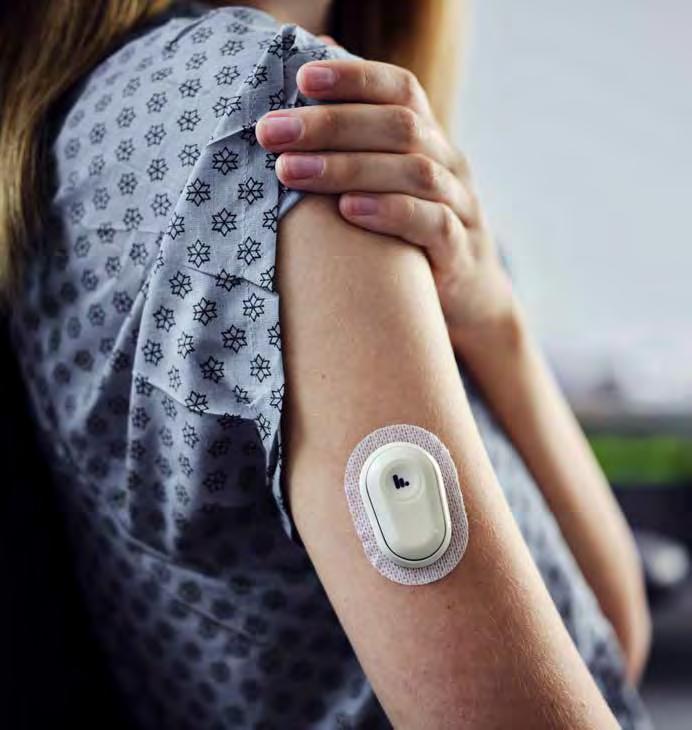
Nutromics wearables are designed to monitor any diagnostic target or drug continuously and in real time.
The company is starting with monitoring of the antibiotic vancomycin, which Vranes says is given to one in every six ICU patients, but which could also very easily be overdosed, injuring the kidneys through which the drug is cleared.
“Our first market is a patch with a vancomycin sensor so that clinicians can measure vancomycin in their patients in real time – to keep the dose in the therapeutic zone and outside the toxic zone,” Vranes says. Beyond that, the company is planning on developing sensors to monitor for sepsis, cardiology, triage and the next generation of continuous glucose monitors (CGM).
“And the beautiful thing about this pipeline is that they're all leveraging the same platform. All we do is swap out the sensor on the end, on the tips of those microneedles….
We can solve these big unmet needs in healthcare, and all of these come off the same manufacturing line,” he says. Vranes adds that he sees a great deal of new interest in wearables – saying the interest was coinciding with a surge of interest and activity in Artificial Intelligence.
“That’s the perfect storm really. When you’ve got huge data sets from wearables combined with the power of AI, then you can truly have some really big shifts in consumer healthcare. And I think that’s really exciting,” he says. “We have that vision because no matter how the patient goes through the hospital system, whether it's triage, treatment or outpatient, the patch will give really substantial clinical utility to the hospital, to the patient, and it'll save a lot of money as well.”
Continued next page
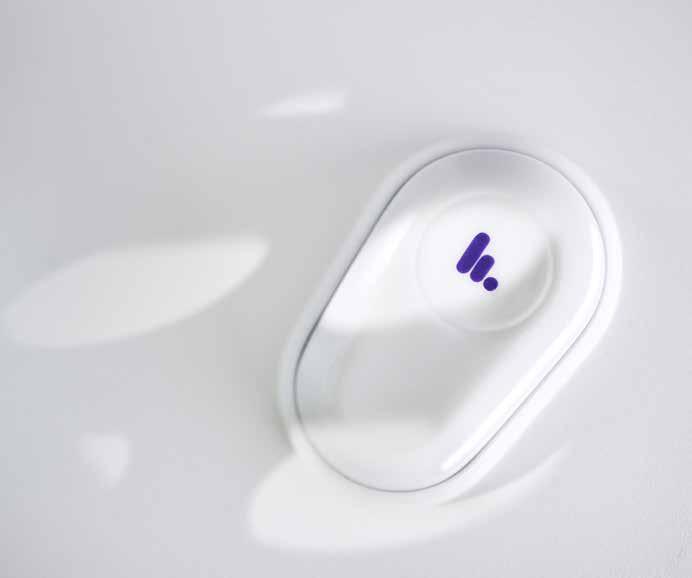
Bhaskaran says she is excited for the arrival of the new prototyping facility, which she said had been a significant barrier to medtech startups.
“That was our biggest bottleneck in some ways because many technologies are handmade at the moment. You have a dedicated team of people who are sitting at the microscope and hand-assembling those tiny electronic components, which means you can’t make more than 40 at any given time,” she says. “So having something that can semi-automate it is something that we were really lacking.” She adds that more widely, she has observed a renewed interest in sovereign capability and a greater interest in doing more manufacturing on Australian soil following the COVID-19 pandemic. “I know it may not happen with every single case, but the longer we can do it and retain valuable IP onshore, the better.”
But the need for sovereign capability also extends to the workforce – and helping to equip STEM students with the skills to succeed in medtech was also important, she says. "Some of the skills sets and masters’ degrees have to be shaped around cross-sector collaboration … in Australia, once you’re out of academia it is very hard to make a comeback,” she says. “When you can have that as a two-way door between sectors such as academia and industry and have that cross pollination of ideas and people, I think things will go much further and much faster.”
Vranes says that there are many things to praise in Australia’s approach to creating new technologies – including the research and development tax incentive and the way clinical trials are conducted. “But there are things we don’t do well. Funding is a huge problem, and it’s a doubly huge problem when we’re in the financial market that we’re in,” he says.
With low levels of private investment had come fewer initial public offers, fewer mergers and acquisitions and less money flowing back to venture capitalists as a result. “We have a liquidity issue, and it won’t be there forever… but we have got to get back to that place – and that is where governments are stepping in in a pretty major way for various obvious reasons, because they want to protect their industries.”
He says that government support had been vital for some of Australia’s most successful medical technology companies, and said strong investment in these companies had a proven record of success. Match funding, where governments matched an investment above a high threshold in companies working in priority areas, would be a beneficial use of public funds, he adds.
“If the government is going to participate and really help companies, you don’t really necessarily want them competing with venture capital firms around the world"
“What [governments] do really well is grant funding, and that’s fantastic… and I think the return on investment on those public funds would be very, very high.”
Smart wound monitor poised to improve chronic infection care.
Researchers from RMIT University have developed a wearable wound monitoring device with integrated sensors that could reduce infection risks by minimising the need for frequent physical contact. Standard methods require regular removal of wound dressings for assessments, often delaying crucial interventions, whereas this invention monitors healing remotely via a Bluetooth connection.
The proof-of-concept device is designed for reuse, making it more cost-effective and practical than disposable smart bandages and other emerging wound monitoring technologies. Globally, millions of people suffer from chronic wounds, impacting their quality of life and incurring significant healthcare costs. In Australia, about 500,000 people are affected, costing the healthcare system $3 billion annually.
Lead inventor Peter Francis Mathew Elango said the device used advanced integrated sensor technology – including inflammation, pH and temperature sensors – to continuously track key healing indicators. High temperatures signal inflammation or infection, while changes in pH levels can indicate different stages of wound healing. “We tested our wound monitoring device by simulating conditions it would encounter in wound management. We placed the device on a human arm to demonstrate that it conforms well to the curved surface,” says Elango.
“This was a test to show that this type of alternative monitoring technology is possible, and we are now ready to work with industry partners to develop it for clinical trials.
“Its components are biocompatible and fit seamlessly into existing manufacturing workflows and processes, potentially bringing the cost below $5 per unit when produced at scale.”

An RMIT-patented technology platform underpins this innovation, with flexible sensors that can be placed on or next to a wound under dressings. “The high-resistivity silicon-based sensor technology is our platform IP that has been proven to be efficient at multiple biomarker detection related to different ailments,” said team leader Madhu Bhaskaran.
Bhaskaran’s Functional Materials and Microsystems Research Group at RMIT has a strong track record developing medtech devices, including bedding sensors for use in aged care to monitor sleep quality and comfort. Meanwhile, earlier work led by Elango on a wearable heart monitor is now progressing towards commercialisation through a partnership with Perthbased Lubdub Technologies.
Words and Images: Will Wright, RMIT University
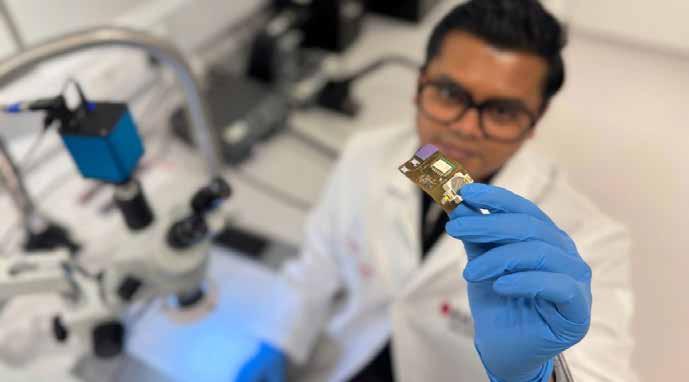
Internal memory, upgradeable firmware and more efficient power and data transfer are among the upgrades promised by Cochlear’s Nucleus Nexa System – designed and manufactured in Australia.
Cochlear’s Nucleus Nexa System – designed and manufactured in Australia – brings upgradable implant firmware to its renowned cochlear implants.
Australians are among the first in the world to access the system, with Cochlear saying it will revolutionise how people with hearing loss access future technology.
Released locally in June, the system features internal memory and upgradeable firmware in what company chief technology officer Jan Janssen says is “a new cutting-edge chipset.”
“This is the first cochlear implant with its own firmware, so the device can be upgraded to new features and advancements throughout the user’s lifetime,” he says.
Previous cochlear implants requried users to upgrade their sound processors to access some of the latest innovations, but this limitation is removed with the Nucleus Nexa System, Cochlear says. Instead, Nucleus Nexa System users can experience new features and advancements through updates to their smart implant's firmware and upgrades to their sound processor over time.
“Just like a smartphone receives a firmware update, now people with a Cochlear implant can stay connected to the latest technology updates today and well into the future,” says Janssen. The system boasts onboard diagnostics that monitor system performance to ensure optimal hearing, with the new chipset to serve as the platform for future upgrades to the Cochlear implant.
At the same time, its internal memory allows a user’s individual hearing settings to be securely stored directly in their Nexa implant, meaning the settings can be transferred to a new processor if the current one is lost of damaged. “Previously, if a user misplaced or damaged their sound processor, they would need to visit a clinic to obtain a replacement sound processor,” Janssen says.
“This replacement device would need to be programmed with the user’s personalised hearing settings in the clinic by a cochlear implant professional, taking valuable time from both the professional and the user.” With the new system, a user would simply need to receive a “blank” sound processor and their settings would be transferred over.
This would “allow a person to hear with their cochlear implant again in in a matter of seconds,” Janssen says. On top of this, the system can automatically adjust its listening settings to help people hear more clearly.
The Nexa implant also features a new gold implant coil and RF Link technology with dynamic power management, which ensures more efficient power and data transfer between the sound processor and the implant, automatically maximising battery life for each user.
Cochlear has provided more than 750,000 hearing implants to people around the world and the company’s implants are the most reliable in the industry.

Grant to support technology with medical and industrial manufacturing implications
Melbourne-based medtech company Haemograph will join La Trobe University in a new research initiative that aims to tackle the widespread problem of air bubbles in medical devices and industrial processes. The collaboration, supported by a $3 million Cooperative Research Centre Project (CRC-P) grant from the Australian Government, will develop technologies to prevent and remove air bubbles—an issue with major implications for both health and manufacturing.
Air bubbles in medical equipment can lead to serious complications such as air embolisms, while in industrial applications they add inefficiency and waste. For example, nitrogen purging is commonly used to reduce trapped gases in wine bottling, but the process consumes significant energy and contributes to environmental impacts.
Potential outcomes from the project include air-free syringes, advanced diagnostic devices, and air-free pump-filling systems—all of which promise to cut waste, reduce emissions and improve safety standards.
Haemograph is currently developing its Air Evacuation Syringe using its Autovalve technology, designed to eliminate air bubbles during preparation without the traditional “tap-andsquirt” method of testing. Company chief technical officer Alex Lubansky says the partnership with La Trobe represents a major opportunity to scale innovation. “This is a chance to advance and commercialise technologies we believe will deliver real benefits for both health and industry,” he says.
Associate Professor Ing Kong from La Trobe, who is leading the research, said the CRC-P funding would help address a critical, long-standing challenge.
“By creating cuttingedge solutions, we aim to improve safety, reduce costs and develop sustainable technologies that will benefit both industry and the community,” she said.
La Trobe University’s Deputy Vice-Chancellor Research and Innovation, Chris Pakes, added that the project highlights the power of industry-academic collaboration.

“This grant is recognition of Ing’s leadership and her collaborative approach to working with industry to drive innovation,” Pakes says
“La Trobe is proud to support research with fantastic partners like Haemograph that promises to push technological boundaries and deliver practical, real-world benefits.”

AMTIL’s corporate partners offer a selection of products and services that will benefit our members in their business. For any enquiries about our Corporate Partnerships, and how they can benefit you, contact AMTIL on 03 9800 3666. Our Partners. Our Members. Your

Medical manufacturing robots aren’t sci-fi. They’re the sharp end of advanced manufacturing, says Nathan Kirchner, a founding director of the Australian Robotics Group.
Sparks fly in mining. Sparks fly in medical robotics, too. Just smaller, smarter and sterilised. Welcome to the operating theatre of advanced manufacturing, where the tolerances are tighter, the stakes are higher, and the robots are no longer just strong. They’re perceptive. They’re adaptable. And they’re collaborating with humans at a level that would make a cobot blush.
This isn’t about putting arms on an assembly line. This is about building biomechanical implants to microns of precision. About manipulating silicon, polymers and metal inside sterile fields where a sneeze can ruin a product. About automation that isn’t just programmed, but aware. The medical manufacturing sector is fast becoming a proving ground for the best of robotics, sensing and human-machine symbiosis. And if you care about the frontier of advanced manufacturing in Australia, this is where to look.
Medical manufacturing robots: the power-user pushing the limits
Medical manufacturing is precision at scale. These aren’t oneoff prototypes built slowly on lab benches. Think hip implants, spinal rods, dental scaffolds and surgical instrumentation. Thousands of units, all required to meet the same brutal tolerances, every single time. Traditional machining can’t keep up. Humans can’t hold that standard all day. This is where robotics steps in.
Medical manufacturing robots are purpose-built for ultra-high precision, cleanroom operation and dynamic reconfigurability. They’re fast but not brutal, strong but not rigid and programmable for repeatability while responsive enough for variation. That’s not an easy combination. It requires the intersection of multiple advanced technologies coming together in tightly integrated stacks: robotics, automation, perception, human-machine interaction and compliance control.
And none of it works in isolation.
Sensing and perception: when seeing is manufacturing
Medical robots don’t work by rote. They rely on vision. But not just any vision. We’re talking structured light scanning, high-resolution 3D machine vision, force torque feedback, even real-time surface topology tracking. In medical manufacturing, the part may be less than a millimetre thick. The required tolerance may be within ten microns. That’s thinner than a human hair.
Perception, not just actuation, is where the magic lies. The robot must identify material inconsistencies, trace complex organic shapes, compensate for thermal expansion and align cutting paths with biological realities. That demands real-time sensing. It demands perceptual robotics that doesn’t just execute pre-programmed movements, but adapts continuously. There’s no room for guesswork.
This advanced perception is already being pushed in other demanding sectors: aerospace machining, electronics packaging and even some applications in defence. But medical manufacturing takes that learning and dials the
need up to 11: high repeatability, extreme surface finish and real-time variation control. It is here that the capabilities of automation systems are stress-tested to their limits and often redesigned entirely.
Human machine interaction: not just coexistence, collaboration
Medical robotics isn’t fully automated. Nor should it be. Human oversight is not a nice-to-have; it’s a necessity. A technician might need to guide a robot during calibration. An operator might hand-finish a part or initiate a reconfiguration based on a patient-specific file. The line between machine-led and human-led is blurred by design. This is where human-in-the-loop robotics earns its place –not as a workaround but as the deliberate architecture of trust, safety, and adaptability. A robot doesn’t need to replace humans. It needs to respond to them, interpret intent, adjust motion and share context. And in medical robotics, where failure isn’t just expensive but dangerous, this feedback loop is essential. Real-time control decisions, informed by a person in the loop, allow far more nuanced judgment calls than any fully autonomous system can deliver.
The field of human-machine interaction (HMI) truly comes into its own here. We’re not talking about old-school operator panels or blinking light consoles. We’re talking intuitive, context-aware interfaces. Voice control. Gesture response. Haptic feedback. Wearable interfaces that allow a skilled technician to direct a robotic end effector like an extension of their own body. This represents surgical-level interface design, utilised in industrial production contexts.
Australia is ripe to take this further. With a strong history of surgical robotics research and a growing national interest in sovereign advanced manufacturing capability (see AMTIL’s strategic push), there is enormous scope for crossfertilisation. Medical HMI development has long benefited from ergonomics and surgical simulation. Now, we can start to reverse that. Using power user needs from medical to drive breakthroughs in HMI and human-in-the-loop control across heavy industries.
Not niche. Not luxury. Not optional
It’s easy to assume that medical robotics is a niche application. Too specialised. Too costly. Too custom. But that thinking is outdated. What’s actually happening is that medical manufacturing is showing us what the rest of advanced manufacturing will look like in five years. Maybe three. Maybe less.
Multi axis robotic arms that can self correct based on vision input? Already there. Custom tooling that integrates embedded sensors and real time data streaming? Becoming standard. Human machine collaboration that responds to touch, gaze and environmental changes?
The baseline is rising fast. And the investments being made in medical manufacturing are directly accelerating this evolution. It’s not just a beneficiary. It’s a catalyst.
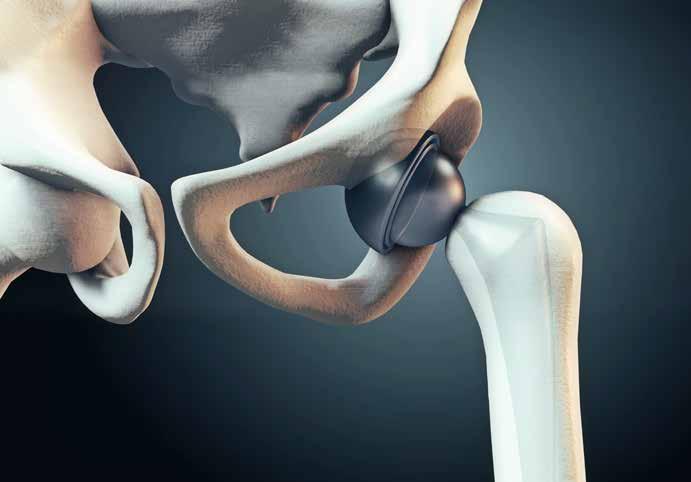
Symbiosis, not silos: the cross pollination of tech and tactics
The most exciting part? The transferability. The fields aren’t isolated. They are deeply symbiotic. Techniques perfected for robotic surgical equipment handling, ultra clean operation, micro torque precision and adaptive feedback are now bleeding into flexible manufacturing cells for semiconductors and aerospace composites.
Likewise, the perception stacks developed for high mix low volume medical assembly, where every bone plate might be slightly different, are being picked up in custom auto parts, advanced electronics and even mining sensor platforms. And the inverse is true too. Pattern recognition from defence, materials handling from agritech, vision-guided manipulation from logistics: all feed into medical, improving outcomes, increasing automation rates and decreasing the cost per unit. This flow isn’t accidental. It is a natural consequence of converging technologies finding their most demanding users. Medical manufacturing is a power user space. Like Formula One for robotics. The learnings are hard-won, but the downstream payoff is massive.
Australia, now’s the time to lean in
This is more than a technical shift. It’s a market signal. Australia has every reason to lean in. We’ve got strong public health infrastructure, a growing biotech sector and a real government appetite to see domestic manufacturing return. We also have unique strengths in sensing, robotics and interface design. Think Australia’s Robotics Institute, the Australian Centre for Robotics and startups coming out of university labs that are pushing new paradigms in surgical navigation and tactile feedback.
The convergence of robotics, sensing and HMI for
medical manufacturing isn’t coming. It’s already happening. The companies that get involved now – whether they’re in defence, mining, space, or biotech – will be the ones shaping not just the future of medical production but the future of all high-performance manufacturing.
And frankly, if we’re not building to this level of precision, responsiveness and integration, what are we building for?
In this theatre, the scalpel is robotic, the vision is machinedriven, and the human is still centre stage
You don’t have to be in medicine to be in medical manufacturing. You just have to care about building better, faster, cleaner, and smarter. Advanced manufacturing isn’t coming from the top down anymore. The sharpest end users are pulling it up. The ones who literally cannot afford an error. This is where real tech meets real need. Where capability meets consequence.
And the sparks? Still flying. Only now, they’re under a microscope.

NATHAN KIRCHNER Founding director, Australian Robotics Group
Across Australia’s precision manufacturing sector, AMTIL continues to deliver exceptional value to its members through hands-on learning, strategic collaboration, and national leadership. With a calendar packed full of site visits, safety workshops, a national summit, and the upcoming AGM, AMTIL is actively shaping the future of advanced manufacturing, while ensuring its members are informed, connected, and empowered.
AMTIL’s commitment to member value also extends to workplace safety. This year, a series of Machine Safety Assessment Workshops were held across Victoria, New South Wales, South Australia, Queensland, and Western Australia. Facilitated by Machine Safety Australia, these sessions are designed to help manufacturing professionals assess and mitigate machine safety risks under the AS4024 standard.
Led by Sergej Patkovic, a certified machinery safety expert, the workshops blend technical theory with practical, real-world examples, including applicable case studies from historical business experiences. Attendees consistently praised the sessions for their relevance, clarity, and impact.
“Serg is a very engaging facilitator with excellent knowledge,” said one participant. “The practical exercises helped me understand how to apply the standards in our own shop. Learning about the legal implications of safety failures was eye-opening.”
Whether you're a technology user or supplier, these workshops offer critical insights to improve safety culture, reduce hazards, and ensure compliance. For many attendees, the sessions provided not only knowledge but actionable strategies to implement immediately within their businesses.
One of the standout events this year was a member site visit to Harrop Engineering in Melbourne’s northern suburbs. As part of AMTIL’s national site visit initiative, these events offer members a chance to tour facilities, exchange ideas, and build valuable industry connections.
Harrop Engineering, which recently celebrated its 75th anniversary, is a prime example of Australian manufacturing excellence. The company designs and produces highperformance automotive components for racing and private vehicle upgrades, exporting worldwide. During the visit, director Tim Harrop led a detailed tour of the facility, showcasing the innovation and craftsmanship that have earned Harrop Engineering global recognition.
“It was a fantastic opportunity to see how a local manufacturer has scaled globally while staying true to its roots,” said one attendee. “The insights shared were invaluable.”
AMTIL events bring the manufacturing community together through dynamic networking, expert-led forums, and hands-on experiences that foster innovation, collaboration, and industry growth. Check out upcoming dates at www.amtil.com.au Questions about events?
Contact events@amtil.com.au.
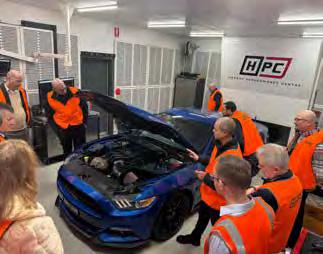
On 21 August, AMTIL hosted the National Manufacturing Technology Skills Summit at the National Press Club in Canberra. The event brought together 40 organisations from across industry, education, government, and associations to tackle one of the most pressing challenges facing Australian manufacturing: the shortage of CNC (Computer Numerical Control) operators.
With over 1,000 roles currently unfilled, and projections suggesting that number could triple within two years, the summit focused on developing a coordinated, actionable plan to address the crisis.
“The CNC skills shortage is not just a workforce issue, it’s a national opportunity,” said Lorraine Maxwell, chief executive of AMTIL. “By bringing together industry, education, and government, we’re laying the foundation for a coordinated response that will strengthen Australia’s manufacturing capability for years to come.”
Facilitated by the Victorian Skills Authority, the summit’s collaborative approach helped map out the causes of the shortage and identify potential solutions.
A forthcoming Summit Report will capture key findings and recommendations, forming the basis of a national action plan.
AMTIL’s Annual General Meeting will be held on Wednesday, October 29 at Bosch Australia in Clayton, Victoria. The AGM is a key moment for reflection, recognition, and strategic planning. Members will review achievements from 2024–2025, vote on proposed constitution changes, and hear a keynote presentation from Kristina Clifton, economist at the Commonwealth Bank of Australia.
The AGM offers members a chance to reflect on the year’s achievements and contribute to the direction of AMTIL’s future initiatives. It’s a valuable moment for engagement, collaboration, and shared vision.
The AGM will also recognise members celebrating 10 and 20-year milestones. The event will be livestreamed, allowing broader participation from members across the country. AMTIL membership connects you to a powerful network of manufacturing professionals, offering exclusive access to industry insights, events, training, and advocacy that help your business grow and stay competitive. For more information, contact info@amtil.com.au or 0431 567 227.
AMTIL is also preparing for Australian Manufacturing Week (AMW) 2026, which will be held at the Brisbane Convention and Exhibition Centre (BCEC) from 12-14 May, 2026. This marks the first time the show has been held in Queensland, offering a fresh opportunity to engage with the region’s vibrant manufacturing community.
AMW is Australia’s leading event for the manufacturing industry, providing an unrivalled platform to explore the latest technologies, discover new solutions, and connect with potential collaborators and customers.
With a format similar to the successful 2025 show, AMW 2026 promises to deliver valuable insights, networking opportunities, and a showcase of innovation that reflects the strength and diversity of Australian manufacturing.

AMTIL membership is more than a transaction, it’s a strategic investment in your organisation’s future. Members gain access to a national network of innovators, leaders, and changemakers, along with opportunities to influence policy, stay ahead of industry trends, and participate in exclusive events that foster growth and collaboration.
Whether it’s through technical workshops, strategic summits, or peer-to-peer learning, AMTIL provides the platform and support to help your business thrive. For many members, the value is felt not just in cost savings or visibility, but in the longterm relationships and insights that shape their success.

3D Systems delivers leading additive manufacturing solutions and expertise to advance applications and industries. As a full-service solutions partner, the company delivers industry-leading 3D printing technologies, materials and software to high-value markets such as medical and dental; aerospace, space and defence; transportation and motorsports; AI infrastructure; and durable goods.
3D SYSTEMS
PO Box 108, FOREST HILL, VIC, 3131 3dsystems.com

Adept360 Tech Pty Ltd specialises in implementing on-premises and cloud based industry solutions powered by Microsoft Dynamics 365. Its operations include perceptive processes discovery, offering deliberate design and deployment solutions with customised support. Adept360 uses its knowledge from two decades of ERP solutions consulting and services across industries and geographies.
ADEPT360 TECH
Level 21, 567 Collins Street, MELBOURNE, VIC, 3000 adept360.com.au

Perth-based Alphaweld is a supplier of welding equipment to industries including, but not limited to: petrochemicals, offshore, power generation, boilers, ship building and repair, oil refineries, utilities and heat exchange manufacture and repair. With over 60 years of combined technical knowledge, Alphaweld makes sourcing ‘easy’, with many brands in stock.
ALPHAWELD SUPPLY GROUP
9 Barrel Way, CANNINGVALE, WA, 6155 alphaweld.com.au

Bordo Industrial Tools provides high quality industrial cutting tools and accessories to customers across Australia. Proud to be a wholly family-owned Australian company, Bordo sources products from the world’s leading manufacturers, ensuring reliability and performance in every tool it offers.
BORDO INDUSTRIAL TOOLS
3 Kingston Park Court, KNOXFIELD, VIC, 3180 bordo.com.au

Chain Systems Australia is the exclusive supplier of Brevetti Stendalto cable chains in Australia and New Zealand. The team has the technical know-how to provide a complete solution that will exceed specific automation requirements across industries including manufacturing and process, mining, offshore drilling, oil and gas, ports and stage technology.
CHAIN SYSTEMS AUSTRALIA
1/63 Forsyth Street, O’CONNOR, WA, 6163 chainsystems.com.au

Dixon Industries designs and manufactures butt fusion equipment, with a reputation for excellence of engineering, ease of use and durability in tough conditions. Its FUSIONMASTER® brand has become the first choice of Australian polyethylene pipe installers in mining, natural gas, water, irrigation, aquaculture, telecom and civil installations.
DIXON INDUSTRIES PTY LTD
17 Frederick Road, ROYAL PARK, SA, 5014 dixonind.com.au

At Dragos, our mission is to protect the critical industrial infrastructure through comprehensive cybersecurity. We analyse every aspect of your manufacturing ecosystem—from support systems and quality control to material handling and automation technologies. We deliver tailored solutions, anticipate vulnerabilities and respond to cyber events quickly to minimise disruption.
DRAGOS
Level 4, 3 Newton Street, CREMORNE, VIC 3122 dragos.com

ELMO Software’s modular HR and payroll platform streamlines workforce management, strengthens compliance, and scales with your manufacturing operations. Built for local needs, ELMO integrates with payroll systems, ensures accurate reporting, and supports ISO-certified security. With expert-led onboarding and local support, the team stays with you every step of the way.
ELMO SOFTWARE
Level 27, 580 George Street, SYDNEY, NSW 2000 elmosoftware.com.au

Flow Power is one of Australia’s fastest-growing electricity providers for residential and small businesses, driving energy innovation towards one shared vision: Creating the renewable energy future, together.
FLOW POWER
Ground Floor, 109 Burwood Road, HAWTHORN, VIC, 3122 flowpower.com.au

FLOW-3D is a powerful modelling tool that gives engineers insight into physical flow processes, including free-surface flows. FLOW-3D has specific products for simulating welding (FLOW-3D WELD) and additive manufacturing processes (FLOW-3D AM) to model material behaviours during melting and solidification accurately, helping engineers predict critical defects and optimise process parameters.
FLOW SCIENCE AUSTRALASIA PTY LTD
15 Larwill Avenue, NORTHGATE, QLD 4013 flow3d.com

Hyperion Systems conducts Large Format Additive Manufacturing
– an advanced 3D printing process that produces sizeable, highquality components with speed and precision for sectors like marine, construction, defence and education. Through localised production, recycling and collaboration with academia and industry, it minimises waste, shortens supply chains and fosters a circular economy.
HYPERION SYSTEMS
20 Egemont Road, HENDERSON, WA, 6166 Hyperionsystems.com.au

An Australian-owned metalworking and steel fabrication machinery supplier that specialises in CNC laser cutting machines, bandsaws, beam drilling and coping lines, press brakes, guillotines, dot-peen marking systems, and more. IMS is the official representative for leading global brands including Daito, AORE, Accurl, Imet, Rollout Racks, Technomark and Cosen.
INDUSTRIAL MACHINERY SALES & SERVICE
1, 12-14 Tikalara Street, REGENCY PARK, SA 5010 industrialmachinery.net.au

KUKA is a leading supplier of intelligent, resource-saving automation solutions, like industrial robots, autonomous mobile robots (AMR) including controllers, software and cloud-based digital services as well as fully connected production systems for industries including automotive, electronics, metal and plastic, consumer goods, food, e-commerce, retail and healthcare.
KUKA ROBOTICS AUSTRALIA
25 Kingsley Close, ROWVILLE, Vic, 3178 kuka.com

Mitutoyo Oceania offers a comprehensive range of precision measuring equipment, including Micrometers, Calipers, Indicator, Linear Height Gage, Digital Scale and DRO, Data ManagementSPC to Hardness Testing Systems, FORM Measurements, Optical Measuring, 3D Coordinate Measuring Machines and Vision Measuring Systems.
MTI QUALOS
55 Northern Road, WEST HEIDELBERG, VIC, 3018 au.mitutoyo.com.sg/au-en/product

Odoo has developed a range of easy-to-use business software applications forming a complete suite of tools for any business need. It has 50 applications that are regularly upgraded and a community of more than 1500 active members who have contributed to another 50,000+ apps to cover a variety of needs.
ODOO
169 Varsity Parade, VARSITY LAKES, QLD, 4227 odoo.com

NetSuite is a unified, cloud-based business management platform that helps over 41,000 customers automate core processes and gain real-time visibility into operational and financial performance. Leading manufacturers rely on NetSuite to manage every aspect of their operations, from financials and inventory to customers, procurement, staff scheduling, logistics, and point-of-sale.
ORACLE CORPORATION AUSTRALIA PTY LIMITED
417 St Kilda Road, MELBOURNE, VIC 3004 netsuite.com.au

Almost every project will need specialty closed cell foam for protection and other purposes. We cut, laminate, heat press, sculpt, spilt, router and profile foam to any specification, 2D or 3D design, with 29 years of experience, stocking our range of closed cell foams and other closed cell foam brands.
PJ BOWERS
13 Central Drive, BURLEIGH HEADS, QLD 4220 pjbowers.com.au

Whiteboard Business Consulting Services specialises in performance evaluation, strategic planning and valuation for small and medium-sized enterprises (SMEs). Its expertise includes business performance and health assessments, strategic planning and execution support, value enhancement for owner succession and exit preparation and board advisory services, among others.
WHITEBOARD BUSINESS CONSULTING SERVICES
19 Rondelay Drive, CASTLE HILL, NSW, 2154 whiteboardconsulting.com.au

Sorensen Engineering’s state-of-the-art facilities are equipped with the latest CNC machining technology, and incorporate AI and robotics into its production processes. Its highly skilled team works closely with clients from initial concept through to full-scale production to ensure that high quality components are delivered on time, every time.
SORENSEN ENGINEERING
43 Orchard Road, BROOKVALE, NSW, 2100 sorensenengineering.com.au

Now a member of Nippon Sanso Nippon Sanso, Coregas provides gases and equipment for Industrial, Healthcare and Liquefied and process gas applications. From single cylinders to cylinder packs and on-site vessels of common and rare gases and gas mixtures, Coregas provides as much gas as needed as often as necessary.
COREGAS
66 Loftus Road, YENNORA, NSW, 2161 coregas.com.au
WESTEC 2025
USA, Anaheim, CA 7-9 October 2025 westeconline.com
NEXTECH WEEK TOKYO – AUTUMN
JAPAN, Makuhari Messe 8-10 October 2025 nextech-week.jp
ADVANCED DESIGN & MANUFACTURING EXPO
CANADA, Toronto 21-23 October 2025 admtoronto.com
WARSAW INDUSTRY WEEK
POLAND, Ptak 4-6 November 2025 industryweek.pl
FORMNEXT 2025
GERMANY, Frankfurt 18-21 November 2025 formnext.mesago.com/frankfurt/en.html
METAL MADRID
SPAIN, Madrid 5-6 November 2025 advancedmanufacturingmadrid.com
METALEX
THAILAND, Bangkok 19-22 November 2025 metalex.co.th
MANFACTURING INDONESIA
INDONESIA, Kemayoran 3-6 December 2025 manufacturingindonesia.com
SEMICON JAPAN
JAPAN, Tokyo 17-19 December 2025 semiconjapan.org/en 2026
STEELFAB
UAE, Sharjah 12-15 January 2026 steelfabme.com
EUROGUSS
GERMANY, Nuremberg 13-15 January 2026 euroguss.de
MD&M WEST
USA, Anaheim 3-5 February 2026 mdmwest.com
KONEPAJA
FINLAND, Tampere 17-19 March 2026 konepajamessut.fi
INTERTOOL
AUSTRIA, Vienna 1 April 2026 intertool.at
MANUFACTURING WORLD NAGOYA
JAPAN, Nagoya 8-10 April 2026 manufacturing-world.jp/nagoya
INTERMOLD ASIA
JAPAN, Osaka 20-22 April 2026 Intermold.jp
MACH 2026
UK, Birmingham 20-24 April 2026 machexhibition.com
INTERPLAS
UK, Birmingham 2-4 June 2026 interplasuk.com
IMTS
USA, Chicago 14-19 September 2026 imts.com
35.BI-MU 2026
ITALY, Milan 13-16 October 2026 bimu.it
EUROBLECH 2026
GERMANY, Hanover 20-23 October 2026 euroblech.com
JIMTOF 2026
JAPAN, Tokyo 26-31 October 2026 jimtof.org
PLAST IMAGEN
MEXICO, Mexico City 10-13 November 2026 plastimagen.com.mx
ADVANCED DESIGN & MANUFACTURING EXPO
CANADA, Montreal 11-12 November 2026 admmontreal.com
WORLD STAINLESS STEEL NETHERLANDS, Maastricht 18-20 November 2025 stainless-steel-world-event.com
METEC INDIA
INDIA, Mumbai 30 Nov – 2 Dec 2026 metec-india.com
EAST MANUFACTURING TECHNOLOGY SERIES
USA, West Springfield 11-13 May 2027 east.mtseries.com
METEC GERMANY
GERMANY, Dusseldorf 21-25 June, 2027 metec-tradefair.com
NEWCAST
GERMANY, Dusseldorf 21-25 June 2027 newcast.de

INTERNATIONAL MINING & RESOURCES CONFERENCE & EXPO (IMARC)
ICC, SYDNEY
21-23 OCTOBER 2025
The International Mining and Resources Conference (IMARC) is where the most influential people in the mining industry come together, delivering ideas, inspiration and serving as a meeting ground for industry leaders. Learn from more than 600+ mining leaders and resource experts throughout seven concurrent conferences with a program covering the entire mining value chain. Attend one of the many networking events or simply catch up with industry colleagues on the 20,000 square metre expo show floor featuring 500+ leading companies.
imarcglobal.com
WASTE EXPO AUSTRALIA MELBOURNE CONVENTION & EXHIBITION CENTRE
29-30 OCTOBER 2025
Waste Expo Australia provides a platform dedicated to advancing best practices in waste management and making a positive difference to the environment and community. This free-toattend event brings together the largest gathering of waste management and resource recovery professionals in the country, offering invaluable opportunities to explore innovative material usage, enhance recovery processes, and minimise landfill waste. wasteexpoaustralia.com.au
AUSRAIL GOLD COAST CONVENTION & EXHIBITION CENTRE
25-28 NOVEMBER 2025
AusRAIL 2025 provides an unparalleled opportunity to connect with industry leaders and strengthen your brand position in the Australian and New Zealand Rail industry. Demonstrate your leadership and innovation in rail and show your support for the growth and success of our industry. ausrail.com
DIGITAL BUILT WORLD SUMMIT 2026
DOLTONE HOUSE, DARLING ISLAND, SYDNEY
4-5 MARCH 2026
The Summit will explore how advanced digital technologies can be integrated into the entire lifecycle of the built environment, from design and construction to operation and maintenance. It encompasses digital twins, AI, BIM, data analytics, automation, and smart infrastructure to enhance efficiency, sustainability, and decision-making for AECs and clients. The event covers ROI strategies, digital decision-making, AI integration, workforce development, and industry collaboration. digitalbuiltworldsummit.com
AUSTRALIAN MANUFACTURING WEEK (AMW) 2026
BRISBANE CONVENTION & EXHIBITION CENTRE
12-14 MAY, 2026
The ONE event that showcases the latest innovations, technologies and equipment in the advanced manufacturing sector. Explore new opportunities, meet and network with industry leaders and technology experts, all under ONE roof at ONE show.
australianmanufacturingweek.com.au
FOODPRO
MELBOURNE CONVENTION & EXHIBITION CENTRE
26-29 JULY 2026
Eight zones, each dedicated to the various steps in the food manufacturing process: ingredients, Food Science & Technology, Processing Equipment, Plant Equipment, Packaging and more. foodproexh.com
Talk directly to your audience via Australia’s
There has never been a more important time to ensure you are well marketed to industry and ready when opportunities open up.
Reach out to 31,500 targeted readers and key decision-makers.
To learn more about AMT and how AMTIL can help, email amt@amtil.com.au.



It seemed like many people wanted me to design and build Australia’s new car.
Jensen was very understanding. “Yes, you’ve had a very, very exhausting six years. I know only too well about that. Was there ever any man doing more things at the one time than you? But before your holiday, I think you should see the Prime Minister,” he said. “I know he would want to talk with you. I think if you went to Canberra, he'd be very pleased.”
A few days later, I talked with Chifley, the Prime Minister. He was an amazing man. He was rugged, a tough adversary, and a very good friend. A man completely without affectation, he could see the facts of a situation immediately. He was a great Australian and a natural leader.
He sat at his desk while I briefly explained my decision to resign. Then he said, “You know, I forecasted this would happen. I told you they wouldn’t have you, a non-American, running an American outfit of this dimension in a foreign country. What are you going to do now?”
I told him I hadn’t made up my mind.
Chifley said straight up that Australia ought to have another car. “You know Larry, a monopoly is never a healthy thing to have, particularly”, he grinned, “if the Government does not run it!”
He went on. “I’ve got some reservations about GM-H. Obviously, it will be very much an American show in the future. That’s the difference now. We had a peculiar combination in you: a man fanatically pro-Australian running a large American investment. That was a very useful compromise to us, but now, with the show becoming all-American, the problem we're going to be up against is that they’ll design and make cars as they think we should have them. They might be right–I don't know–but it is always good to tell your tailor how you want your suit made or a builder how your house should go up without having the ideas of people in another country thrust on you.
“And the other consideration is defence. There are times in national affairs when motor vehicles of certain types should be available when we want them, and motor car factories have proved themselves very adept in making munitions in times of war.
“And then there’s the price factor. To an American in America, what might appear to be a fair price for Australia could be a killer for us. Yes, it would be a good idea if you thought about making another car.
And then he said something I will always treasure: “It would be hard to find anyone who has done so much for Australia in such a relatively short time. I watched you, with pleasure, in Munitions and worked alongside you for two years when the Ordnance Production Directorate began. I know some people have criticised you, but nobody's ever been able to assail you.
You’ve steered a good, clean, straight course.
''You know the Labour Party doesn't grant honours, but if we had a scroll of men whom we in our movement consider have done a fme job for this country, you'd be one at the top of it."
As he approached the door, he said, “There's plenty for you to do in Australia, and I'm sure you'll do it, too. When you are ready to

get going again, let me know, and you will receive support.” I valued those remarks of Ben Chifley. I still remember them with pleasure and not a little pride.
All I could think of was a holiday, the long, long, delayed holiday I'd promised my wife and family, which had been interrupted by six years of war. Thoughts of business, the future, cars, everything–were put right out of my mind. This was going to be a complete break.
The cruise we took to England was part of my contractual agreement with General Motors. Under the terms of my engagement, they were obliged to send me back to England with my family every three years while I was stationed in Australia. In this instance, GM paid the fares, and I carried the rest. This was the last trip we would have on General Motors. It was a very crowded ship, but the girls loved it. We settled down to enjoy ourselves. As we crossed the Indian Ocean under the tropical sun, General Motors, Ed Riley, the office, and the future seemed unimportant. And then someone handed me a copy of the ship's news sheet. There, on the front page, under a Canberra dateline, was a news item: “The Government announced today that Mr. L. J. Hartnett, the former managing director of General Motors-Holden, will manufacture a small motor-car in Australia.” I read it, amazed, and then wandered into the smoke-room. Everybody started asking me questions. “What's the car going to be like? Is it your own design? When will you bring it out? I told them I didn't know.
I'm sure none of them believed me.
I sent a radio message to a friend in Canberra, asking him what it was all about. He replied that the Prime Minister was ‘confident’ I would do something about it and had made all the necessary arrangements. Well, this was supposed to be my holiday!
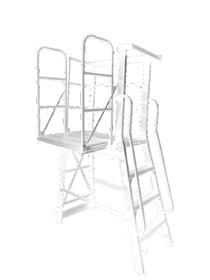
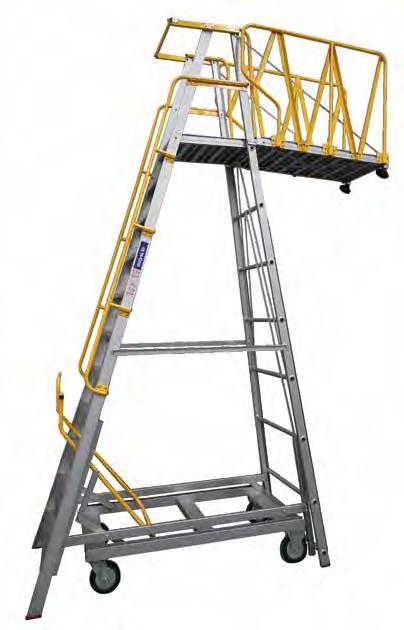

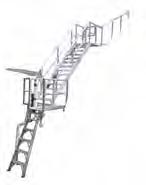
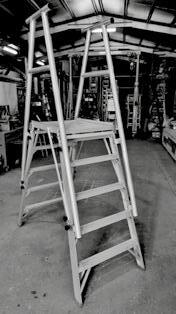

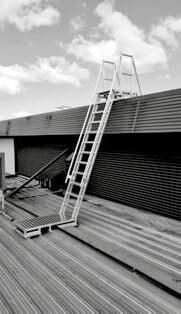
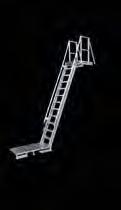

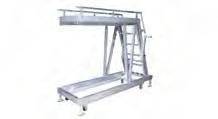


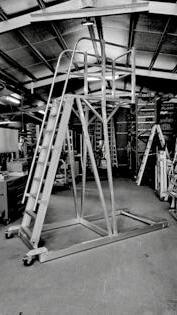
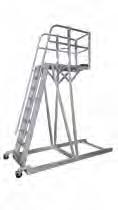



William Buck specialise in providing accounting and advisory services specifically designed for the manufacturing industry. With our expertise and tailored approach, we can help your business navigate through various stages, from start up to growth and maturity, ensuring financial success and sustainability at every step.
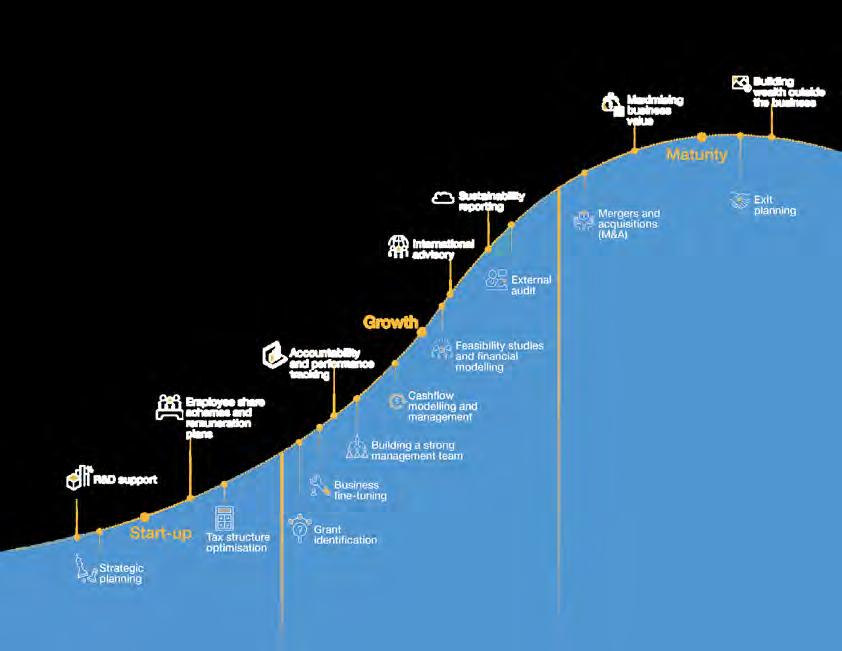
Get in touch for a complimentary consultation with a Manufacturing specialist advisor

